

Exclusive first ride review of the 2023 Trek Madone SLR 9 Gen 7 – Trek’s aero comfort revolution?

After introducing the 2023 Trek Madone SLR with its unique look and promising updates, we couldn’t wait to put it to the test. We’ve now had the exclusive chance to swing our legs over the € 15,699 Trek Madone SLR 9 eTap Gen 7. Read on to find out how the new aero bike fares with the reduced weight and complexity of the IsoFlow system.

Trek claim to have developed their fastest bike yet with the all-new 2023 Madone SLR, and caused an uproar in the community while they were at it. When the first photos of the 2023 Trek Madone SLR at the Critérium du Dauphiné went live, the online community went nuts. The reactions ran the gamut from “that’s definitely a mad one” all the way to “at first I thought it was a joke, sadly it wasn’t.” There was a lot of speculation, but now we’ve finally got the first in-depth test results.
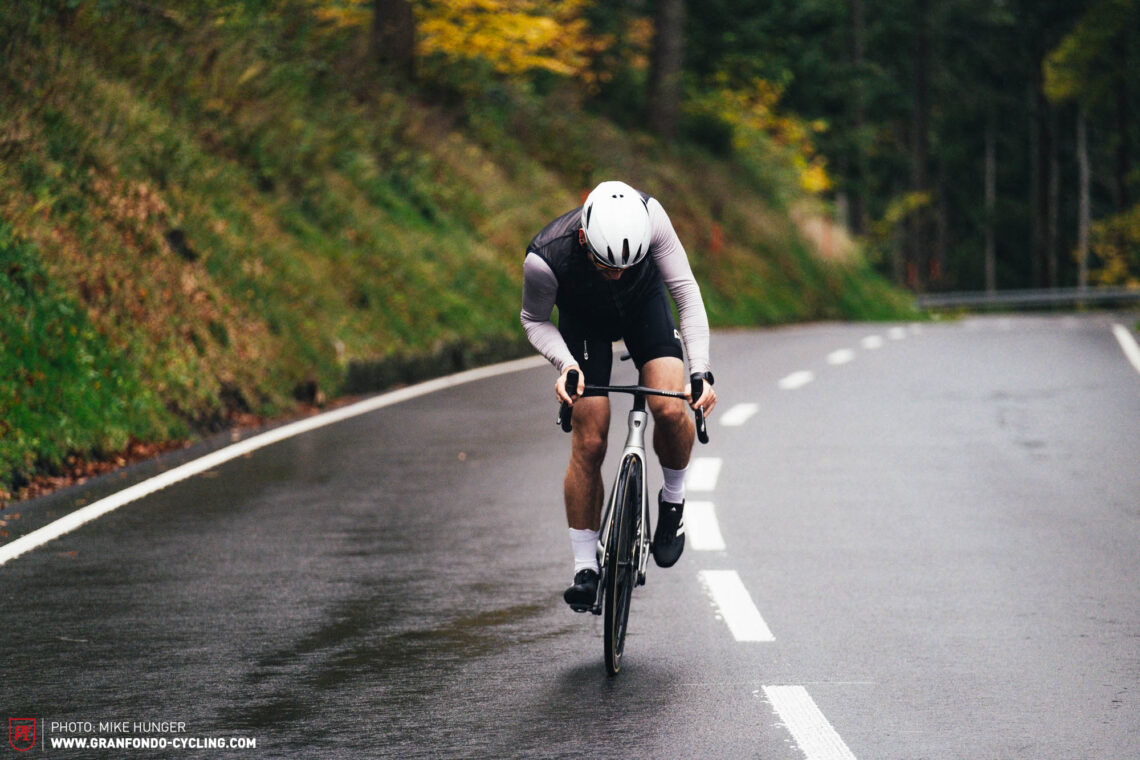
The 2023 Trek Madone SLR Disc is more than just a looker with its radical design and all-new IsoFlow system. The American brand promise a wide range of advantages and claim to have solved some of the issues of its predecessor. Trek have completely overhauled the existing IsoSpeed damping system, implemented several aero optimisations such as bigger aerodynamic compensation surfaces, according to the latest UCI regulations, and reduced the weight significantly. Besides the striking IsoFlow design, Trek obviously spec the bike with high-end components, including some from their in-house brand Bontrager, and offer deep customisation via the Project One configurator.
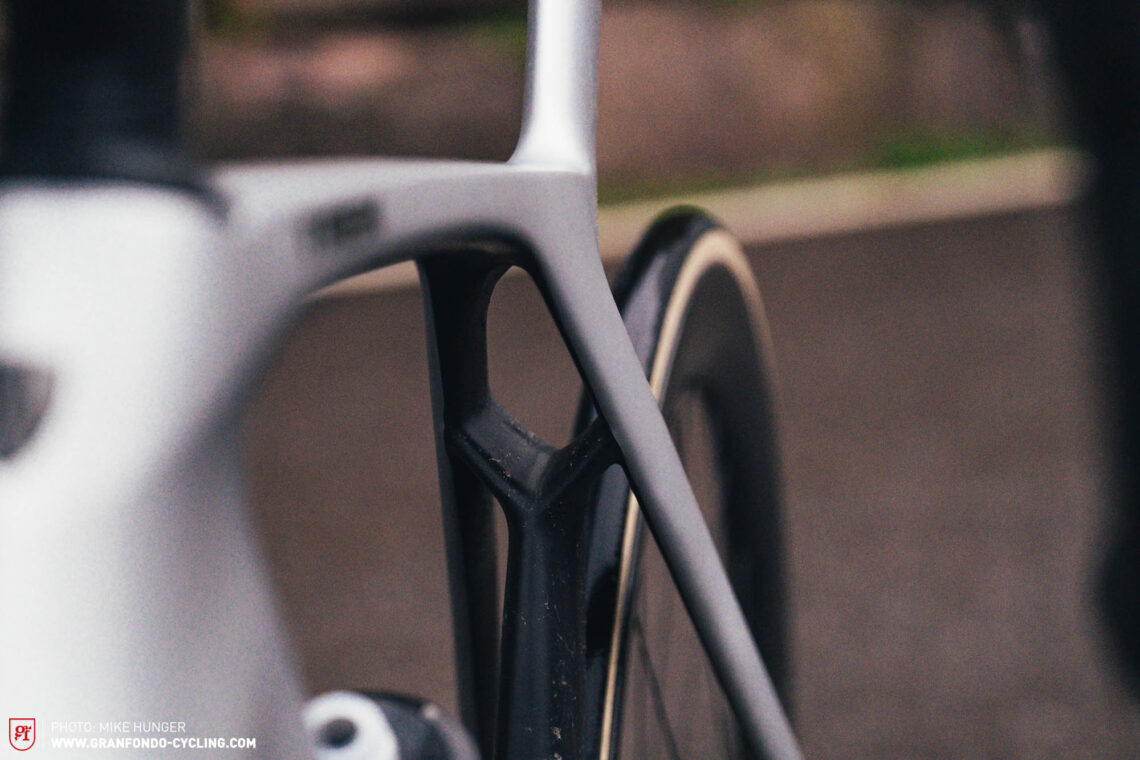
Trek IsoSpeed vs IsoFlow – An overview of the differences
Improved aerodynamics of the 2023 trek madone slr 9 etap gen 7.
It’s not just thanks to the new IsoFlow system that the aerodynamics of the 2023 Trek Madone SLR Disc have been improved, but also via the cockpit and therefore the position of the rider. After all, the rider produces the most wind resistance by far: riding on flat terrain, as much as 75% of the total drag is caused by the wind resistance of the rider, from speeds of just 15 km/h. So, there are a lot of gains to be made by optimising the position of the rider. As such, the handlebar of the Madone has been designed specifically for this bike, bringing the rider into an aerodynamically optimised position.
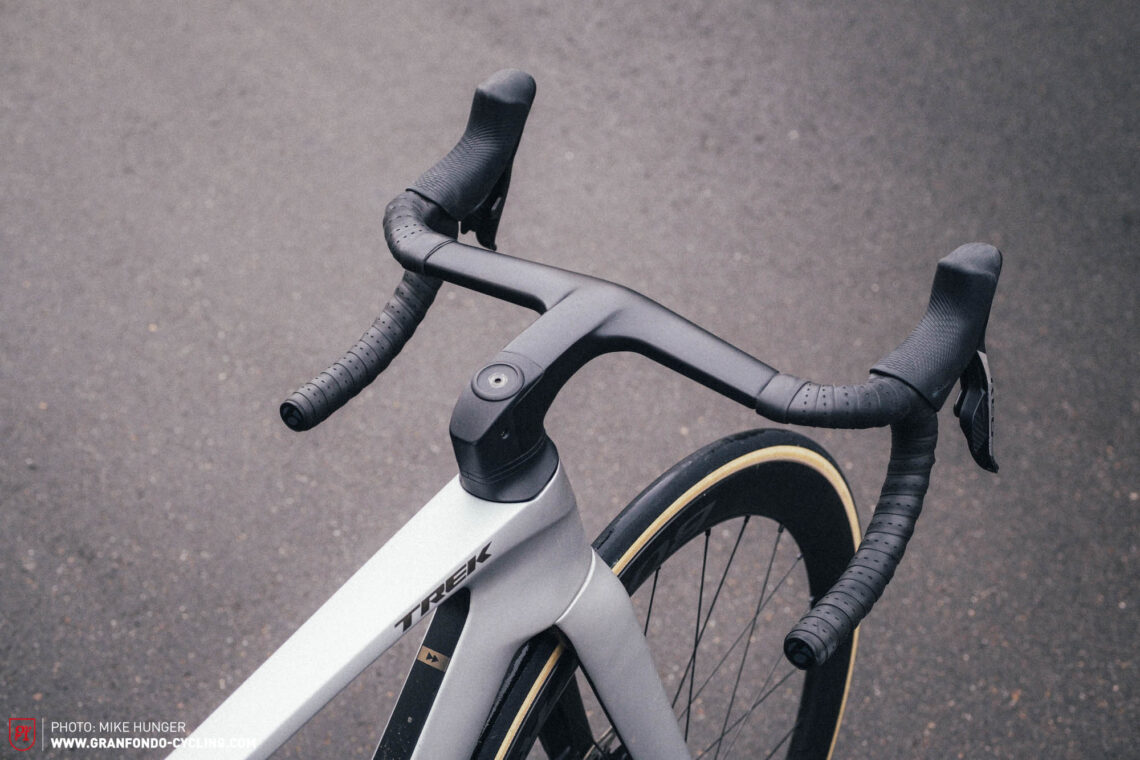
The slightly flared drops should offer improved control over the bike while also optimising the airflow over the rider’s thighs in order to reduce drag. Even the water bottles and the front mech have been integrated into the frame design, and the enlarged bottom bracket area takes advantage of the latest UCI regulations to further improve aerodynamics, like on the new Cérvelo S5 or SCOTT Foil RC .
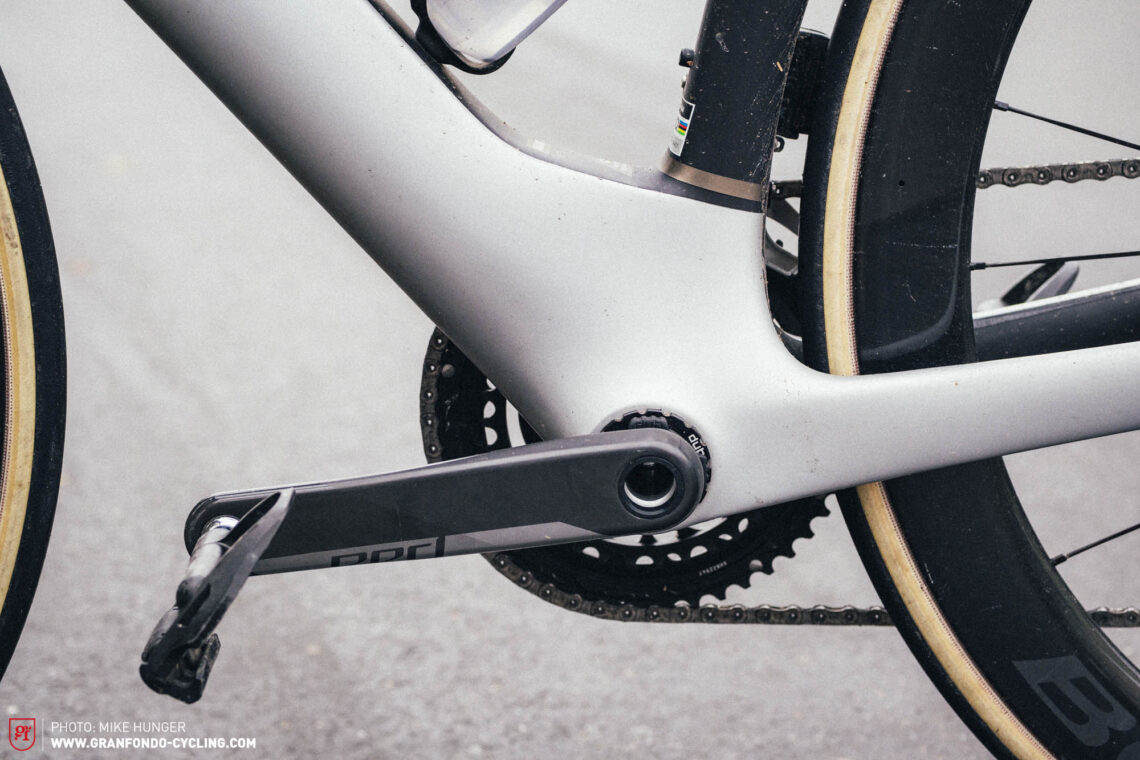
Trek have attempted to quantify the promised gains. Accordingly, the American brand claim to save 9.3 Watts with the bike’s improved aerodynamics, i.e. the new IsoFlow system, improved tube shapes and cockpit design (without the rider). The optimised rider position alone should save around 10 W, giving you total saving of 19 Watts at 45 km/h in the drops. All these figures are relative to the 6th generation Trek Madone.
Weight optimization – How much lighter is the 2023 Trek Madone SLR 9 eTap Gen 7?
As the predecessor, the 2023 Trek Madone SLR is made of OCLV 800, which is the highest grade carbon that Trek offer. The SLR 9 with the eTap groupset weighs in at just 7.36 kg in size 56, making the 2023 Madone SLR Disc the lightest Madone Disc on the market. In total, Trek say they’ve shaved off 300 g compared to the predecessor, which would be a significant weight reduction. However, the previous Trek Madone SLR 9 Disc Gen 6 we had on test tipped the scales at 7.63 kg in size 56, so the actual weight saving is quite a bit less at 230 g, and that’s compared to a bigger frame size.
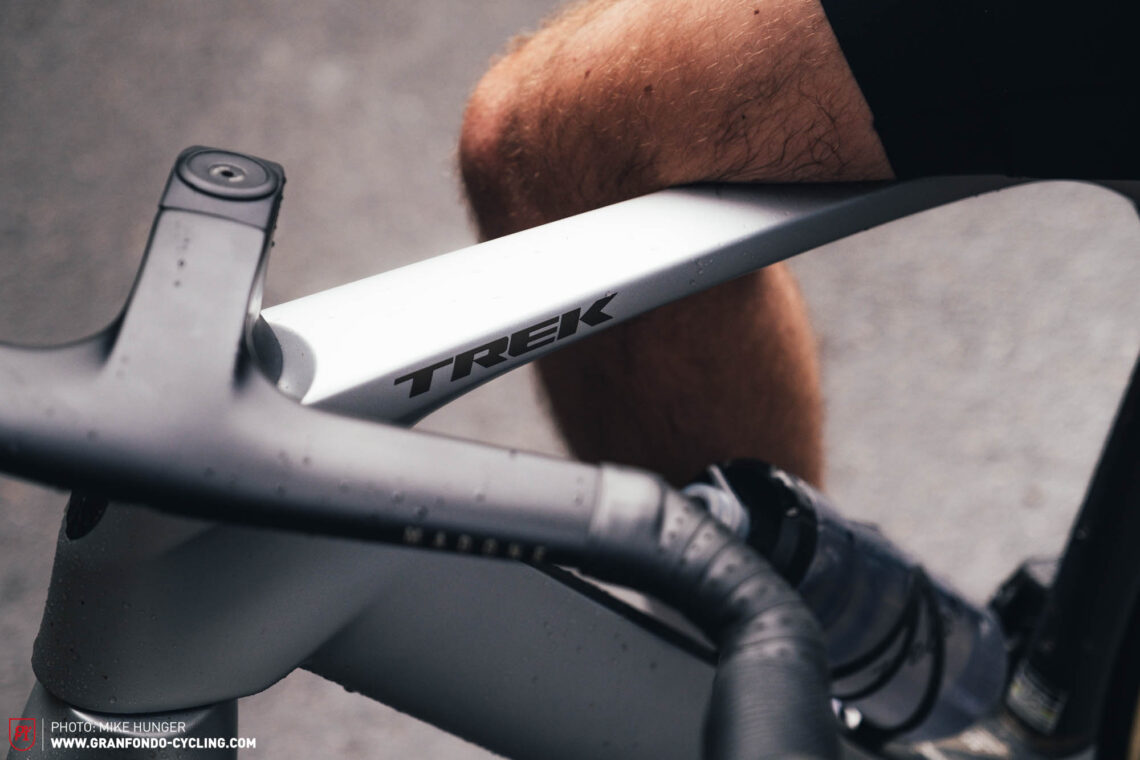
Of course, a large part of the weight reduction is down to the new IsoFlow system. Despite all their efforts, however, the Trek Émonda SLR 9 (review here) remains the lightest bike in Trek’s portfolio, weighing in at just 6.86 kg, though the latest generation of the Madone is steadily closing the gap. Whether you stand to gain more from aero or weight optimisation is heavily dependent on the elevation profile of the route, of course. On the climbs, you’ll benefit the most from the lower weight of the Émonda – especially the rotating mass of its wheels. The Madone, on the other hand, can play to its strengths on flat stages and descents.

300 g lighter than its predecessor – the lightest Madone yet.
The 2023 Trek Madone SLR in detail and models variants
The 2023 Madone SLR Disc is available in 6 different models with prices ranging from € 8,199 to € 15,699. If none of the standard models meet your demands, you can let your creativity run wild and even adorn your bike with gold leaf in Trek’s Project One configurator. The new, 7th generation Trek Madone SLR is exclusively available with electronic groupsets. You can choose pretty much freely between SRAM and Shimano, though. From SRAM, Trek offer the Rival eTap AXS, Force eTap AXS and RED eTap AXS groupsets, or the corresponding 105 R7170, ULTEGRA R8170 Di2, or DURA-ACE R9270 Di2 options from Shimano. All the SRAM equipped models also come with an integrated power metre in the cranks. Only the SL models will be available with mechanical groupsets. The SL models will also continue to rely on the old, 6th generation Madone frame featuring the IsoSpeed system, and a different carbon layup. As such, the new IsoFlow technology is reserved for the SLR range for the time being.
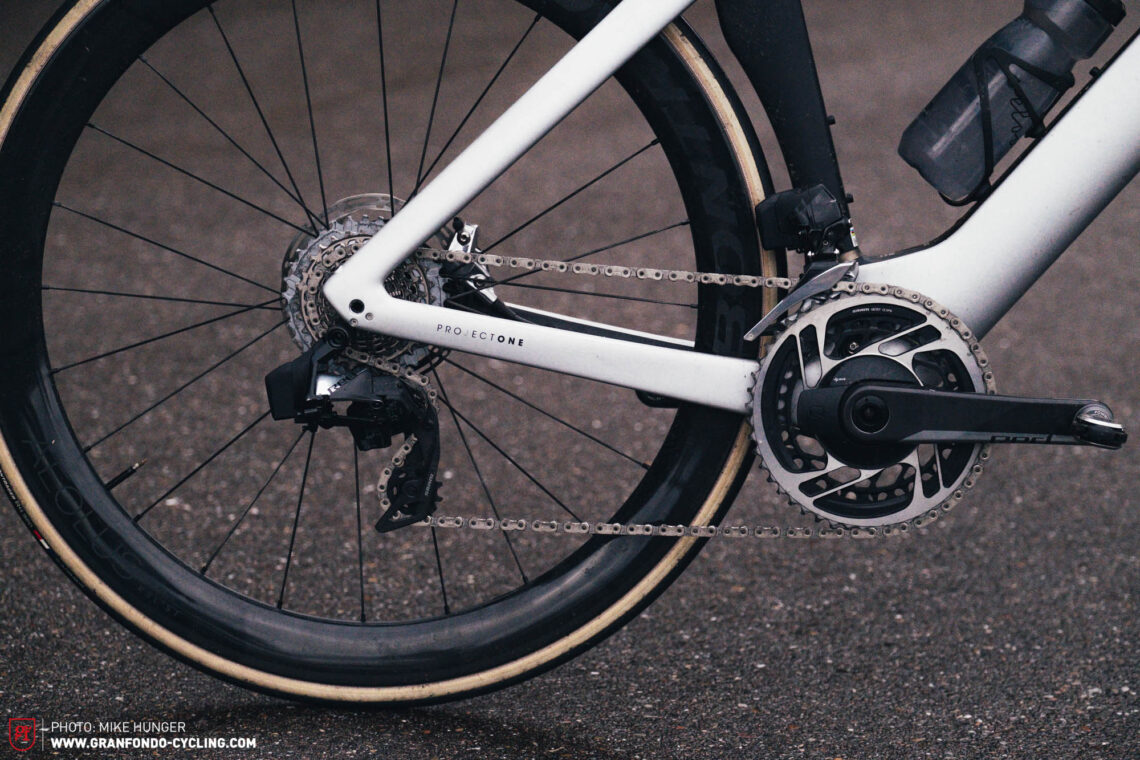
Supplied in-house, the 25 mm Bontrager R4 tires keep the bike grounded. These are fitted to Bontrager Aeolus RSL wheels with a rim depth of 51 mm, which, unlike the R4 tires, are tubeless-ready. Before converting to a tubeless setup, therefore, you won’t just need tubeless valves and sealant, but also new tires. Trek recommend a maximum tire width of 28 mm, which they say should give you 6 mm clearance around the tires. If you want to make the most of this clearance and fit wider tires, it’s up to you to decide how far you want to risk pushing this limit. However, doing so isn’t officially Trek approved.
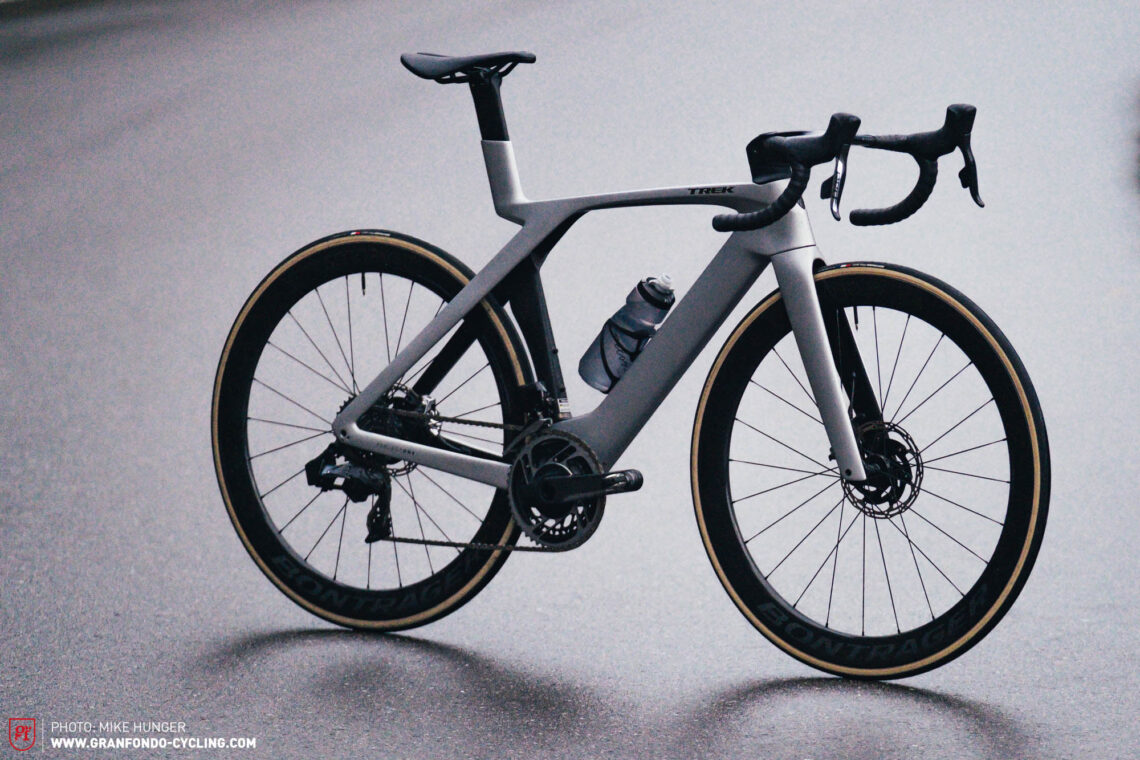
Trek Madone SLR 9 2023
Specifications.
Seatpost Madone 0 mm Brakes SRAM RED eTap AXS HRD 160/160 mm Drivetrain SRAM RED eTap AXS 2x12 Chainring 48/35 Stem Madone 90 mm Handlebar Madone 420 mm Wheelset Bontrager Aeolus RSL 51 12 x 100/12 x 142 mm Through Axle Tires Bontrager R4 700 x 25C 28 Cranks SRAM RED AXS Power Meter 172.5 mm Cassette SRAM XG-1290 10–33T
Technical Data
Size 47 50 52 54 56 58 60 62 Weight 7.4 kg
The seat post and handlebar are made especially for the 2023 Madone Disc. The seat posts are available in 4 different variants. Frame sizes 47 to 54 come with a short seat post whereas sizes 56 to 62 come with a long version. Adapting the seat post length according to the frame size is necessary since the seat mast is too short to offer a wide range of adjustability. By making the seat post clamp reversible, Trek were able to maximise the adjustment range, allowing you to adjust the saddle height by 70 mm with both the long and short seat post. Unlike our test bike, the seat post is colour matched, and it comes with 0 mm offset as standard, though there’s a 20 mm offset version available.

The cockpit of the 2023 Madone SLR Disc is made of one piece. Allowing you to dial in the fit, Trek offer 14 different sizes of the one-piece cockpit, which get specced according to the frame size or the customer’s request. If that still doesn’t let you get comfortable, you can fit any stem and handlebar combination you want, as long as it relies on a 31.8 mm clamp. All you need is a special headset cover. The stock bike features a big 160 mm rotor up front and rear, making sure there’s enough braking power. Nothing has changed with regards to the cable routing, remaining almost completely hidden – you can only see a short section of the brake lines peeping out just before they reach the callipers.
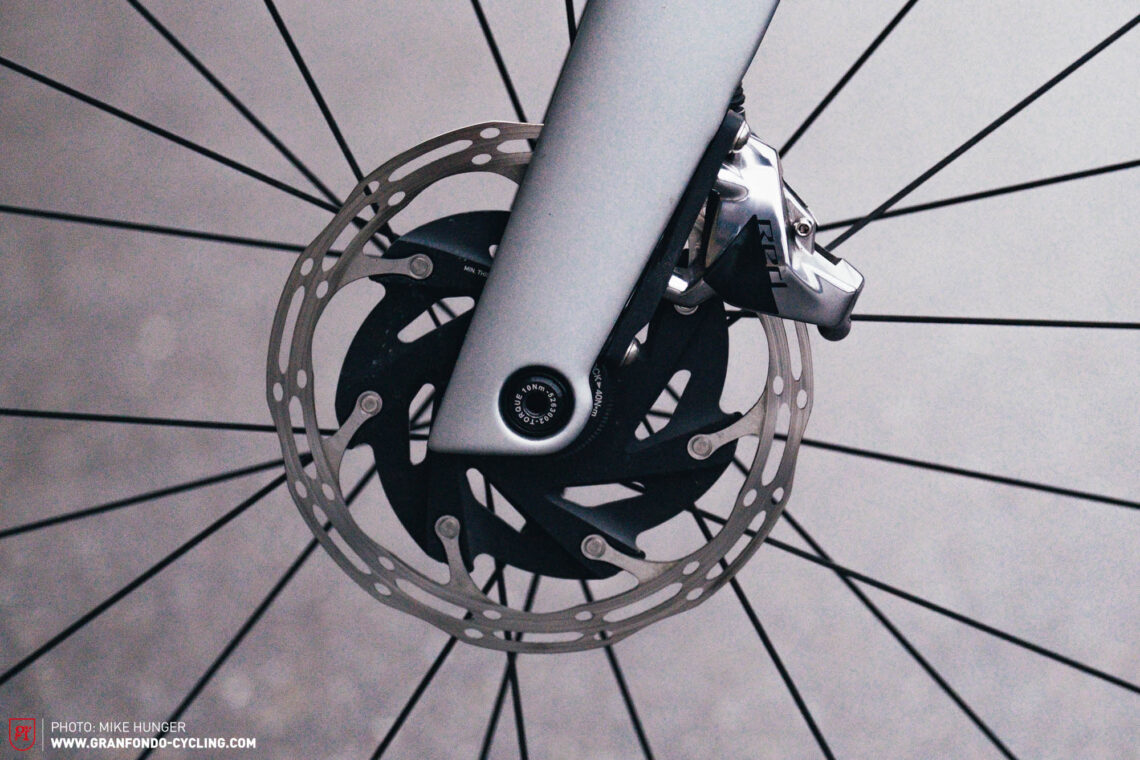
As before, the 2023 Trek Madone SLR Disc is compatible with Trek’s Blendr range of lights. There’s a front Blendr mount included with the bike. Unfortunately, you’ll have to buy the mount for the Madone SLR seat post separately – we would have preferred if it was the other way around. After all, you want to be seen by other road users first and foremost. Of course, if you’re going to be training or riding day and night and in all conditions, it’s best to have both. Since it’s reliable and easy to maintain, Trek remain true to the T47 bottom bracket standard. That said, the 2023 Trek Madone SLR Disc is also compatible with 30 mm crank axles – you must just make sure that you’re using the correct bearings.

The geometry of the 2023 Trek Madone SLR Disc
As before, Trek have gone with their “moderate” H1.5 geometry for the 2023 Trek Madone SLR Disc, which sits between the more aggressive H1.0 geometry and the H2.0 variant that they use for their endurance road models. The rider gets put into an aerodynamic position predominantly via the handlebar. The bike will be available in Trek’s usual 7 sizes, ranging from 47 to 62 cm.
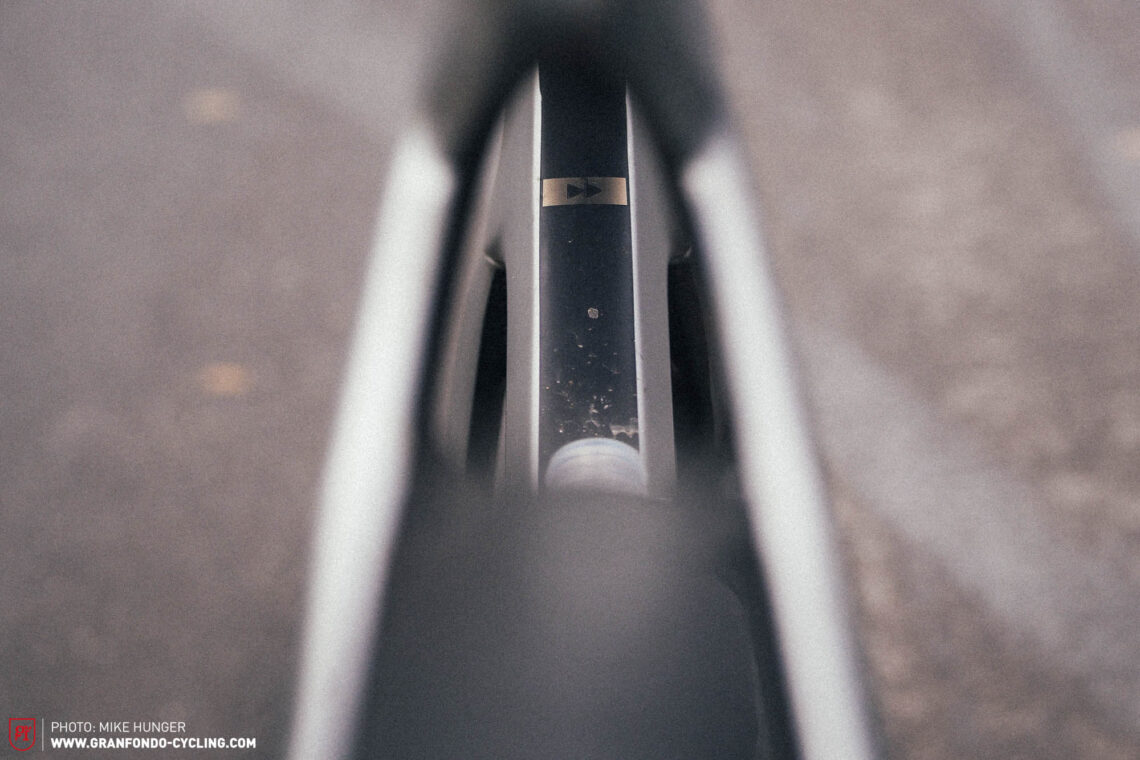
The 2023 Trek Madone SLR 9 eTap Gen 7 on the road – Our first ride review of the new IsoFlow aero machine
The 2023 Trek Madone SLR 9 eTap Gen 7 looks like it’s raring to go just standing there, looking like it’s in a continuous state of tension and striking a good balance between clean, simple lines and high-quality details – our high expectations of the bike were high. Once aboard the bike, you can feel the flex and pleasant level of compliance offered by the IsoFlow system. While it isn’t adjustable, the amount of flex changes depending on how far you’ve got the seat post sticking out – 77.5 cm in our case. It does a good job of filtering out small bumps, and even bigger impacts get mitigated by the bike before being passed on to the rider. There’s nothing to stop you from taking on longer tours on rough asphalt and poorly maintained roads. The comfort offered by the rear end stands somewhat in contrast to the stiff front end, only providing a bit of compliance when you’re in the drops – if you hit corrugations with your hands on the hoods, you’ll feel your teeth rattle.
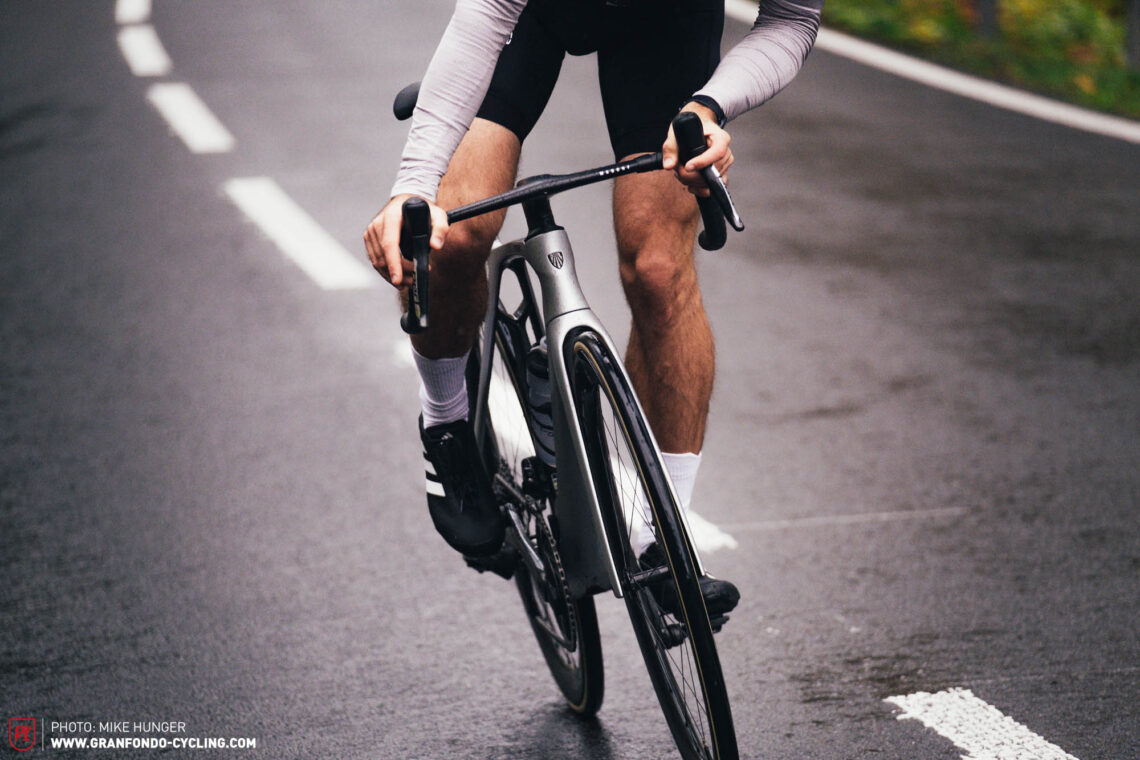
Cruising leisurely aboard the 2023 Trek Madone SLR 9 eTap Gen 7, you’ll quickly realise that that isn’t the bike’s forte. At slower speeds, the handling feels slightly nervous, and the front wheel tends to tip from side to side. This wasn’t an issue when winching our way up steep climbs, but it doesn’t instil you with confidence when rolling slowly up to a red traffic light as you wait for it to turn green. When get up out of the saddle and put the hammer down, however, the bike surges forward and begs for more. The stiff bottom bracket transfers your pedalling input with minimal losses, quickly propelling the bike up to cruising speed despite the deep and therefore relatively heavy 51 mm rims. Once you’re at your desired speed, the bike will hold that pace with ease, not least thanks to the ergonomically and aerodynamically shaped cockpit: the gentle back-sweep puts you in an aero position with your elbows tucked in while the flared drops offer plenty of control and a higher level of compliance. The rounded edges of the tops are pleasant to hold on to in case you feel like assuming a more upright position. Assume the aero position, though, and the 2023 Trek Madone SLR 9 eTap Gen 7 seems to crave speed, so much so that we feared running out of gears on flat terrain.

Once you’ve summited the peak and start heading downhill, the 2023 Trek Madone SLR 9 eTap Gen 7 really comes into its own. The handling feels planted and composed at high speeds, yet it remains responsive and precise enough for spontaneous corrections in the peloton or to swerve around a pothole that you didn’t see coming. Trek have struck an excellent balance with the bike’s handling at speed. The bike does get pushed sideways by crosswinds, but it does so evenly and remains easy to control. It doesn’t get jerked around and feel nervous at all! Only the tires tend to lose traction and slide out during hard braking manoeuvres on wet asphalt – we would have preferred a set of tubeless-ready 28 mm tires instead.
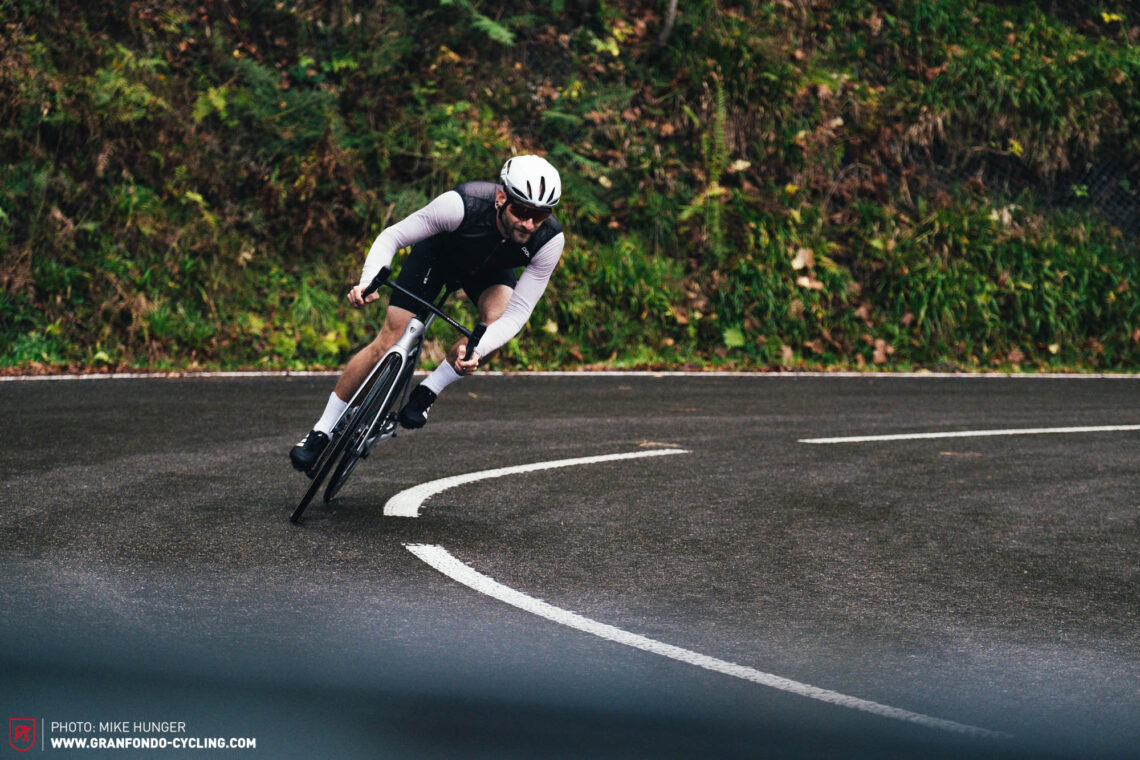
You can make the bike significantly more comfortable by fitting a pair of wider tires, though it’s an excellent all-rounder in the stock configuration, nonetheless. All in all, the 2023 Trek Madone SLR 9 eTap Gen 7 has become significantly more versatile: it’s become lighter and more aerodynamic, it’s a better climber and it’s less complex thanks to the new IsoFlow system, which is a boon for both home and pro mechanics. An (almost) complete all-rounder.
Who is the new 2023 Madone for?
Whether pro athlete or ambitious privateer, criterium or steep Alpine passes, the 2023 Madone Disc is aimed at those who have need for speed. If you know Trek, you will know that the SLR range isn’t aimed at the masses, but rather at pros and all those who dream of being one – assuming you’ve got the money. Still, the components make this aero bike a superb all-rounder for all those looking to save some Watts. If you prefer flying under the radar as you enjoy your training rides, the polarising design of the Madone clearly isn’t the right choice as other riders will try to quiz you about it wherever you go. That’s exactly what some riders want, so it all depends on the type of rider that you are. Want that race feeling, but far away from traffic and asphalt? Then check out our review of the 2023 Checkpoint SLR 7 with its integrated storage compartment (find the review here).
Tuning-Tipp: downsize for more comfort, due to the longer seat post extension | 28 mm tubeless tires

Our conclusion on the new 2023 Trek Madone SLR 9 eTap Gen 7
The updates made to the new 2023 Trek Madone SLR 9 eTap Gen 7 have made it significantly more versatile. It doesn’t just look damn fast; it is damn fast, too. And the handling remains responsive at high speeds without lacking in stability. The clever new IsoFlow system reduces the bike’s complexity while offering a similar level of compliance. As such, the new Trek Madone serves ambitious (hobby) racers well and has what it takes to get you on the podium.
- very balanced handling at high speeds
- reduced complexity and improved aerodynamics of the IsoFlow system
- customisation options thanks to the Project One configurator
- high-quality workmanship
- the damping of the IsoFlow system isn’t adjustable
- the Bontrager R4 tires lack grip
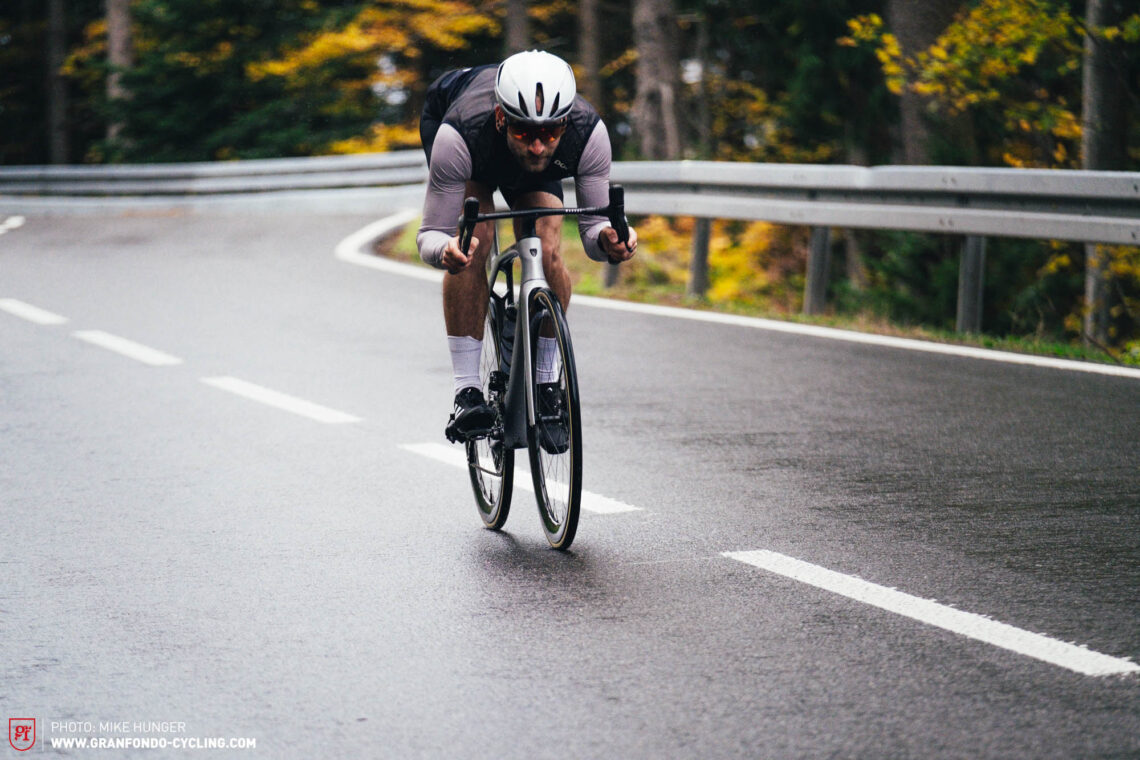
Did you enjoy this article? If so, we would be stoked if you decide to support us with a monthly contribution. By becoming a supporter of GRAN FONDO, you will help secure a sustainable future for high-quality cycling journalism. Click here to learn more .
Words: Julian Schwede Photos: Mike Hunger
You may also like
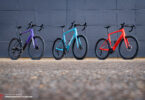
First Test of the BMC Roadmachine Line-Up 2024 – One Name, Three Bikes!
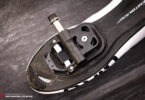
THE LAB – Magped ROAD2 – The magnetic alternative to clipless pedals

130 BPM – Riding under doctor’s orders
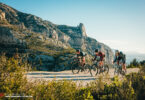
Gravel race bike Champions League 2024 – Canyon Grail vs MERIDA SILEX vs Ridley...
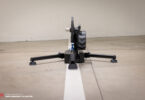
THE LAB – Wahoo KICKR MOVE smart trainer – You like to move it move it?
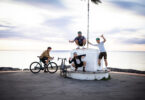
Vorfreude – the new GRAN FONDO issue #026 is here!
Mountainbike
- TFR Downhill
- TFR Cross Country
- Baloise-Trek
- TFR Triathlon
- Trek Ambassadors
- Regional teams and athletes
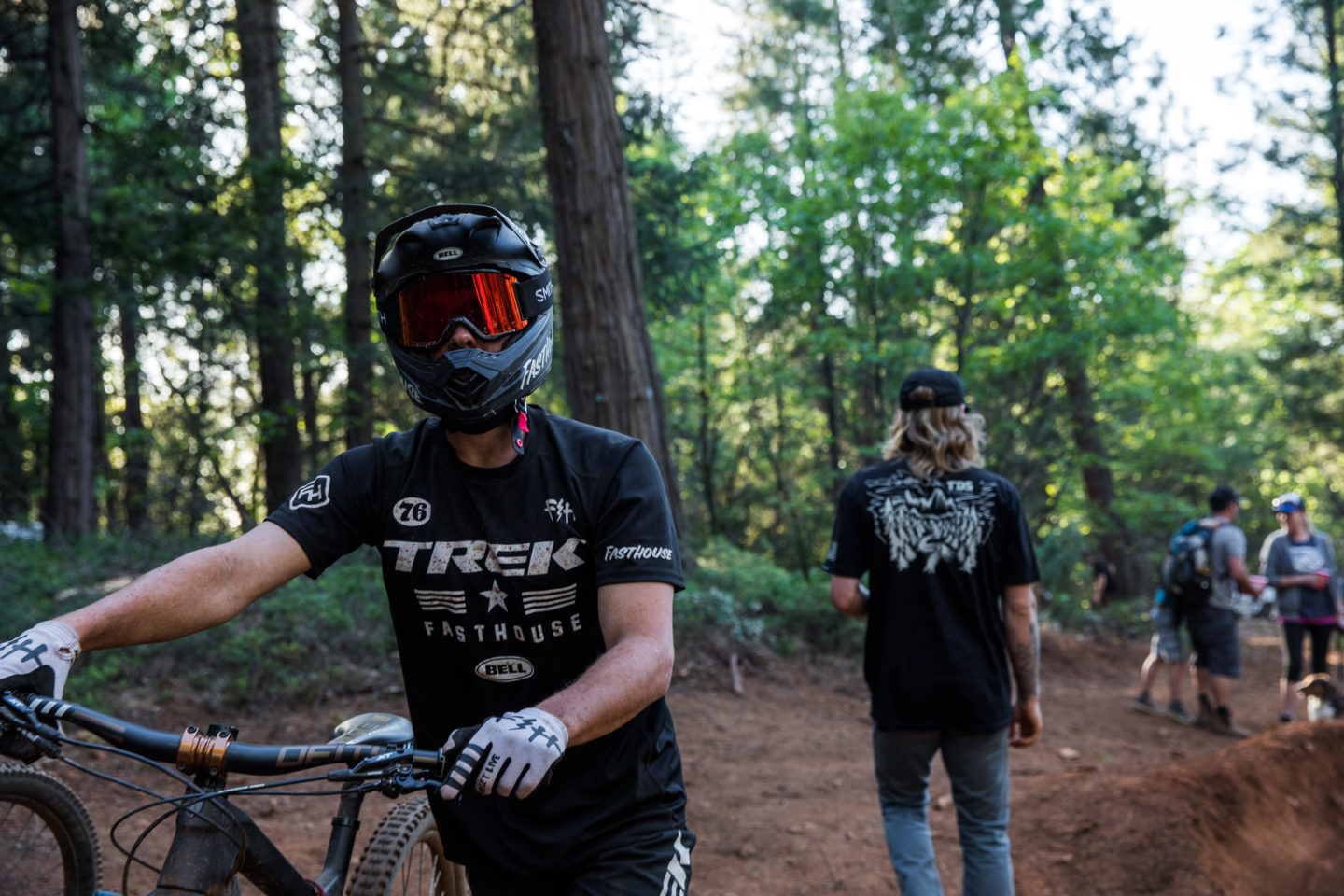
- Lidl-Trek Fanclub
- trekbikes.com
Meet the new Trek Madone
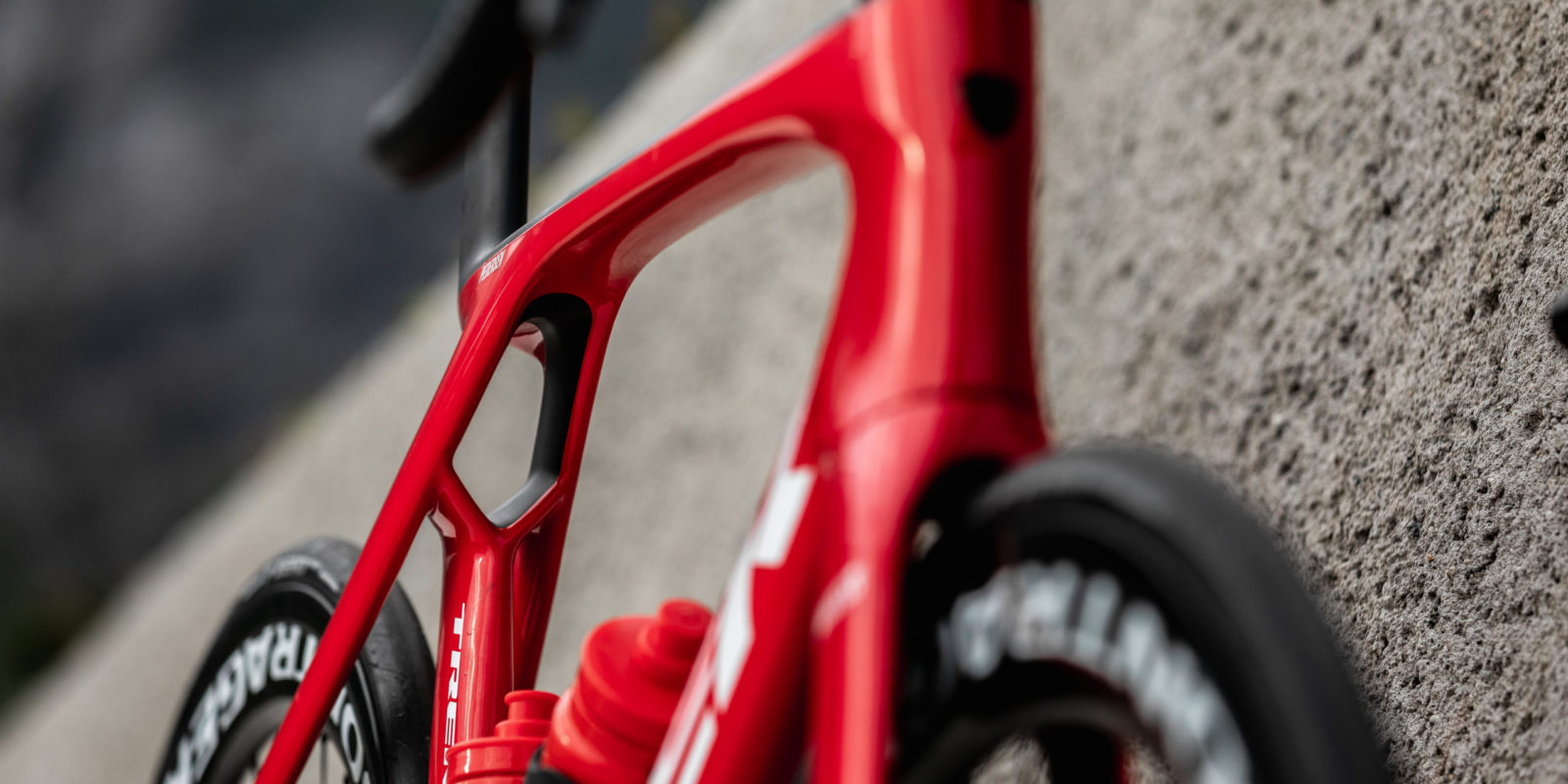
Our fastest road bike ever. Period.
The holy grail of road bike engineering is a perfect balance of aerodynamics, light weight and comfort. With the seventh generation of the Trek Madone, the mad scientists at Trek’s laboratories may have finally found the sweet spot for what we can proudly, and unequivocally, call our fastest road bike ever.
The secret is hiding in plain sight. Each frame is sculpted with IsoFlow technology, which splits the seat tube, creating a funnel beneath the seat mast that smooths and accelerates air through the frame while also creating flex near the saddle to smooth out those bumps in the road, so you can ride even farther.
IsoFlow is both eye-catching and revolutionary. You can see it at work already for the Trek-Segafredo men’s and women’s teams at some of the biggest races of the year, including the Tour de France. If you love speed, you’re going to love this bike.
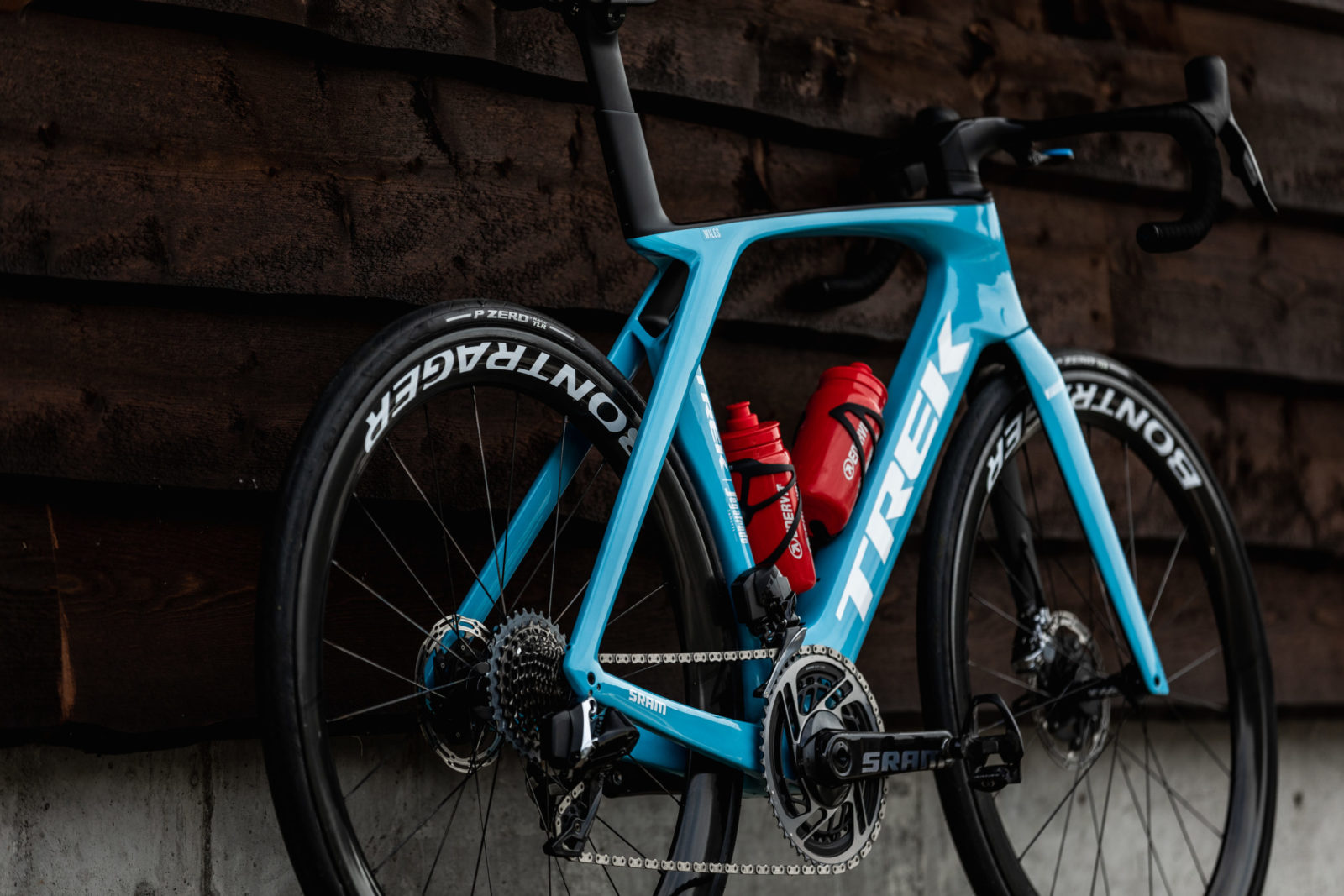
The full bike and a good look at IsoFlow.
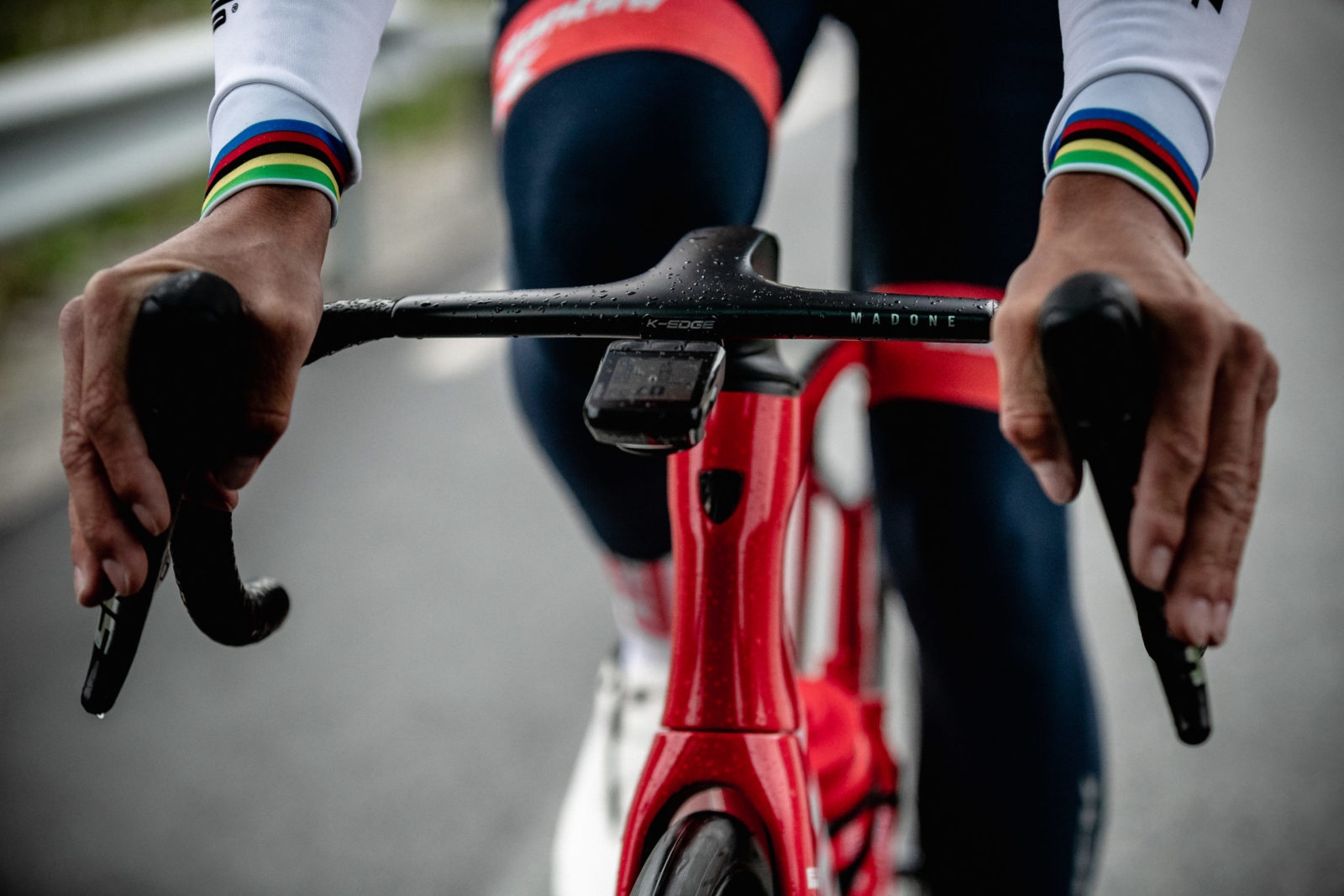
A cockpit built for speed.
Trek engineers didn’t stop at IsoFlow to improve the Madone’s aerodynamics. Painstaking research went into the frame, cockpit and rider position to make sure that riders got every ounce of free speed possible. The result? The new Madone is 19 watts faster than the previous generation at 45 kilometers an hour. That’s a savings of approximately 60 seconds per hour.
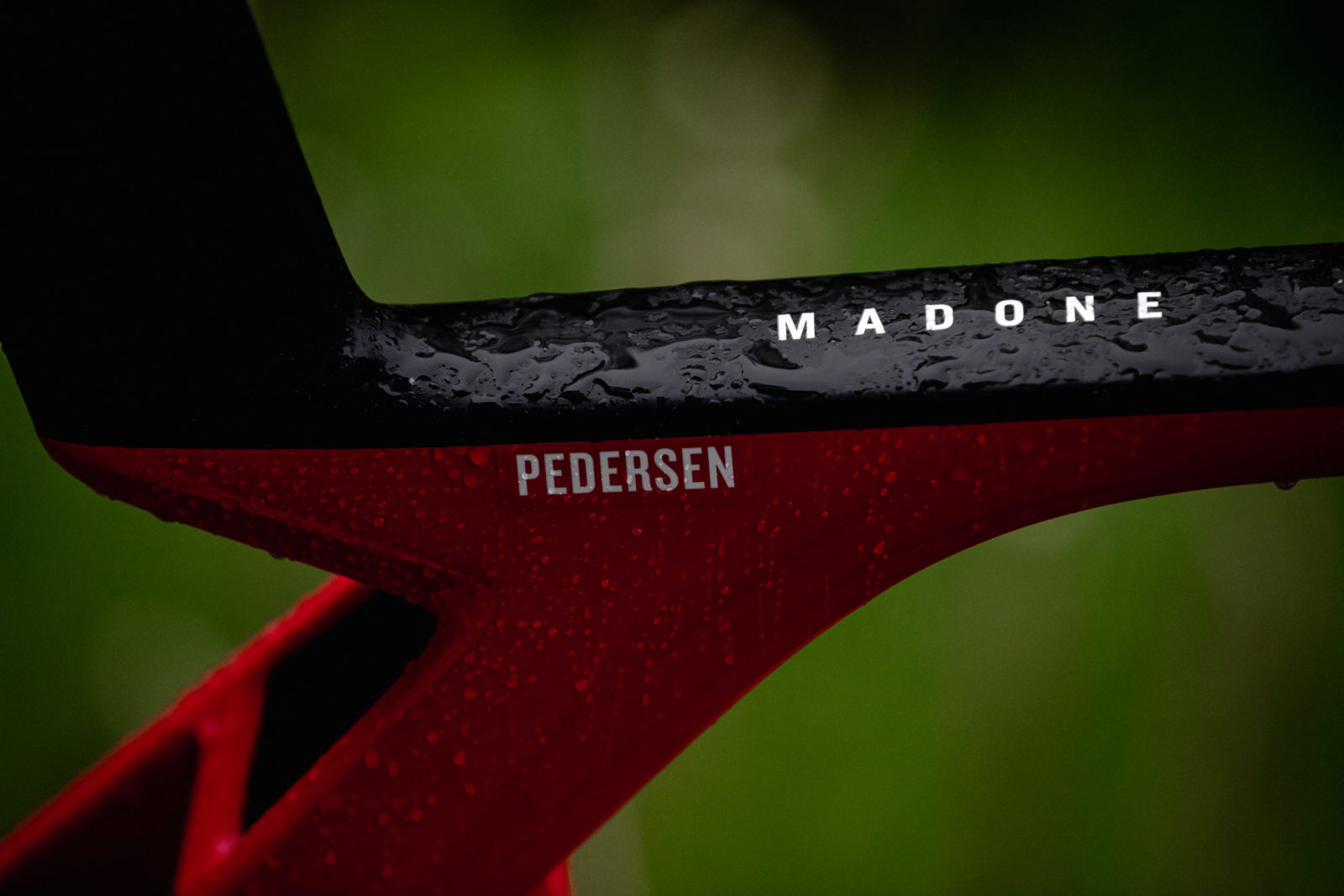
A split seat post helps eat bumps in the road.
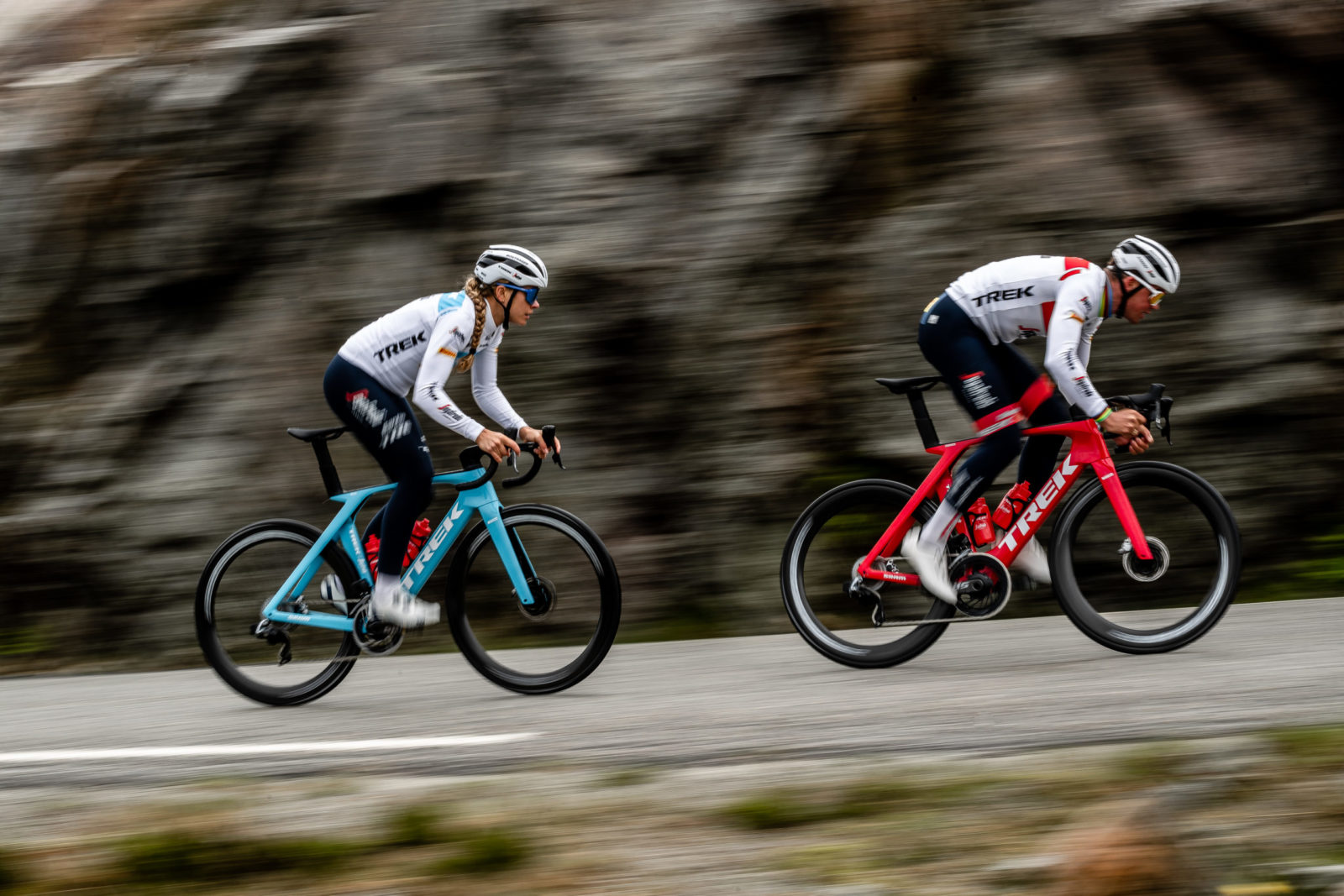
A more comfortable position means longer games of "tag."
Power, comfort and control
Riders are now placed in an even more ergonomic riding position compared to the previous Madone, thanks to an overhauled cockpit that features a shorter reach and hoods that are 3 centimeters narrower than the drops. Combined with IsoFlow, riders can expect to feel faster late into their long efforts.
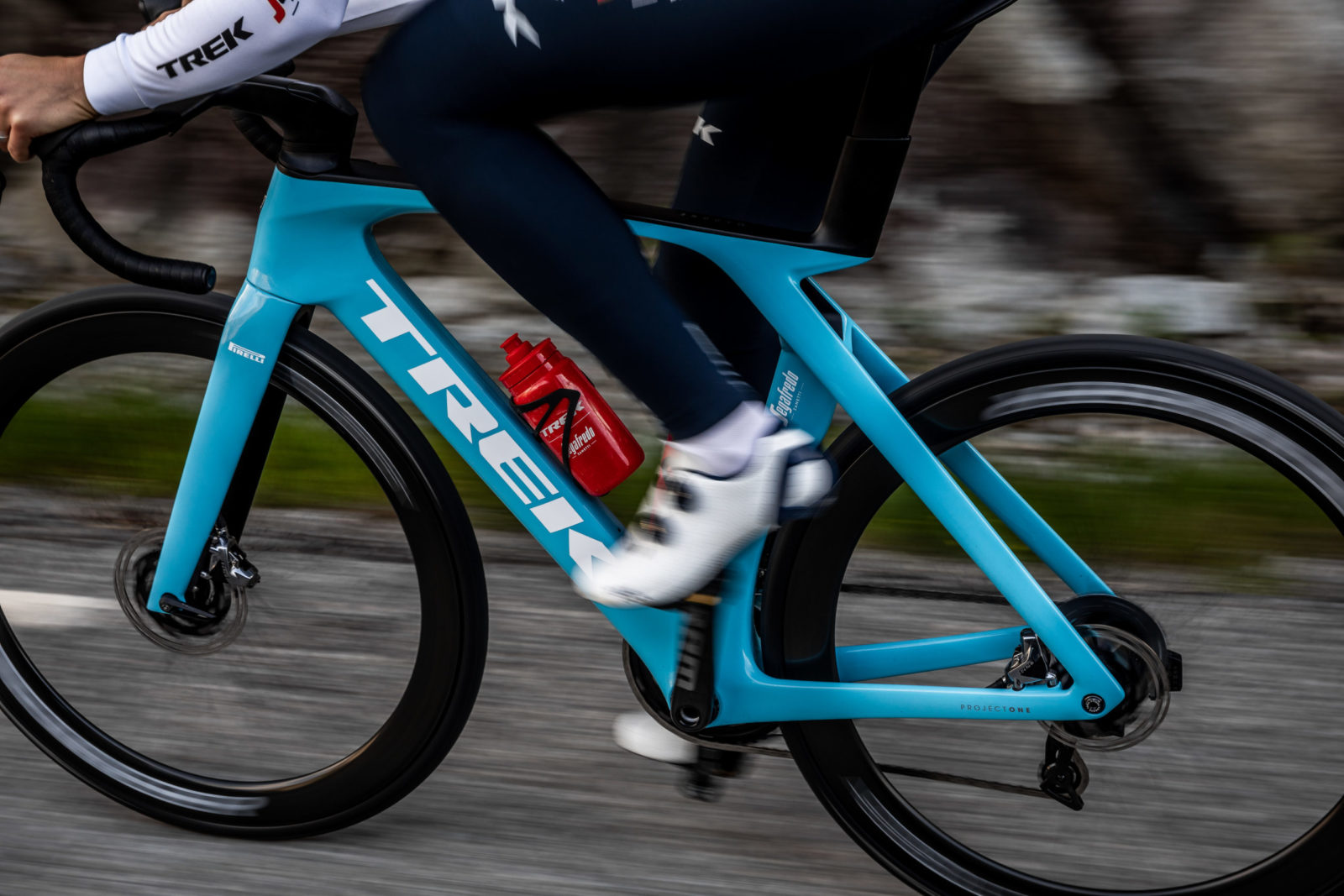
Climb or descend like the best.
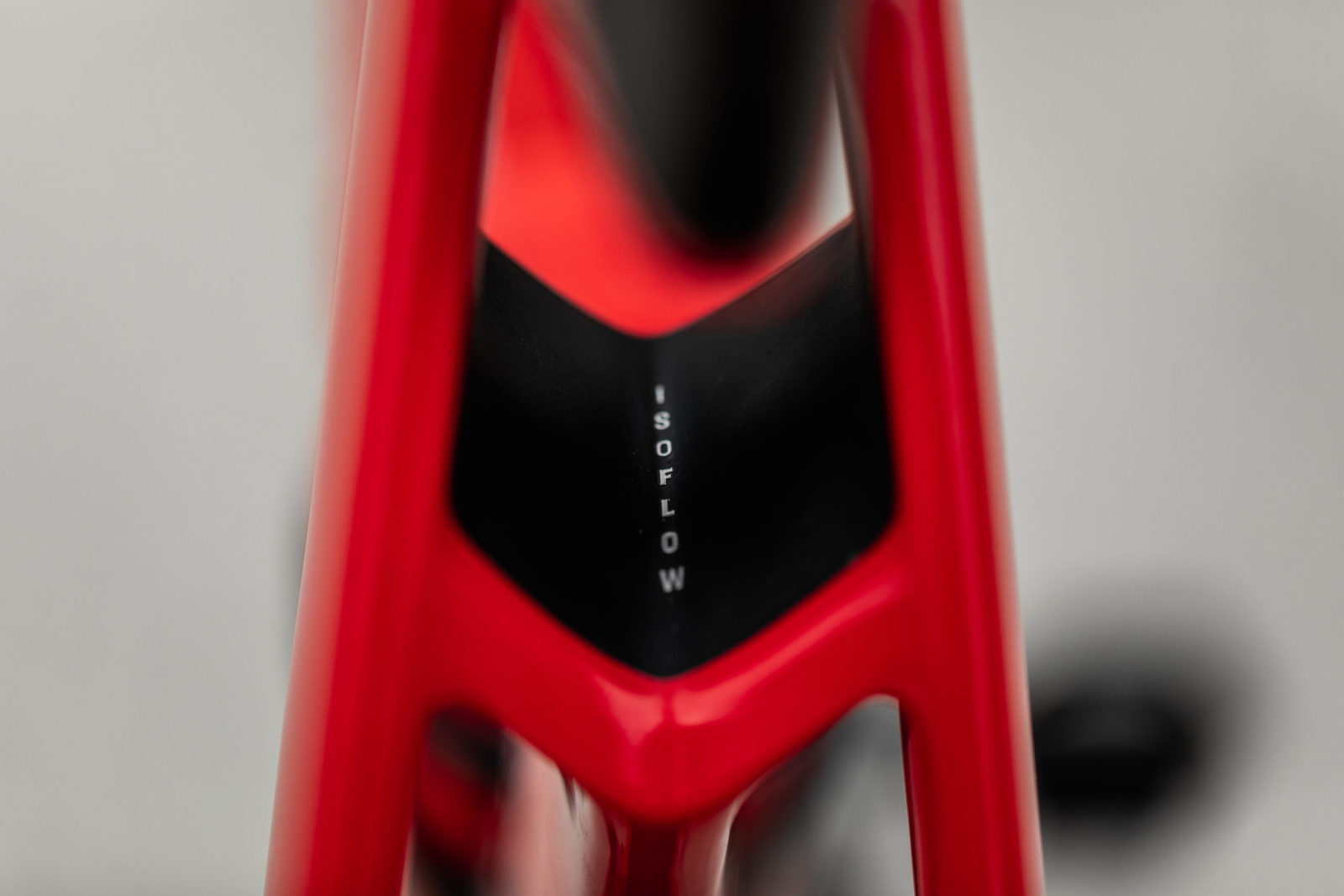
Lighter than ever
It may not beat the mountain-eating Émonda , but the new Madone has always been plenty snappy on steep gradients, and it’s even more so now. The new Madone is around 300 grams lighter than the previous version, again thanks to IsoFlow, as well as our best and lightest OCLV Carbon. Take on your hometown’s killer climb (you know the one) without fear.

No detail overlooked.

Coming to a peloton near you.
You want a lighter, faster, more comfortable road bike? Well here it is. The Madone compromises nothing to give you the ultimate ride. There’s simply nothing like it.
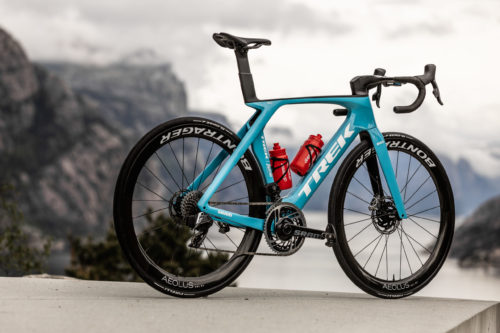
Our fastest road bike ever
Discover more.
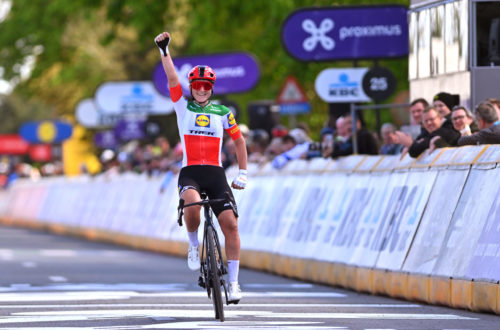
Elisa Longo Borghini solos to victory at De Brabantse Pijl
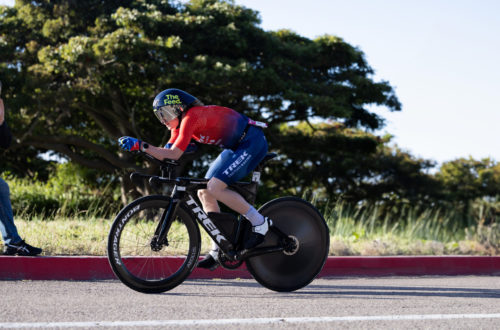
Taylor Knibb lights up Ironman 70.3 Oceanside!
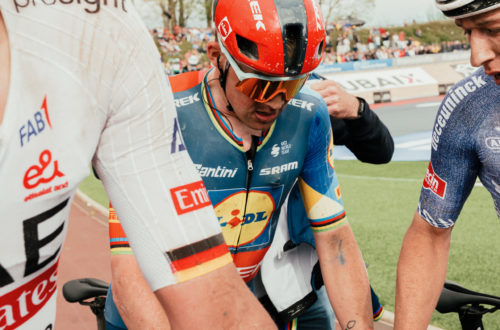
RACE GALLERY: Paris-Roubaix
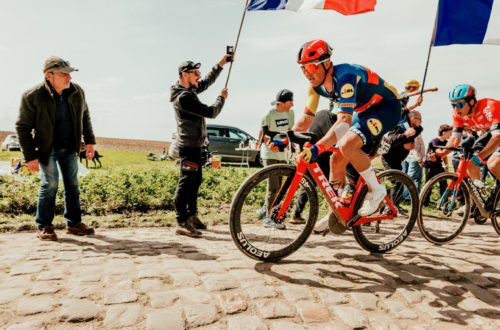
Mads Pedersen takes third in Paris-Roubaix with a courageous effort

All Access: Mads
A fairytale Tour de France awaits for Mads Pedersen
Gear-obsessed editors choose every product we review. We may earn commission if you buy from a link. How we test gear.
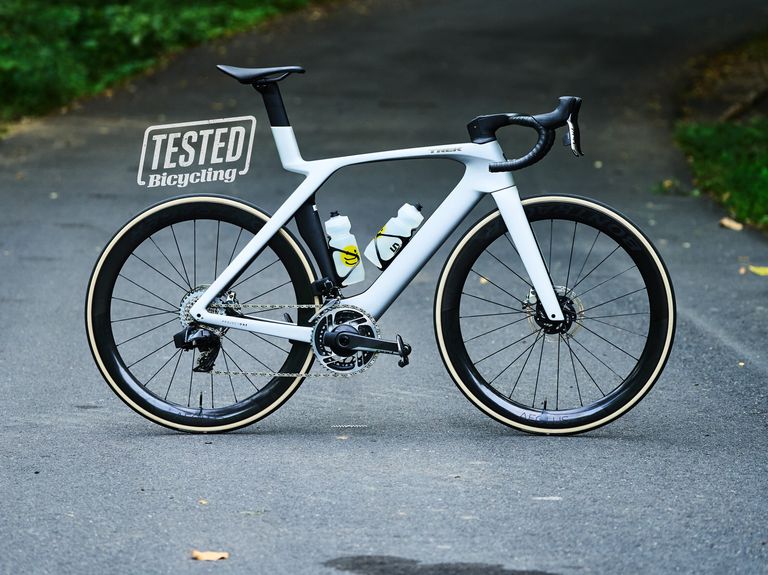
Trek’s Seventh Generation Madone Blends Radical Design and Performance
Trek's new Madone is made to go fast and win races.
Takeaway: A pure-bred road race bike designed to win at the WorldTour level. With its latest Madone, Trek ditches the IsoSpeed decoupler for the new lighter weight, more aerodynamic, and visually radical IsoFlow seatmast.
- Drops weight and gains efficiency.
- Proven geometry remains unchanged from the gen-6 model.
- Flared bars for reduced drag.
- Three SRAM and three Shimano build kit offerings.
Trek Madone SLR 9 eTap Gen 7
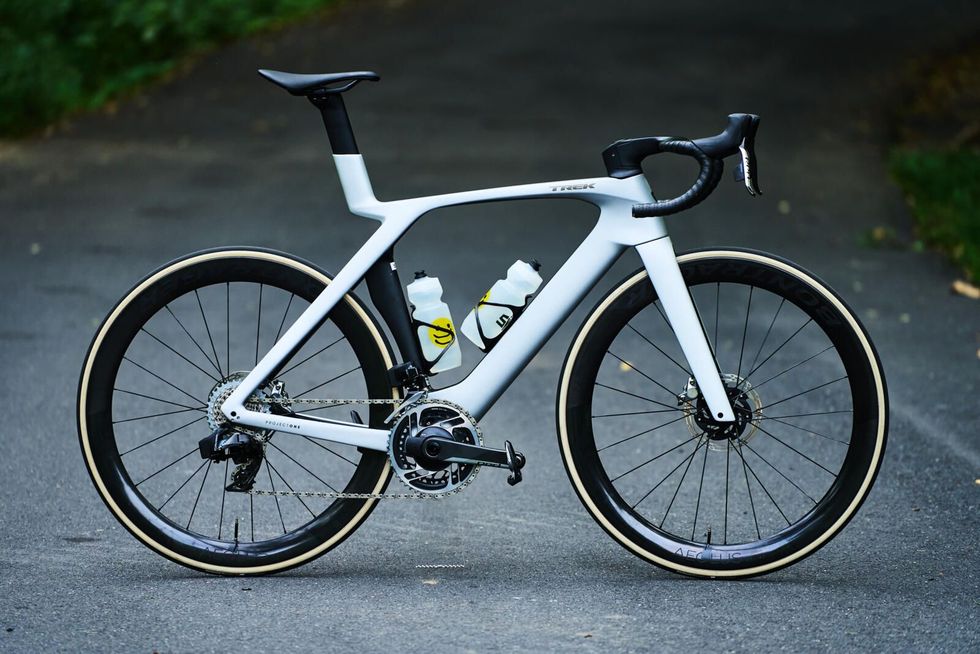
Trek’s Madone is an iconic bike. First launched in 2003, the Madone has evolved massively over the past two decades. The platform’s most significant technological leap came about in 2014 when Trek debuted the Emonda, its dedicated lightweight bike. The Emonda freed the Madone from having to strictly be a light bike, allowing aerodynamics to become its primary focus.
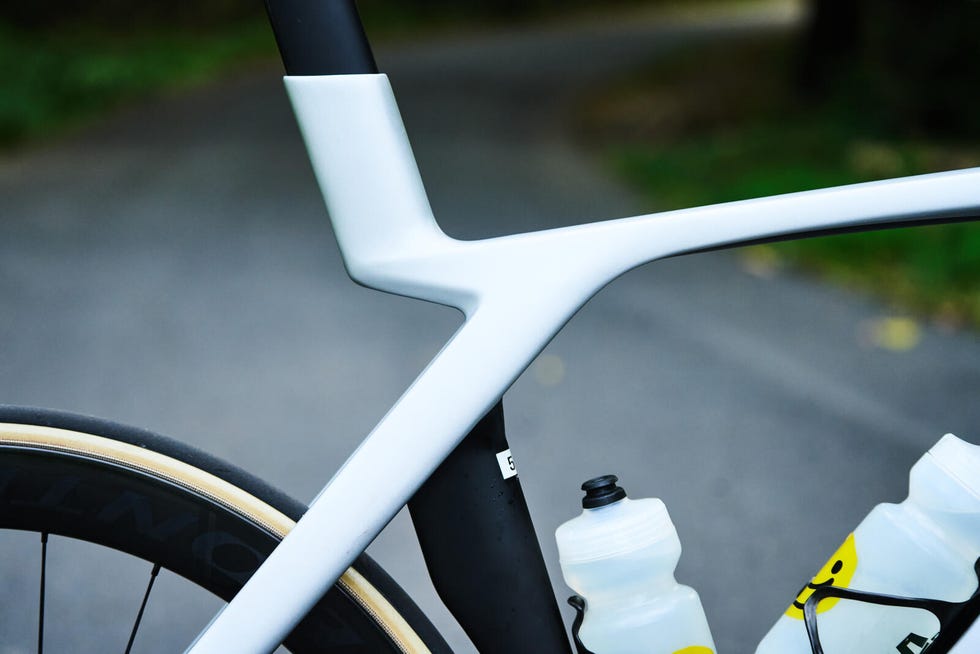
To deal with the notoriously stiff and uncomfortable ride of early aero bikes, Trek’s engineers incorporated an IsoSpeed decoupler, similar to the one used on the brand’s Domane endurance bike. With IsoSpeed, the bike’s seat tube moved independently from the top tube and seat stays, allowing it to absorb road chatter and small bumps. The resulting sixth-generation Madone was incredibly fast against the wind while also receiving praise for its ride quality. But the downside was the added weight.
With the new seventh-generation Madone, Trek set an ambitious goal of reducing weight without sacrificing the comfort and aerodynamic properties of the old bike. The most obvious place to shed grams was the IsoSpeed system, now replaced by the visually striking IsoFlow.
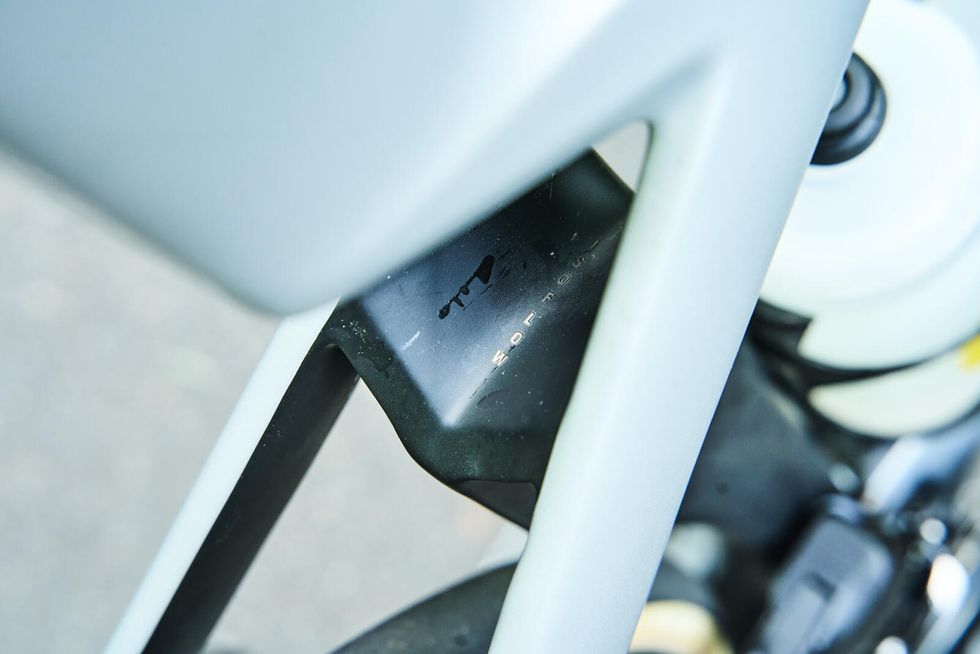
According to Trek, function drove IsoFlow’s development. Aided by computational fluid dynamics (CFD), Trek sought to overhaul the entire aerodynamic package of the Madone. The result was a new generation of Trek’s Kammtail tube shapes, including a smoother head tube, a down tube better optimized for use with and without bottles, a taller bottom bracket area, and the radically designed seat tube.
The new Madone is bold and will not be mistaken for any other bike. But it definitely won’t please riders who prefer a more traditional aesthetic. Trek deserves props for pushing the design language of a bicycle forward. Though its looks won't please everyone, I’m happy to see something other than a cookie-cutter, dropped-stays, aero-ish, all-around-er that seems so popular amongst bike designers.
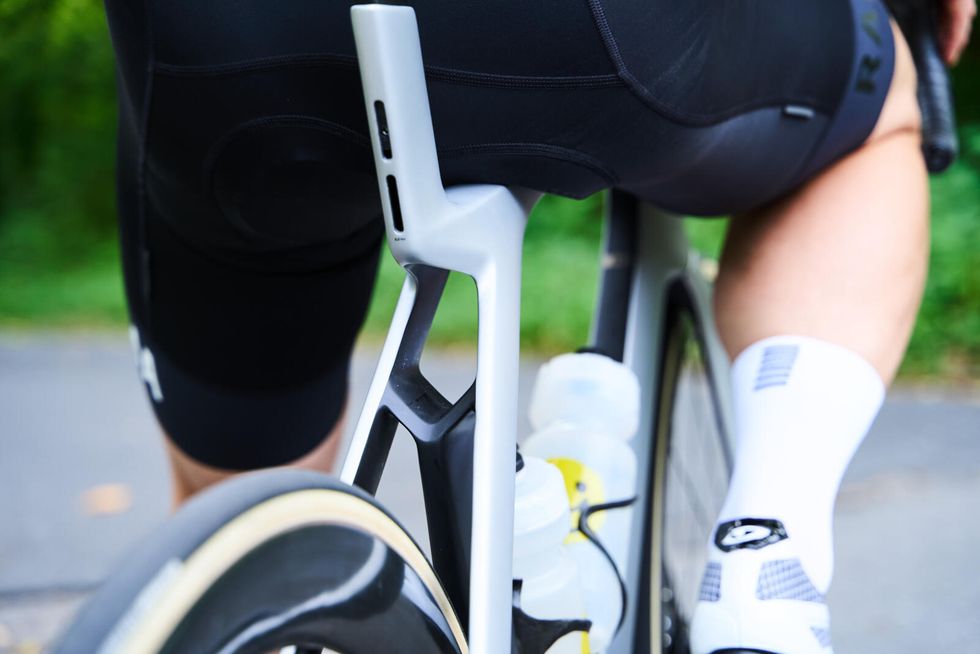
The new seat mast set-up is well-designed, offering easy and consistent height adjustment. But the best detail was in the seat clamp, which allowed for fore and aft adjustment independent of saddle tilt. It’s a small detail that makes setting up the bike much easier, as it allows for minor saddle angle tweaks while leaving it clamped in place.
These changes account for roughly half of the aerodynamic improvements of the new bike. Trek claims that the new Madone saves riders 19 watts of pedaling energy at 28 mph, but just half of that savings (9.3 watts) is from improvements to the frame. The remaining watt savings come from changes to the rider position due to the new flared handlebar design. The Madone SLR handlebar measures a traditional width in the drops, but the bar's flare positions the hoods inward by 30mm. This narrower hood location puts the rider in a more aerodynamic position when riding, thus saving watts.
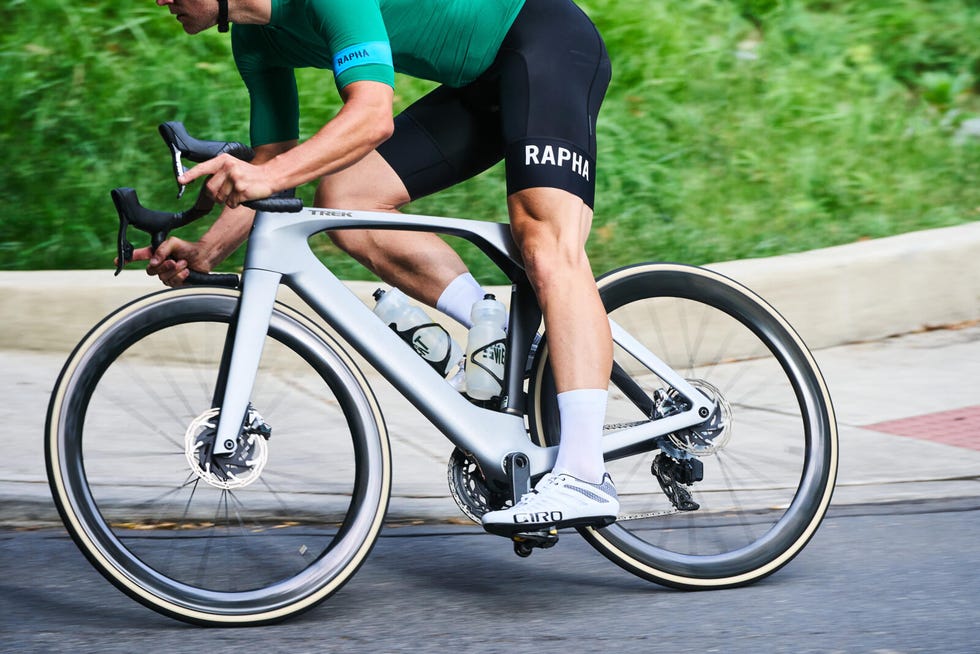
Thankfully for riders that are particular about their contact points, Trek made the new bike compatible with standard 1-⅛” stems so riders can set up their cockpit however they like. However, changing to this would give up a large chunk of the Madone’s claimed aero benefits unless riders choose a narrower-than-normal bar width.
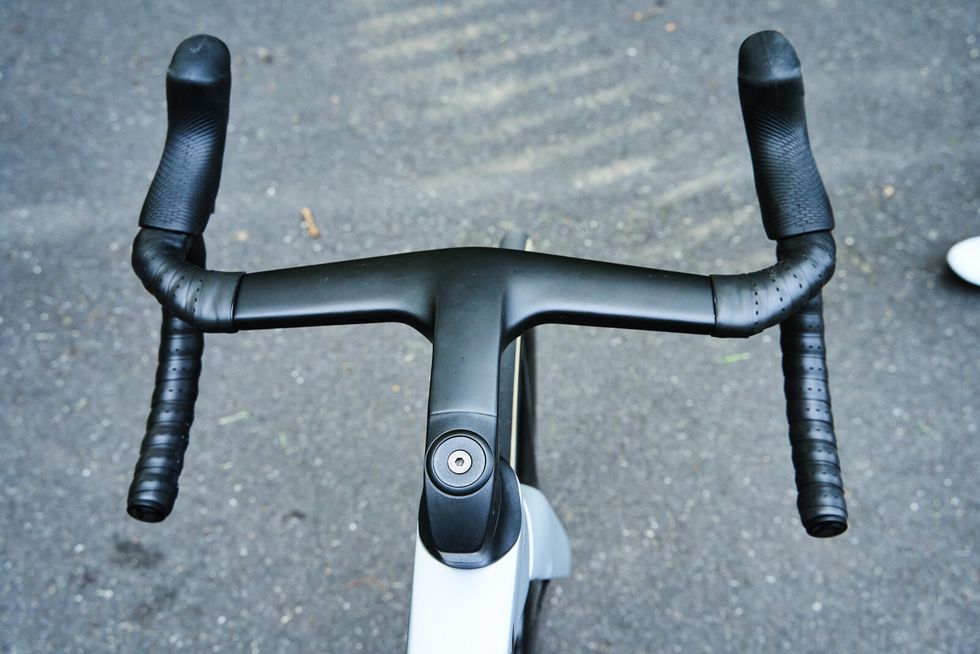
More importantly for pro riders and weight weenies alike, the new frameset is now two-thirds of a pound lighter than its predecessor. Our 56cm test bike came in at 16.2 pounds which is pretty svelt for an aero bike with 51cm deep clincher wheels and disc brakes. A big part of the weight saving comes from the new IsoFlow design. The cantilevered design of the seat tube and IsoFlow allows for engineered flex in the new Madone. This design is how Trek maintains the Madone’s celebrated ride quality.
Trek stuck to its H1.5 geometry as used on the previous generation Madone. It conceived this as a meeting point between Trek’s old racing-focused H1 geometry and its more relaxed H2 angles. The wheelbase on our 56cm bike was only 983mm, nearly a centimeter shorter than the Specialized Tarmac SL7 and Giant’s TCR, and 13 mm shorter than Canyons Ultimate. Combined with a relatively steep 73.5-degree head tube angle and a 58mm trail figure, you get a bike that will dive into corners as hard as you’re willing to push it.
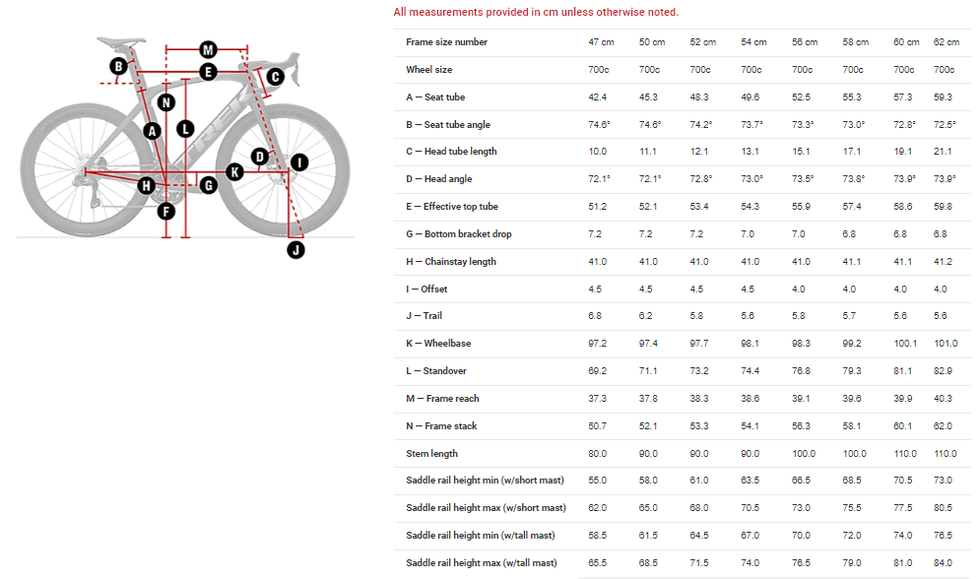
Pricing and Build Options
There is no getting around the fact that as the top-of-the-line road racing bike from Trek, the Madone is not cheap. The move to electronic-only groups on all builds of the Madone does the price no favors as well. While equivalent new models of the Madone only get $200 more expensive for 2023. The entry-level build for the 2023 Madone SLR 6 (with Shimano 105 Di2) comes in at $8,000. That is a $1,100 increase over the 2021 Madone SLR 6 equipped with mechanical-shifting Shimano Ultegra. Top-of-the-range Dura-Ace and Red eTap builds retail for $12,750 and $13,200, respectively.
Trek offers the new Madone in six builds, three with SRAM (Red, Force, and Rival eTap) and three with Shimano (Dura-Ace, Ultegra, and 105 Di2). All of the Madone builds ship with the new integrated cockpit; Dura-Ace and Red-equipped Madones ship with Bontrager Aeolus RSL 51 wheels, while all other builds get the slightly heavier Aeolus Pro 51.
Ride Impressions
The new Madone has an exceptionally smooth ride, lacking the characteristically dead and harsh feel of past aero bikes. But the mellow ride is not without an edge. The Madone does an exceptional job of balancing all-day comfort with the agility and aggression needed to be a top-tier race bike. Under sharp accelerations, especially at speeds under 25 mph, the Madone felt impressively stiff. But accelerations from the high 20s into 30+mph territory felt a bit more muted, which is not inherently a bad trait. A twitchy bike is not helpful when you’re going that fast.
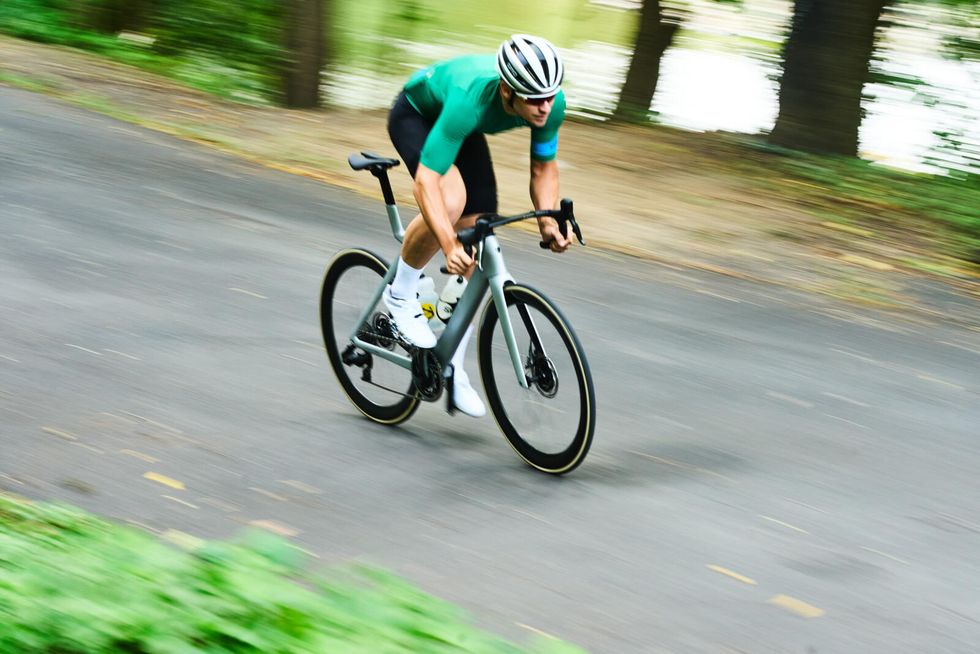
Once the Madone is up to speed, it just wants to stay there. I was impressed with how quickly and easily the bike would get rolling up to 20-22 miles per hour. Combined with the gentle ride quality, it felt like the new Madone would constantly surprise me with how fast I was going. The sensation of speed on this bike is almost sneaky, you get used to what 25mph feels like on a road bike, but on the Madone, the same pace feels calmer and less frantic, at least in a straight line. Throw the Madone into a corner, and it instantly feels sharp and aggressive.
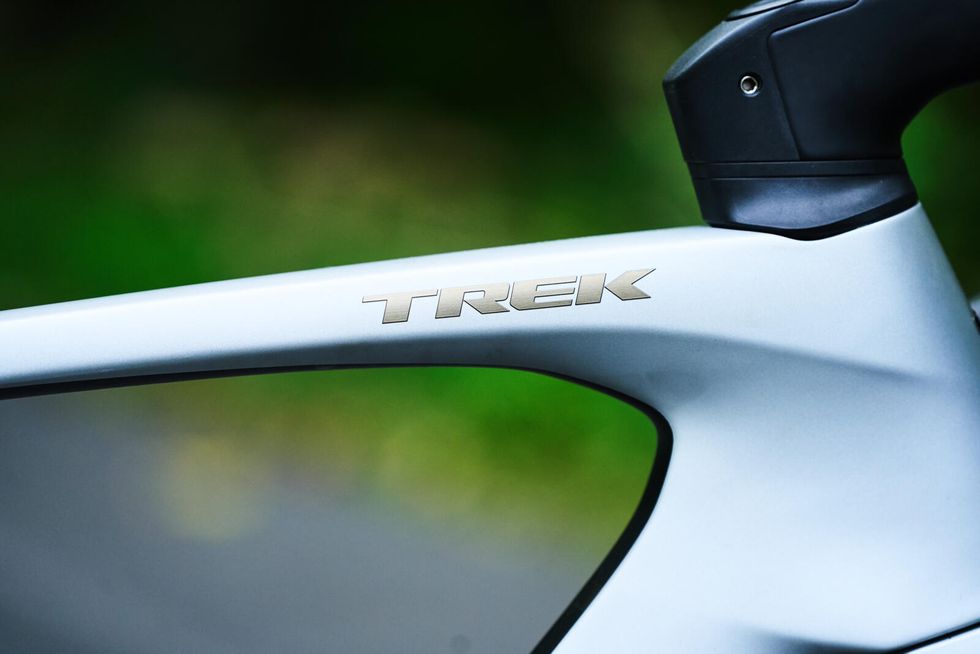
As a racer, I very much enjoyed the Madone’s willingness to corner aggressively, but it did expose one of the bike's faults. The 25mm tires shipped on our test biker are simply too narrow. Trek claims that the Madone can fit tires up to 28mm, but this feels short-sighted. Wheel brands such as Reserve, Enve, and Zipp now design around a 28mm tire as the default width. There is plenty of space in the frame for wider tires, so Trek is likely very conservative in its stock tire choice and maximum tire width recommendation.

Even riding the stock 25mm tires with pressures as low as 65 psi front and 75 psi rear, the narrow rubber still felt like it was missing grip, with the back end stepping out multiple times when exiting a corner. It was also discouraging that a road bike selling for over thirteen thousand dollars does not ship with tubeless compatible tires or the proper bits to easily set up the Bontrager Aeolus RSL 51 wheels as tubeless.
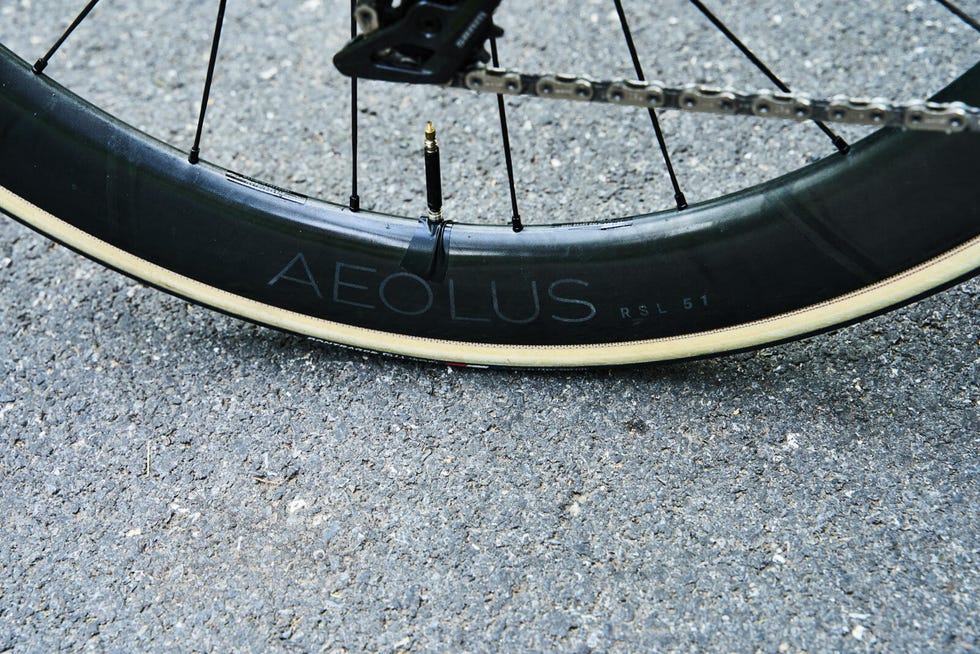
Another thing missing from the bike was a computer mount. Usually, it is not something I would expect a brand to include, but the bars require a Trek-specific part. Given the complete bike’s price tag and Trek’s integrated cockpit, it should come with a computer mount. I sourced a Blendr mount from my local Trek store, but it was not without its issues (it rattled loose during a training crit and fell off). It is possible to entirely avoid this proprietary part by using a standard 1-⅛” stem and handlebar but making this swap would involve cutting hydraulic houses and would not be cheap.
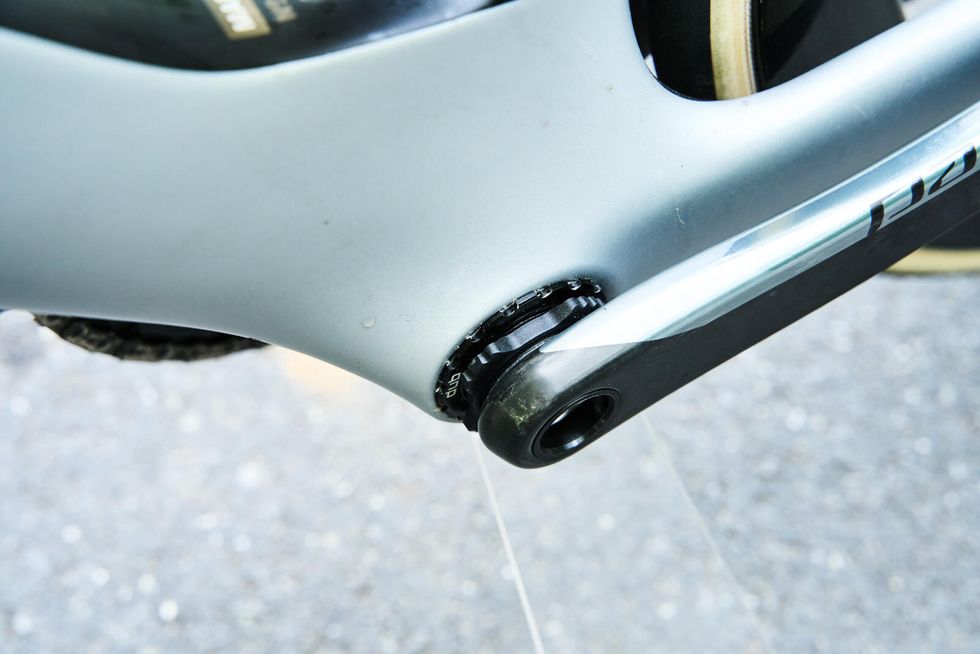
I was also pleased to see Trek continue using the T47 bottom bracket standard on this bike. A threaded bottom bracket shell is a win for mechanics everywhere. However, the latest Madone is now only compatible with electronic shifting. We can argue whether it's bike brands like Trek (releasing electronic-only high-end bikes) or component brands like SRAM and Shimano (no longer developing high-performance mechanical road groupsets) or if consumers are just voting with their dollars. But the result is that we are witnessing the death of mechanical shifting from high-end racing bikes. And that's a little bit sad.
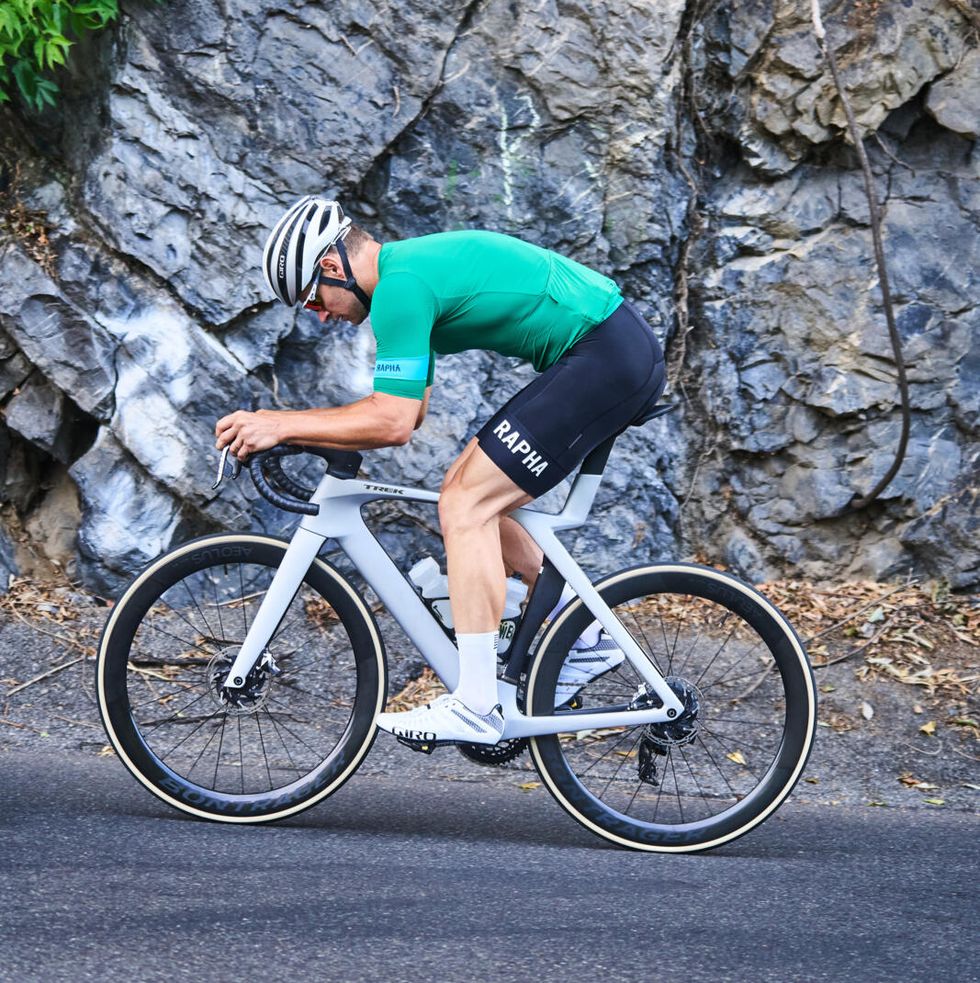
Ultimately this Madone, like the versions that have come before, was conceived and designed to meet the needs of World Tour professionals. Everything about the bike, from how it rides, to how much it costs, reflects that niche design requirement. Aside from a small pool of professional racers, very few people will likely make the most of this bike’s capabilities. It’s analogous to the way most drivers will not benefit from driving a Formula One car. It’s a pure-bred race bike designed to win at the highest level. If that’s what you’re looking to do—or you just want to own a bike with that ability—then the Madone should be on your shortlist.
Test Editor Dan Chabanov got his start in cycling as a New York City bike messenger but quickly found his way into road and cyclocross racing, competing in professional cyclocross races from 2009 to 2019 and winning a Master’s National Championship title in 2018. Prior to joining Bicycling in 2021, Dan worked as part of the race organization for the Red Hook Crit, as a coach with EnduranceWERX, as well as a freelance writer and photographer.

.css-1t6om3g:before{width:1.75rem;height:1.75rem;margin:0 0.625rem -0.125rem 0;content:'';display:inline-block;-webkit-background-size:1.25rem;background-size:1.25rem;background-color:#F8D811;color:#000;background-repeat:no-repeat;-webkit-background-position:center;background-position:center;}.loaded .css-1t6om3g:before{background-image:url(/_assets/design-tokens/bicycling/static/images/chevron-design-element.c42d609.svg);} Member Exclusive
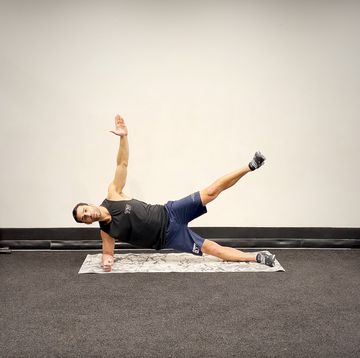
How to Prepare for a FTP Test
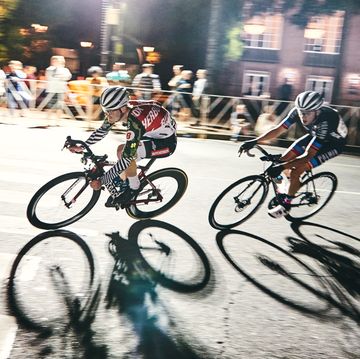
8-Week Beginner Crit Training Plan
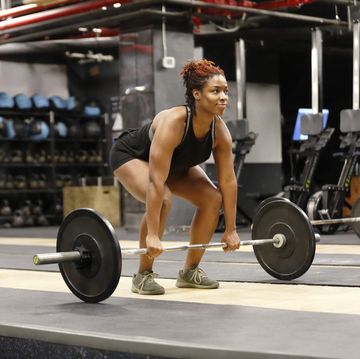
Feel Happier in 10 Minutes With These Moves

What Fruit is In Season Now?

How Fast Do the Pros Ride in the Tour de France?

Here's How to Treat—and Prevent—Saddle Sores
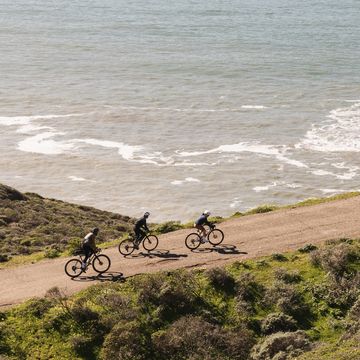
Not Reaching Your Goals? Here are Twelve Fixes.
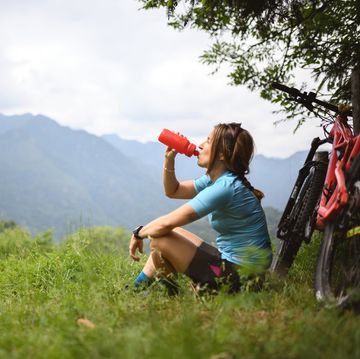
I Drank a Gallon of Water a Day for a Month
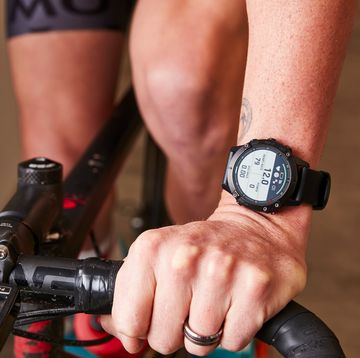
What to Know About Cycling and A Normal Heart Rate
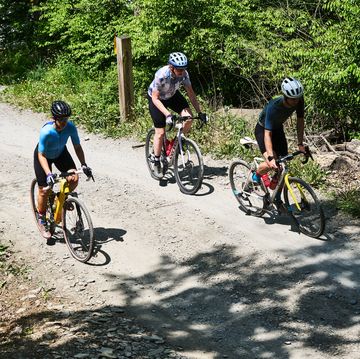
How to Plan a Century Ride Route

Yoga May Ease Chronic Lower Back Pain
Trek Madone SLR 7 Gen 7 review - very fast and very expensive
The latest Madone may have a hole through the seat tube but we couldn't find any in its performance
- Sign up to our newsletter Newsletter

The Trek Madone is an absolute speed weapon. The deep-section tubes with the radical-looking cutout help, as does the newly designed handlebar, which is narrow and provides good wrist support for the ‘aero-hoods’ position. And then there are the 51mm deep Bontrager Aeolus Pro wheels. The handling is incredibly fast, responding to the smallest shift in weight and the tiniest tweaks of the bars, and ride quality is so impressive that it’s almost possible to overlook things like the narrow tires and ungenerous clearance - but you can’t ignore the price. If you have the budget and want a WorldTour-level race machine with exceptional handling and ride feel, this is the bike.
Super smooth ride
Light for an aero bike
Striking aesthetics
Limited adjustability
No power meter
You can trust Cycling Weekly. Our team of experts put in hard miles testing cycling tech and will always share honest, unbiased advice to help you choose. Find out more about how we test.
- Construction
Value and conclusion
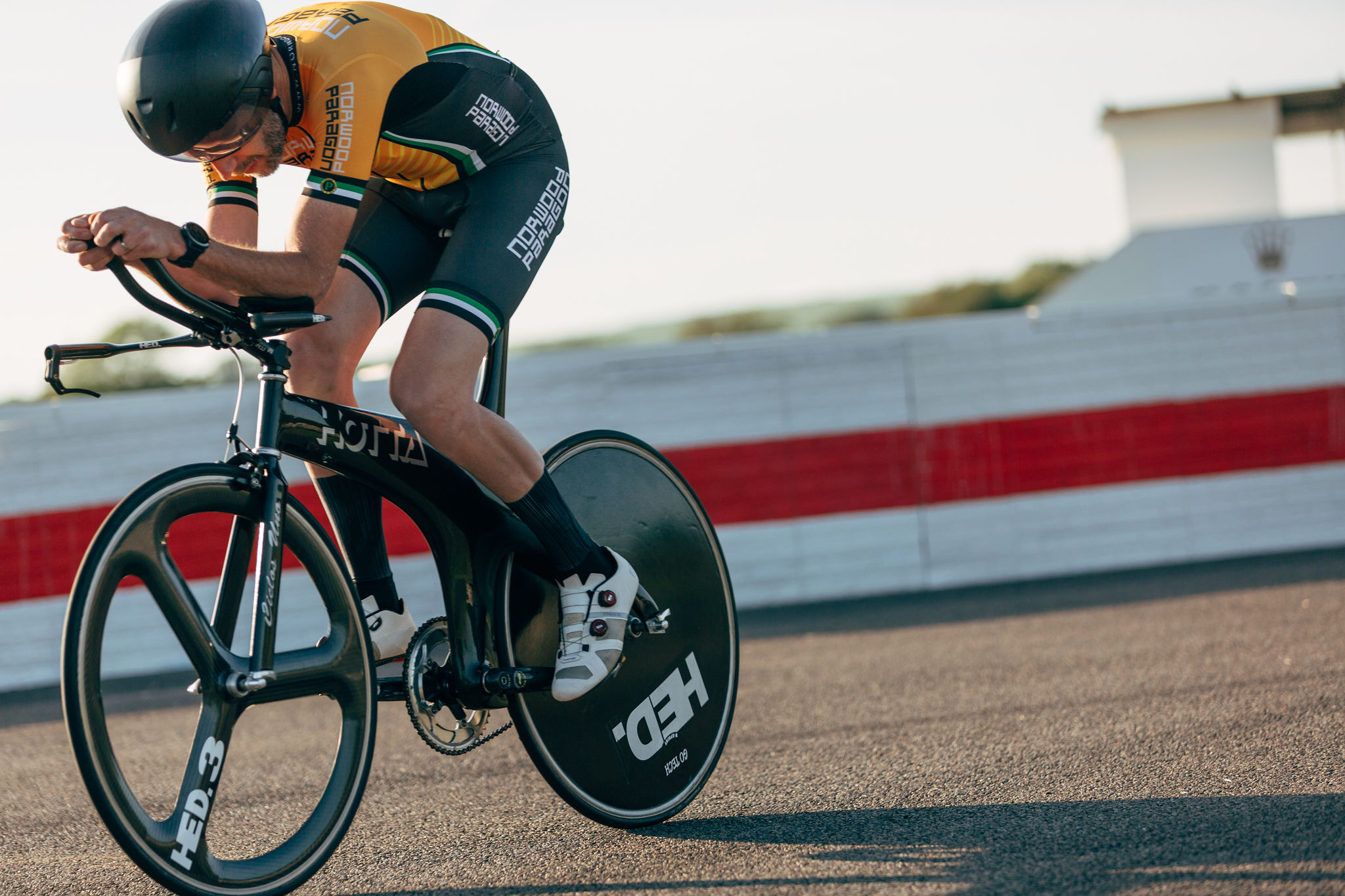
For this latest Gen 7 version of the Madone, Trek’s aero bike, the US brand removed the IsoSpeed Decoupler of the previous Gen 6 model and left, in its place, a big hole.
OK, it’s not the crude, reductionist approach it sounds like.
The old bike’s micro-adjustable suspension system at the top tube/seat tube juncture added weight and was mostly redundant since Trek discovered most riders would ‘set and forget’.
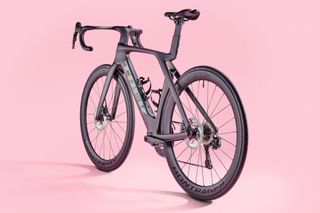
And by radically reengineering the frame Trek claims to have saved 300g, and says the new bike is almost 20 watts faster than its predecessor, which equates to 60 seconds per hour when ridden at 45kph. It looks radical, too - always a good thing for a new bike.
In our 2023 Race Bike of the Year grouptest we awarded the Madone 'best aero bike' against competition that included the Cervélo S5, the Canyon Aeroad and the Giant Propel.
However, over $9K / £10K for an Ultegra bike has to be unchartered territory - so how does it compare overall to the best road bikes ?
Trek Madone 7 Gen 7: construction

Let’s peer a bit more closely into that hole or, to give it its real name, IsoFlow. The aerodynamic explanation for it is: “It’s a way to direct some high energy flow into a low energy region of the bike.” What that means is that the seat tube area creates a disproportionate amount of drag and the hole helps to dissipate this by adding what Trek calls a “jet of fast moving air.”
It turns out that only half of the claimed watt saving comes from the IsoFlow hole. Trek has entered the integrated cockpit wars (along with Colnago, Canyon, Cervélo et al) with a completely new and very slick-looking design but it’s neither adjustable nor V-shaped: according to Trek it saves watts by changing rider position rather than via the aerodynamic properties of the cockpit itself.
A standard 42cm bar becomes 39cm at the hoods and 42cm at the drops and there’s a backsweep so that a flat-forearms aero position on the hoods becomes very aero indeed.
There are 14 different combinations available and, since the backsweep gives the bar a shorter reach, it’s important to get the right one - if you’re like those of us who rode this bike, you’ll need a longer stem. You can change this at point of purchase at no extra cost, Trek told us, or the 1 1/8in steerer is compatible with a non-integrated stem and bar (though the frame is electronic groupset only).
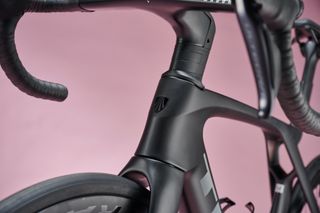
The same goes for the seatmast. The cutout in the seat tube leaves less room for a long seatpost and less adjustability (around 6cm minimum to maximum) so if you are long-legged but prefer a smaller frame you may need the tall version that comes with the size 56 upwards (as I ideally would have done). There are also two offsets available.
Our size 54 with a standard short mast could only manage a maximum saddle height of 74cm and the reach felt very short with the 90mm stem cockpit it comes with.
The latest geometry is called H1.5 (halfway between the old H1 race and H2 endurance). The reduced reach combined with the shorter reach of the swept-back bar works very well for that super aero hoods position, but it does feel surprisingly short. The kamm-tailed rear of the stem is much closer to your knees than you’d expect.
The new SLR bikes are all made from Trek’s 800 OCLV carbon - from the 105-equipped SLR 6 up to the flagship SLR 9 - and are impressively light, especially compared with other aero bikes such as the Cervelo S5. Trek says this is its lightest ever disc Madone.
There’s clearance for 28mm tires max, which is tight by modern standards. This model comes with Bontrager Aeolus Pro 51 tubeless-ready wheels, set up with Bontrager R3 Hard-Case Lite 25mm tires and inner tubes - again, surprisingly narrow.
Despite the fact that the fit wasn’t optimal - I could have done with the size up - the ride quality of the Madone is absolutely incredible. That’s the first thing that strikes you, or rather doesn’t strike you.
Aero bikes used to supply a harsher ride simply because deep, bladed tubing doesn’t flex like round tubing. This was undoubtedly the reason why Trek bolted the IsoSpeed decoupler onto the Madone two iterations ago. So you might expect that with its suspension system gone, the latest bike might have gone backwards in comfort. Not a bit of it.
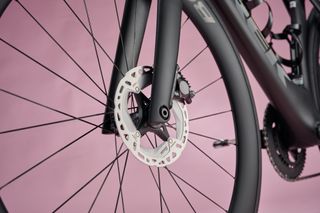
It feels like a coiled carbon spring - full of potential energy and floating over bad road surfaces seemingly without any effect on its speed. And this is on 25mm tires that aren’t even the best (at this price they really ought to be).
The handling is also exactly right. The shortish 90mm stem section of the cockpit could have made it a little twitchy, but thanks to the sweeping shape I found my weight sufficiently over the front wheel in the hoods position, and steering was fast but balanced on descents and tight corners.
So it passes ‘comfortable’ and ‘fast’ with flying colors (actually Deep Smoke for this one).
At 7.5kg it’s light for an aero bike - or any disc brake bike - and it leaps up hills as if it weighs even less. I was so impressed with its performance that I kept forgetting Trek also has the Emonda climbing bike. The next Emonda has its work cut out (pun intended).
Finally, stability in crosswinds. There’s one particular gateway on my test loop where any bike not designed for big yaw angles will be gusted and the Trek was indeed blown sideways slightly - but not alarmingly considering the deep wheels and frame tubes.
This bike is incredibly good but it’s also incredibly expensive. It’s a full $1,000 / £1,000 more than the equivalent outgoing Gen 6 Madone SLR 7, and you’d have to look hard to find a more expensive Ultegra Di2-equipped bike from the other mainstream brands.
The Canyon Aeroad CFR with Dura-Ace costs $8,999 / £8,799, while the Cervelo S5 with SRAM Force AXS costs $9,000 / £9,200. The Giant Propel Advanced SL1 also with SRAM Force costs $8,000 / £8,999.
You might also reasonably expect a power meter at this price - those three bikes all come with them - but it’s just the regular Ultegra crankset here.
So the price is stratospheric but compared with the current aero bikes I’ve ridden so far including the Colnago V4RS , Canyon Aeroad SLX , Cervelo S5, Tarmac SL7 and Pinarello Dogma F, the ride quality is superior.
- Frame: 800 Series OCLV carbon
- Fork: KVF carbon, tapered steerer
- Groupset: Shimano Ultegra Di2
- Wheels : Bontrager Aeolus Pro 51
- Tires : Bontrager R3 Hard-Case Lite 25mm
- Cockpit: Madone integrated
- Seatpost : Madone aero internal
- Saddle: Bontrager Aeolus Elite
- Weight: 7.5kg
- Contact: www.trekbikes.com
Thank you for reading 20 articles this month* Join now for unlimited access
Enjoy your first month for just £1 / $1 / €1
*Read 5 free articles per month without a subscription
Join now for unlimited access
Try first month for just £1 / $1 / €1
Get The Leadout Newsletter
The latest race content, interviews, features, reviews and expert buying guides, direct to your inbox!
Simon Smythe is a hugely experienced cycling tech writer, who has been writing for Cycling Weekly since 2003. Until recently he was our senior tech writer. In his cycling career Simon has mostly focused on time trialling with a national medal, a few open wins and his club's 30-mile record in his palmares. These days he spends most of his time testing road bikes, or on a tandem doing the school run with his younger son.

Former world champion forced to settle for third on the podium behind Van der Poel and Jasper Philipsen
By Tom Thewlis Published 7 April 24

British rider was unable to grip his handlebars properly in the finale as the last cobbled sectors arrived
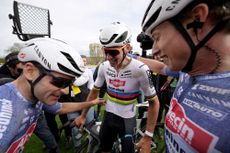
The world champion launched his race winning move on the Orchie cobbled sector, almost 60 kilometres from the Roubaix velodrome
Useful links
- Tour de France
- Giro d'Italia
- Vuelta a España
Buyer's Guides
- Best road bikes
- Best gravel bikes
- Best smart turbo trainers
- Best cycling computers
- Editor's Choice
- Bike Reviews
- Component Reviews
- Clothing Reviews
- Contact Future's experts
- Terms and conditions
- Privacy policy
- Cookies policy
- Advertise with us
Cycling Weekly is part of Future plc, an international media group and leading digital publisher. Visit our corporate site . © Future Publishing Limited Quay House, The Ambury, Bath BA1 1UA. All rights reserved. England and Wales company registration number 2008885.
Trek Madone 9 Series first ride review
Aero speed without the usual compromises.
You can trust Cyclingnews Our experts spend countless hours testing cycling tech and will always share honest, unbiased advice to help you choose. Find out more about how we test.
This article originally appeared on BikeRadar
2016 Trek Madone - What we know, what we expect
Gallery: Bauke Mollema's Critérium du Dauphiné Trek - a closer look
New Trek Madone 9 Series gets radically aero for 2016
Video: New Trek Madone 9 Series
Aero road bikes might slice through the air with relative ease but as a category, they're not exactly known to be comfortable or light. The new Trek Madone 9 Series should go a long way toward dispelling that reputation with a super sleek and comparatively feathery chassis that's not only fast but freakishly cushy on rough roads, too. We've only logged a few hundred miles on our long-termer so far but initial impressions are extremely favorable.
Click here for further detail on the Trek Madone 9 series
- Highs: Cuts faster through the wind but without beating you up along the way, fantastic handling, still impressively light
- Lows: At least interest rates on second mortgages are still low
- Buy if: You want to get there in less time but still want to be able to ride the next day, too
Fast and smooth
The first two rides on this bike were on the 'dairy roads' surrounding Trek's global headquarters in Waterloo, Wisconsin. It's a seemingly endless expanse of sinuous tarmac that's gloriously free of traffic but also relatively coarsely paved with plenty of frost heave and other imperfections that often seemed perfectly sized to swallow a road tire – not exactly an ideal proving ground for a bike that's anything less than smooth.

Such deep-profile tubes wouldn't normally suggest a smooth ride but the new Madone is remarkably comfy
But alas, the new Madone isn't just comfortable “for an aero road bike” but comfortable, period – no caveats required. Despite appearances to the contrary, the deep-section carbon frame ably damps road buzz but it also rounds off bigger and harsher bumps in a way usually only expected of more traditionally shaped bikes.
It doesn't take long before you how you're seeing all of those bumps but not really feeling them through the rear end – and in fact, I even found myself consciously aiming for stuff I would normally avoid if only just for the novelty. Credit goes entirely to Trek's awesome IsoSpeed 'decoupler' – a mechanical pivot at the seat tube-top tube intersection – and the Madone's clever dual, nested seat tube design that, in combination, allows for much more flex at the saddle than you'd otherwise get out of a more traditional frame.

Trek's excellent IsoSpeed 'decoupler' strikes again, and to great effect
Unlike on Trek's similarly IsoSpeed-equipped Domane endurance platform, which incorporates an even cushier rear end but can sometimes feel somewhat harsh up front, the new Madone delivers up a more balanced and cohesive feel front to rear. It might not be as comfortable out back as a Domane but then again, as a full-blown race bike, it should be firmer and more communicative.
That all said, riders interested in an aero road bike aren't going to be considering ride quality as their primary metric – we're talking about free speed, after all, and this new Madone seems to have that in spades, too. We haven't had a chance to verify Trek's drag claims – specifically ones comparing it to its major competition – but repeated runs on my regular fast-and-flat test loops surrounding BikeRadar's US offices in Boulder, Colorado have certainly returned consistently lower times relative to non-aero machines. As expected for this segment, the chassis is plenty stiff, too.

The front end is fantastically sleek
Helping matters further is the Madone's impeccable handling. A slight variation from Madones of yesteryear – and identical to the current Emonda – this new Madone 9 Series is nevertheless equally adept at carving up sinuous mountain descents or gobbling up long stretches of straight road, feeling utterly composed and competent throughout.
Reigning it in
Boulder isn't exactly known for being flat, however, and the countless canyon roads to the west also demand plenty of braking. Thankfully, the new Madone's proprietary center-pull rim brakes are not only cleanly integrated into the frame and fork for aero purposes but they also work well – a good thing since there are no other options.

The dedicated centerpull brakes work well with generous power and control, plus fantastic lever feel
Caliper flex is practically nonexistent thanks to short and compact aluminum arms and a fully boxed-in layout that bridges the ends of the direct-mount pivots. Meanwhile, the cable wedge moves on rollers while both pivots are fitted with cartridge bearings to return a silky smooth and light lever feel that's noticeably devoid of excess friction.
Total braking power leaves a little to be desired with the Bontrager carbon-specific cork pads included here and they're also prone to squealing but modulation is very good. We'll likely switch to a set of SwissStops as the long-term testing progresses.
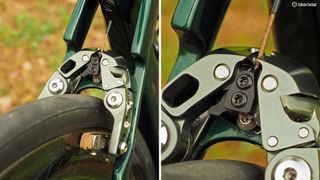
A look at the inner workings
Clearance is great, too. Trek officially says the new Madone will swallow tires up to 28mm wide and rims up to 30mm wide (external measurement), depending on the exact combination.
Sweating the details
Another usual pitfall of proprietary componentry is lack of compatibility. In that sense, there's no grand departure here as the Madone's dedicated aero-profile one-piece carbon fiber bar and stem won't work with aftermarket computer or camera mounts, and the similarly aero-profile no-cut extended seatmast won't take anything other than the dedicated Bontrager head.

The aero cockpit is actually quite comfy to hold
But on the upside, Bontrager has at least given the cockpit an agreeable shape with versatile semi-anatomic drops and flattened tops that you can still comfortably wrap your hands around. And while Trek says it's faster to leave the tops untaped, the subtle 'Madone' graphics are sized such that you can still wrap them up as usual without looking funny.
Likewise, there may not be much in the way of seatpost options but at least the one included is easy to live with. Bontrager's updated head design now features truly independent tilt and fore-aft adjustments, and so far, it's held rock solid.
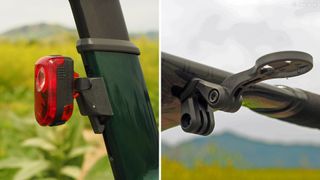
Custom mounts are included for lights, computers, and cameras
And as for accessories, Trek even includes custom mounts for computers, cameras, and lights for the cockpit and seatmast – meaning you can still attach your favorite gadgets but won't have to look at any unsightly clamps or rubber straps.
Such an obsessively hidden internal cable routing setup – it's all fully concealed save for a short section of wire for the rear derailleur – is certainly going to be more challenging to service when the time comes but Trek has at least made bar height adjustments less easy. As compared to other similar setups that require a full recabling, Trek has cleverly fitted the new Madone with custom split headset spacers.
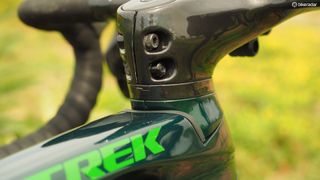
Split headset spacers should make for relatively painful height adjustments
Unflappable build kit
Trek will initially offer the Madone 9 Series in several standard builds but BikeRadar got an early sneak preview at the upcoming Project One custom version – which, in this case, doesn't stray far off the beaten path in terms of components or wheels but definitely goes off-center visually with a very non-standard green-on-green paint scheme.
There's not much that needs to be repeated on the Shimano Dura-Ace Di2 group: it's functionally without fault with perfect shifts each and every time. It'd still be nice to have some more tactile feedback from the shift buttons but that's still a matter of personal preference.
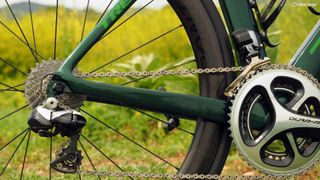
As usual, the Shimano Dura-Ace Di2 transmission is superb
Bontrager's latest Aeolus 5 D3 TLR tubeless-compatible carbon clinchers are proving to be great all-rounders, too, with a newly widened tire bed that mates well with the 25mm-wide Bontrager R4 tires used here. As we've noted before, the blunt, 50mm-deep rim shape is fast yet manageable in strong crosswinds. Their weight is also quite good although as with all tubeless-compatible Bontrager hoops, the chunky molded plastic rim strips add nearly 100g per set.
All told, this 52cm H1 test sample came in at just 6.79kg (14.97lb) without pedals or bottle cages.
Raising the bar
Overall, Trek's new Madone 9 Series is off to a fantastic start to its long-term test: it's fast, remarkably comfortable, and easy to live with. Unfortunately, the prices have climbed in lockstep with the technology but at least Trek will offer several somewhat more reasonable options with identical shaping but lesser build kits.
Not all riders will feel any burning need to go aero but when that extra speed comes with so few compromises, the arguments against it certainly become less compelling. Ever-increasing retail costs? That gets a big 'boo' from this end but the idea that aero road bikes can also just be really good road bikes in general is a trend I can get behind.
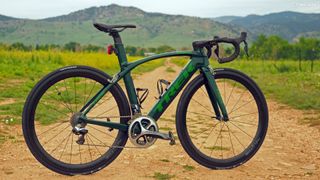
Faster, comfier, easier to live with.
Complete bike specifications
Frame: 2016 Trek Madone 9 Series, H1 geometry, 700-Series OCLV carbon fiber Fork: 2016 Trek Madone KVF Headset: Integrated Cockpit: Trek Madone integrated Bar tape: Bontrager gel cork Front brake: Trek Madone integrated w/ Bontrager carbon-specific pads Rear brake: Trek Madone integrated w/ Bontrager carbon-specific pads Brake levers: Shimano Dura-Ace Di2 STI Dual Control ST-9070 Front derailleur: Shimano Dura-Ace Di2 FD-9070 Rear derailleur: Shimano Dura-Ace Di2 RD-9070 Shift levers: Shimano Dura-Ace Di2 STI Dual Control ST-9070 Cassette: Shimano Dura-Ace CS-9000, 11-28T Chain: Shimano Dura-Ace CN-9000 Crankset: Shimano Dura-Ace FC-9000, 50/34T Bottom bracket: Enduro Wheelset: Bontrager Aeolus 5 D3 TLR clincher Front tire: Bontrager R4 clincher, 700x25c Rear tire: Bontrager R4 clincher, 700x25c Saddle: Bontrager Montrose Pro Seatpost: Trek Madone 9 Series Weight: 6.79kg (14.97lb, without pedals or accessories)

Thank you for reading 5 articles in the past 30 days*
Join now for unlimited access
Enjoy your first month for just £1 / $1 / €1
*Read any 5 articles for free in each 30-day period, this automatically resets
After your trial you will be billed £4.99 $7.99 €5.99 per month, cancel anytime. Or sign up for one year for just £49 $79 €59

Try your first month for just £1 / $1 / €1
Florian Sénéchal blames sponsor Bianchi after four bike swaps at Paris-Roubaix
Tech trends from Paris-Roubaix: Nine things we learned
Breaking the ‘vicious cycle’ – The how and why of Australia’s new ProVelo Super League
Most Popular
By Peter Stuart February 23, 2024
By Claire Sharpe February 22, 2024
By Tom Wieckowski February 15, 2024
By Tom Wieckowski February 14, 2024
By Josh Ross February 09, 2024
By Josh Ross February 07, 2024
By Claire Sharpe February 06, 2024
By Josh Ross February 05, 2024
By Immy Sykes February 05, 2024
By Claire Sharpe February 02, 2024
The ultimate race bike Our fastest road race bike ever From a legacy of greatness comes a new standard of speed. Seven generations in the making, the Madone SLR is our fastest and lightest Madone disc ever, pushing the boundaries of what’s possible with a triple threat of unprecedented aerodynamics, exceptional ride quality and lightweight design. This race-ready bike is complete with never-before-seen IsoFlow technology that gives you every advantage in speed and handling.
“Trek’s seventh-generation Madone blends radical design and performance” What the world is saying about the all-new Madone
“A pure-bred race bike"
“Does an exceptional job of balancing all-day comfort with the agility and aggression needed to be a top-tier race bike.”
“Every inch an aero race bike”
"One of the most visually striking and competent aero bikes available today [...] more aero, less weight, less complication."
“It doesn’t just look damn fast; it is damn fast”
“Seems to crave speed […] and the handling remains responsive at high speeds without lacking in stability.”
“Phenomenally fast and provides one heck of a thrilling ride”
“Offers all the aero tweaks and outright performance without compromising on day-to-day ride-ability.”
A new standard of speed Now 60 seconds/hour faster* We set out to make Madone the fastest road bike in the world. Years of research and development informed every aerodynamic inch of the seventh-generation Madone SLR to create a frame, cockpit and rider position that’s a whopping 19 watts faster than ever before.* *Compared to previous generation at 45 km/h
- see the bike
Nearly 300 grams lighter*
60 seconds/hour faster* .
Never-before-seen IsoFlow technology Brutal performance. Total comfort. All-new IsoFlow technology soaks up fatiguing bumps in the road so you can ride stronger for longer. A race-focused evolution of IsoSpeed comfort, IsoFlow flexes over bumps for a smoother ride, improves aerodynamics and shaves weight to save precious seconds in the saddle.
Unprecedented road bike aerodynamics The devil is in the details when it comes to heart-pounding, race-winning speed. Every element of the new Madone Gen 7 was expertly sculpted to create our most aerodynamic road race bike ever, including a new generation of Kammtail tube shapes, an aero-optimised cockpit and all-new IsoFlow technology that smooths air as it moves over the bike and accelerates it through the frame for even more free speed.
Positioned for power Ergonomic and aerodynamic riding position An overhauled bar/stem with a shorter reach and hoods that are 3 cm narrower than the drops move you into a more comfortable ergonomic riding position. This narrower hood position also greatly reduces rider drag for extra aerodynamic speed while maintaining control in the drops so you don’t lose power in explosive moments.
Lighter than ever New gram-shaving design A new lightweight design and our best and lightest OCLV Carbon make the seventh-generation Madone our lightest Madone disc ever, shaving around 300 grams off the previous ultra-lightweight version.
Behind the bike Hear from Senior Design Engineer, Alex Bedinghaus, on the new Madone SLR.
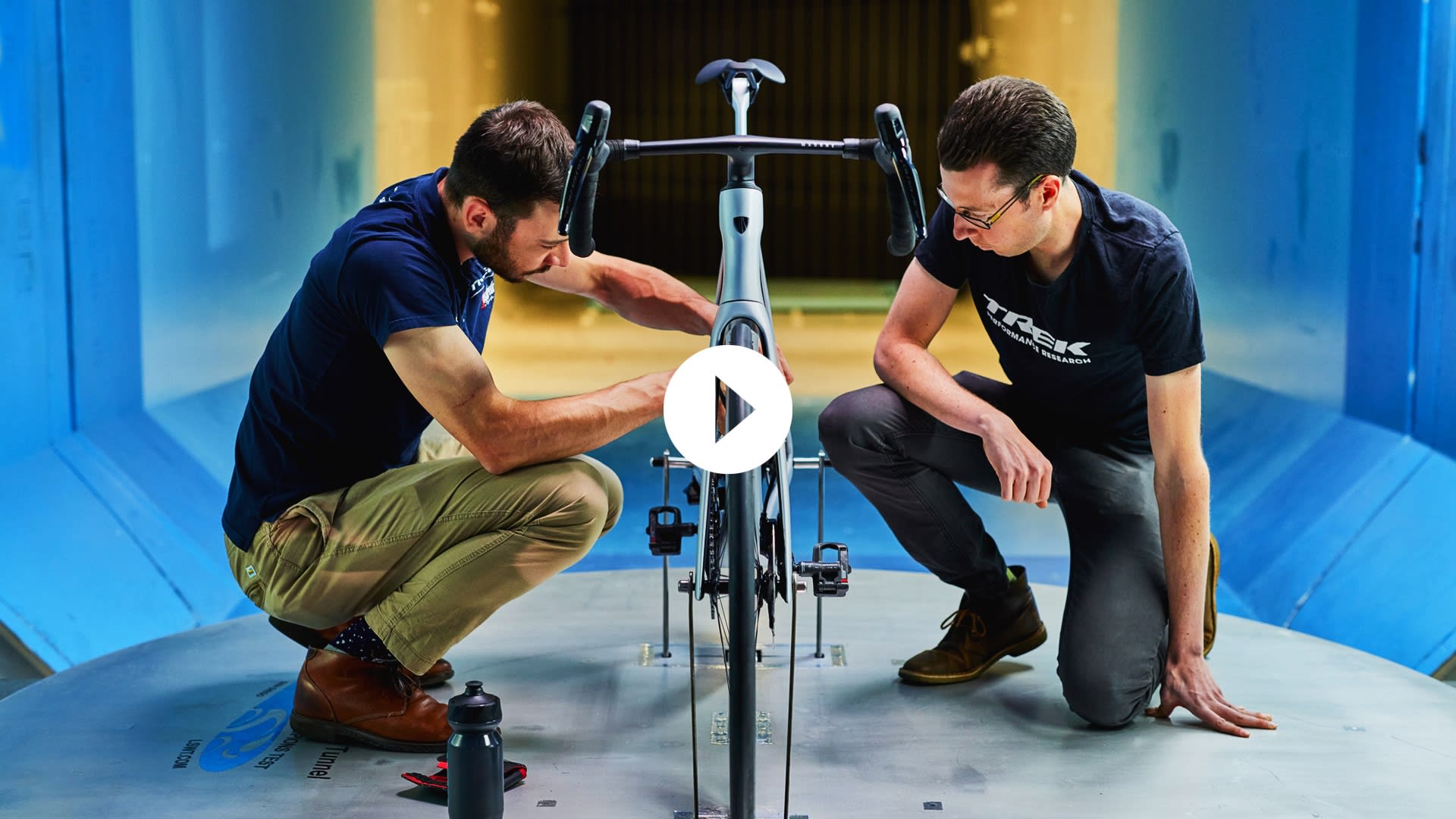
Pure race pedigree Informed by the world’s best cyclists The Madone SLR was rigorously tested with the men’s and women’s Trek-Segafredo race teams to create a completely redesigned bike that’s faster, lighter and fit for the biggest events on the cycling calendar, including the Tour de France and the first-ever Tour de France Femmes.
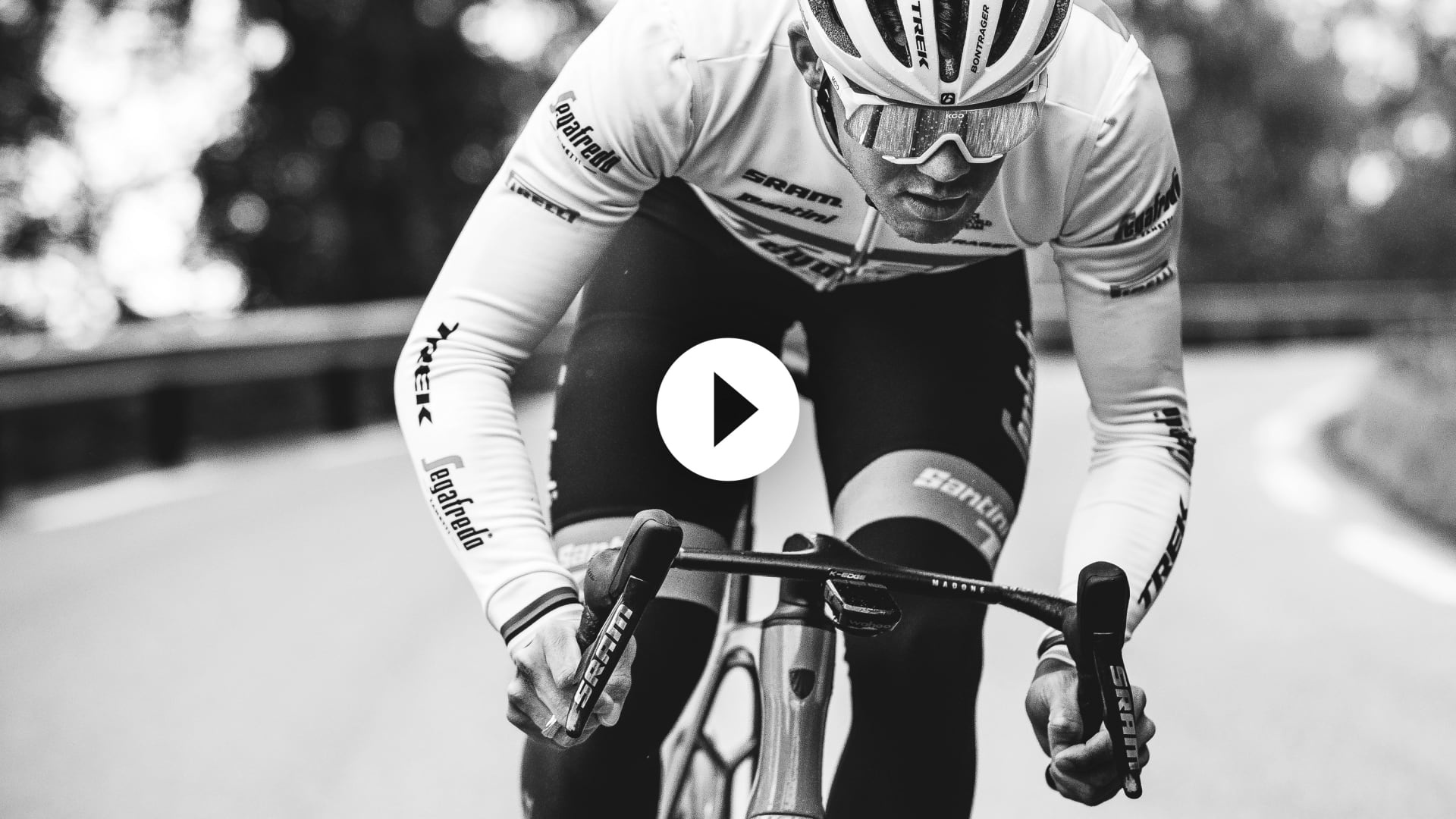
The new Madone SL Gen 7 offers the same revolutionary road race technology as the seventh-generation Madone SLR at a more accessible price point, thanks to a 500 Series OCLV Carbon frame and a two-piece flared RSL handlebar and stem. It’s the ultimate race bike, now available to more riders than ever. Our fastest and lightest Madone SL ever
Nearly 300 grams lighter*
54 seconds/hour faster* .
*When compared to Madone SL Gen 6 at 45 km/h
Choose your Madone
Madone Gen 6
The original industry-disrupting superbike. -Adjustable top tube IsoSpeed for a smoother ride -Traditional non-flared two-piece bar + stem -Grand Tour-winning aero tube shaping -Madone performance at a better value
Madone Gen 7
Built on a legacy of superbikes, Madone Gen 7 is our fastest and lightest Madone disc ever. -Lightweight, never-before-seen IsoFlow compliance tech -Flared aero-optimised bar (one-piece bar/stem on SLR, two-piece bar + stem on SL) -All-new ultra-fast aero tube shaping -Faster and lighter
- MAGAZINE OFFERS
- BIKE INSURANCE
- Best Products
- Maintenance
- Accessories
- Long-Term Reviews
- BikeRadar Podcast
- First Look Friday
- Bike of the Week
- Tech Features
- Routes and Rides
- Bike Galleries
- BikeRadar Bargains
- Buyer's Guides
- Fitness & Training
- Sizing & Fit
- Mountain Biking UK
- Cycling Plus
Trek Madone 9.0 review
A magic carpet ride — if you can fit within the parameters
Ben Delaney / Immediate Media
Ben Delaney
Tangibly fast and blatantly comfortable, very good braking for aero calipers, well-thought-out integration
Steep price, tight fit parameters, toe overlap
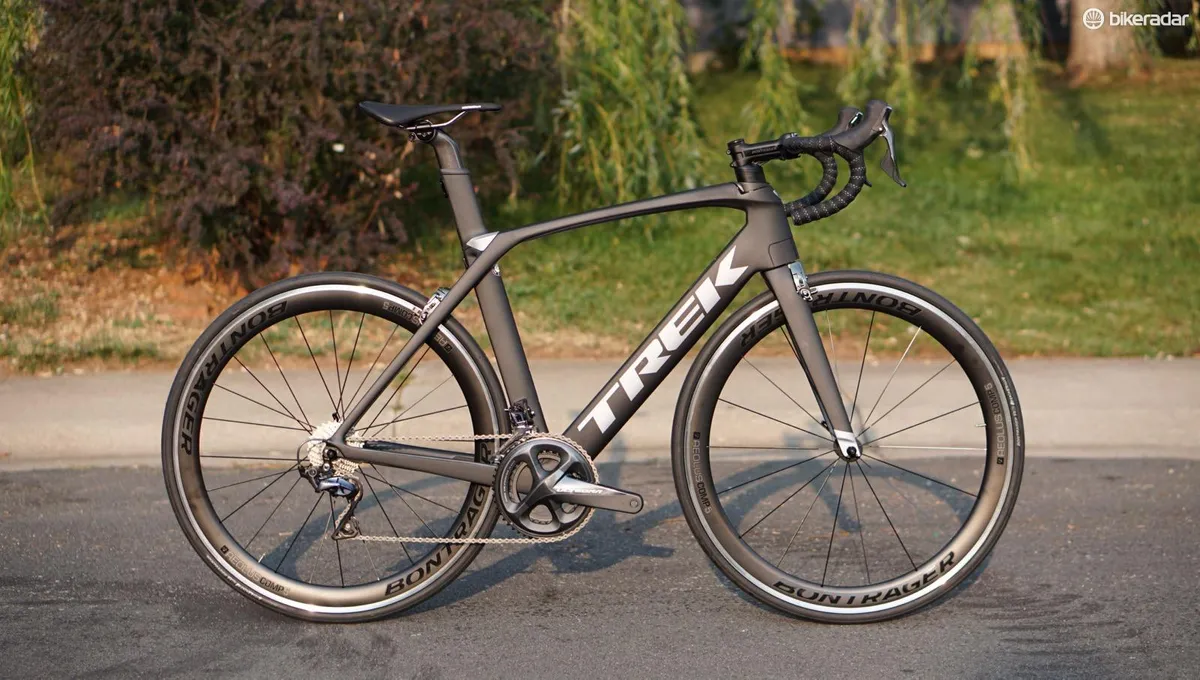
The Trek Madone is the most comfortable aero bike I've ridden by a long shot, and its ultra-clean front end and massive, sculpted tubing deliver not only a fast but a luxuriously quiet ride. There are no sloppy cables whistling in the wind here.
The catch? This magic carpet comes with a tight fit window: the front end is a touch high for a race bike, the seatmast's vertical adjustment is limited, and the front wheel has toe overlap and a limited turn radius. But if you fit, you will fly.
- Tunnel test video: How slippery should your aero road bars be?
- How to ruin an aero road helmet (don't do this!)
- 10 of the best deep aero wheels lab tested
Trek Madone 9.0 highlights
- Same frame and fork as $12,000 / £12,000 / AU$13,499 Madone 9.9
- Normal stem and adjustable aero handlebar
- Shimano Ultegra group with Madone Aero brakes
- Bontrager Aeolus Comp Tubeless Ready 50mm wheels
- 50-62cm sizes, four color options
- $3,999 / £3,500 / AU$5,499
One Madone that breaks (a little) free of certain fit constraints
In late 2015 Trek overhauled the Madone as an ultra-aero race machine, with not only cables but the brakes themselves hidden from the wind. The bike received plaudits from several cycling outlets includin g BikeRadar for its aero performance and its comfort, thanks largely to Trek's IsoSpeed flex design, which allows the seat tube and seatmast to flex as one.
But while the bike managed to avoid the typical pitfall of early aero bikes — they're fast, but they ain't comfy — it did proceed with a typical aero compromise of ergonomic adjustability in favor of an ultra-clean integrated bar/stem that is demonstrably faster.
For context, most major companies with a high-end aero bike sell it with some form of integrated bar/stem, for the same reason: it's aerodynamically faster than a round bar and normal stem by a significant margin. Most companies claim at least a 4-watt improvement. (A good aero bike has a total drag number in the 70-watt range.)
And while integrated bar/stem cockpits work well for many riders, some people would prefer particular bar shapes, or bar angles, or at least the ability to make changes. With an integrated design, you get what you get.
The Madone 9.0 is the first Madone to come with separate bar and stem components. Yes, it's marginally slower in a wind tunnel, but you can easily adjust the bar angle or, like I did, replace the stock stem as needed.
Front and rear fit constraints — versus the competition
Like most of the other Madone bikes, the 9.0 comes in Trek's H2 fit. The lower H1 fit is only available in Project One, which adds $1,500 to the price.
As such, the Madone 9.0 has a slightly taller stack height than other aero bikes. Stack is the vertical difference between the top of the head tube and the center of the bottom bracket. Front-end height comparisons are often done with head-tube measurements, but this doesn't account for differences in various bikes' bottom bracket heights.
For comparison in size 56cm bikes, Canyon's Aeroad has a stack of 55cm, Specialized's Venge ViAS a 56.4cm and Cervélo's S5 a 56.5cm to the Madone's 58.2cm.
All the Madone sizes have a relatively tight saddle adjustment window. The 56cm bike has a saddle height range of 67-76cm.
For me, at 6ft with short legs, I had the saddle all the way up to 76cm and a 120cm stem all the way down, and would have appreciated another centimeter or two of handlebar drop. Fit, of course, is highly personal — just be sure the bike always fits you, whatever it is!
Aero brakes: decent power and, gasp, a delight to work on
Trek isn't the first company to experiment with hiding the brake calipers from the wind, but I believe they have done the best job thus far. By extending the frame's front section to house the front brake cable, Trek reduced drag substantially compared with bolting a standard caliper on the front of the fork.
The little cuckoo-clock panels flip open when you turn the bars, allowing the brake and housing room to move. (No cuckoo bird pops out, though, unfortunately.)
I hate rim calipers positioned underneath a frame's bottom bracket. At best, they are a chore to work on, and quickly gather grime. At worst, they are a literal drag, causing brake-pad rub when out of the saddle. Trek keeps the Madone's rear brake where it should be — up on the seatstays.
The power is decent for a rim brake. A Dura-Ace caliper it ain't, but modulation is predictable. The spectrum of aero brakes runs from horrible/dangerous to pretty good. These are pretty good. I tested the bike quite a bit with carbon wheels as well, where the power is adequate when used with SwissStop pads.
Perhaps most surprising to me was how easy it is to work on the brakes. Swapping and then adjusting the pads is easier than on most standard calipers. Seriously. In the absence of a barrel adjuster, Trek has a screw to adjust width on each side, and another to adjust toe angle.
Ride quality: a magic carpet
By now, you have probably seen enough aero-drag graphs and charts to understand that aero shapes are faster than round shapes, especially at higher speeds. I did not take the Madone into a wind tunnel, but my friend Dan Cavallari at VeloNews did. You can get his data and conclusions versus the Specialized Venge ViAS here . I did take the bike out for a few hundred miles, often on fast group rides and solo jaunts, and the thing is tangibly faster than a round-tubed bike with box-section wheels. During the year I switch between a number of test bikes, and the back-to-back rides really highlight differences.
Two things stand out with the Madone. It's fast! (Of course, your body position is the major factor here. But with that normalized, the Madone is perceptibly quick.) And two, it is more comfortable than many standard road bikes, never mind aero bikes, thanks to the full-flexing seatmast and seat tube.
I have an older Scott Foil that I love racing crits on, and while I ride it on dirt roads, it's not my first choice for mixed-surface riding. The Madone, on the other hand, I'd take on any ride.
With Trek's stout BB90 chassis, you still get plenty of firm pedaling efficiency when in and out of the saddle.
The wheel depth of the Bontrager Aerolus Comp 5's is manageable in crosswinds. I rode the bike on many gusty days and did a few days with Mavic's new 65mm Comete Pro Carbon SL tubeless wheels . On one fast group ride, I managed to plow straight into a pothole deep enough to crack the Mavic rear rim . After checking everything out — and opening the rim brake caliper — I rode back home without incident. Would I have crashed on a stiffer aero bike? Who knows. But I can say it is nice to have a forgiving frame underneath you when unexpected bumps and holes appear.

Wheels and components
The Bontrager Aeolus Comp 5 wheels can be set up tubeless but come with 25mm standard clinchers and tubes. Although not as light as all-carbon hoops, the aerodynamics of the metal-rim-with-carbon-fairing design are very similar. And you get the more consistent braking of an alloy track. A downside is that they can take in water at the spoke holes. (There is a hole on the side to release the water.)
Current-edition Shimano Ultegra continues the Japanese company's fine tradition of an excellent second-tier group that for all intents and purpose functions very much like Dura-Ace but with a few more grams. My one gripe with the mechanical Ultegra is how the inner shift lever on the lefthand control can pop slightly outside the primary brake lever on rattling roads. It doesn't affect performance at all, but it's annoying. Dura-Ace levers don't do this.
One curious spec choice is the compact 50/34t crank. When paired with the 11-28t cassette this is a great everyday setup, but it seems like amateur racers, in particular, would be drawn to such an aero bike. They might want, if not necessarily need, a 52/36t crankset. If this is a concern, it is likely that your local Trek dealer could swap it out for you. I suspect that, like the H2 geometry, Trek studies customer fit data carefully, and makes decisions based on the bulk of rider numbers.
Bottom line: Certainly the most comfortable and among the fastest aero bikes on the market
The Trek Madone fuses two seemingly incompatible traits: it is a very fast and very comfortable bike. The 9.0 build is the most inexpensive — but still not cheap — model, and the only one with separate and therefore adjustable stem and handlebar.
If you want to look at third-party aero numbers, check out Dan Cavallari's VeloNews piece where he put the top-end Madone against the top-end Specialized Venge ViAS in the A2 Wind Tunnel and found the Venge to be faster . For context, A2 found both to be faster than Cervélo's S5.
The fit, as discussed, is Trek's H2 geometry, which is slightly higher at the front end than other aero bikes. As with Trek's Emonda, a lot of riders will get toe overlap on the Madone, because of its short and sharp front end. So investigate carefully before you buy — but if everything fits, I doubt you will be able to find a bike as fast and comfortable as this one.
Share this article

Contributor

- Terms & Conditions
- Subscribe to our magazines
- Manage preferences

Subscribe to my YouTube channel for video reviews.
Trek Madone Bikes Compared: Which One to Choose?
CyclistsHub is supported by its readers. We may receive a commission if you buy products using our links.
In this article, I’ll help you navigate the Trek Madone aero road bikes by comparing the Madone SL 6 to SLR 9 .
You will also learn:
- Who are they best suited for?
- About the differences between each model and Gen 6 vs. Gen 7.
- Why I think you shouldn’t buy Trek Madone with SRAM groupset.
Plus, I’ll tell you which model gives you the best value for your money to help make your decision easier.
KEY TAKEAWAY
Trek Madone bikes are ideal for flats and rolling terrains. They are the most aero bike family of all Trek road bikes . The models differ in components (e.g., electronic shifting or wheels) and frames. The more expensive ones are usually lighter and have a higher-grade carbon frame, but usually diminishing returns.
This article compares Trek Madone Gen 6 and 7. The main difference between Madone Gen 6 and Gen 7 is that Gen 6 has IsoSpeed decoupler, while Gen 7 has IsoFlow.
Trek Madone SL 6 vs. SL 7 vs. SLR 6 vs. SLR 7 vs. SLR 9
The following table summarizes the main differences between all Madone bikes.
Madone Pros & Cons Summary
I summarized the pros & cons of the Madone series below.
Madone Pros
- Faster than standard road bikes thanks to the aero frame
- Madone Gen 7 stands out from the crowd thanks to the IsoFlow
- Racing geometry
- Availability in multiple sizes and colors
- Integrated cable routing
- Lifetime warranty
Madone Cons
- Heavier than Émonda road bikes
- More expensive than non-aero road bikes
- No aluminum models are available
- Narrow tire clearance (28mm)
Madone Main Features
Let me now explain the most important features of the Trek Madone aero bikes.
Frame and Geometry
The Madone bikes are part of Trek’s road bike lineup . They’re made of carbon. No aluminum version of the Madone is available.

The names of the bikes have abbreviations that refer to the type of carbon used for the frame:
- SL are bikes with 500 series OCLV* carbon (mid-range).
- SLR are bikes with 800 series OCLV carbon (high-end).
*OCLV carbon is Trek’s patented carbon fiber process ( learn more ).
SL (Gen 6) frames are heavier than SLR (Gen 7), mainly due to the IsoSpeed vs. IsoFlow ( learn more ).
The bikes are available in many sizes (47-62) and colors. They have a relatively relaxed geometry compared to the Cervelo S5 but are almost identical to the Cannondale SystemSix.
Aerodynamics
Aerodynamics evaluation is a challenging discipline because it requires a lot of resources. No extensive independent database is available that compares the speed of different aero wheels.
In Trek’s whitepaper , I learned that the Madone Gen 7 is 19W faster than Gen 6 at 45 km/h.

However, it’s hard to compare it with other bikes. But it’s rumored that Madone is among the fastest aero bikes.
For instance, in Cannondale’s whitepaper , there’s a comparison of Cannondale SystemSix (one of the fastest aero bikes) with Madone 9.9. Madone was only slightly worse.
Wheels and Tires
On some Madone models, the wheels may be different, but typically, they come with Bontrager Aeolus Pro 51 wheels.
Surprisingly, the front and rear wheels have the same rim depth. Other aero bike manufacturers often use deeper wheels in the rear and shallower ones in the front.
The same goes for tires. Madones come with 25mm tires in both the front and rear, but it’s common for competitors’ bikes to have 25mm tires in the front and 28mm tires in the rear.
Remember, the wheels are tubeless-ready, but the tires are clinchers.
Unsurprisingly, the Madone bikes have a 2X drivetrain, as is customary for road bikes.
Trek fits them with Shimano and SRAM groupsets, and the number in the bike name indicates the groupset.
- Models ending with 6 use Shimano Ultegra , 105 Di2 (R7100) or SRAM Rival AXS groupsets.
- Models ending with 7 use Shimano Ultegra Di2 (R8100) or SRAM Force AXS groupsets.
- Models ending with 9 use Shimano Dura-Ace Di2 (R9200) or SRAM Red AXS groupsets.

Interestingly, the Madones with SRAM are heavier than the Madones of the same series with the Shimano groupset. In addition, the Shimano bikes are also cheaper.
This is somewhat strange because Shimano retail prices are higher than SRAM. That’s why I recommend choosing Trek bikes with Shimano groupsets unless you prefer SRAM.
IsoSpeed vs. IsoFlow
Undoubtedly, IsoSpeed and IsoFlow have become unique features that make Madone stand out from the crowd.
The IsoSpeed decoupler aimed to improve riding comfort by absorbing road vibrations. Unfortunately, it added weight to the bike.

The 7th generation Madone took people’s breath away. IsoFlow is a significant design change from the traditional bike appearance, but it’s supposed to improve both riding comfort and aerodynamics.
On the other hand, some have expressed opinions that the change in shape from a classic triangle to a quadrilateral will inherently reduce the overall frame stiffness. Learn more in the following video.

So, which Trek Madone bike is the best?
If you’re considering buying a Madone, I suggest going for a model with a Shimano groupset. They tend to be lighter and less expensive than the equivalent SRAM models.
Consider the Madone SL 6 or 7 (Gen 7) for the best value for money. You will get an adjustable cockpit (which you won’t get with SLR Gen 7), Gen 7 frame (IsoFlow), and Shimano 105 Di2 or Ultegra Di2.
The only sacrifices you make are the lower-grade carbon, higher weight, and slightly worse aerodynamics and aesthetics due to the semi-integrated cockpit.
Trek Madone FAQ
Trek Madone bikes are for pro cyclists, competitive roadies, and enthusiast cyclists who want a unique-looking but fast road bike. They are ideal for flats, rolling terrain, and fast-paced rides (races, criteriums, etc.).
The main differences between Madone Gen 6 and Gen 7 are that Gen 6 has IsoSpeed decoupler, while Gen 7 has IsoFlow. Gen 7 frames are lighter and 19W faster at 45km/h ( source ). They also look different due to the significant design change. Trek introduced SL 6 and SL 7 Gen 7 with an adjustable cockpit in August 2023. These bikes are more affordable than the SLX versions.
The main difference between Madone and Émonda is that Madone is a pure aero road bike, while Émonda is a lightweight road bike for climbing. For more detailed info, please check out my comparison of Madone vs. Émonda .
The main difference between Madone and Domane is that Madone is a pure aero road bike, while Domane is an endurance road bike with wider tire clearance, also suitable for off-road adventures. Learn more in my Madone vs. Domane comparison.
About The Author
Petr Minarik
Leave a comment cancel reply.
Your email address will not be published. Required fields are marked *
Save my name, email, and website in this browser for the next time I comment.
Start typing and press enter to search
Trek updates Madone SL models with T47 bottom bracket and new colors

- Click to share on Facebook (Opens in new window)
- Click to email a link to a friend (Opens in new window)
For those that live for speed, dependable bottom bracket performance, and love a good racing red color scheme — boy, do we have news for you. Trek announced a few updates to its world-class race machine, the Madone SL. Though the geometry, tube shapes, and general frame remain the same, one key feature receives a much-appreciated update.
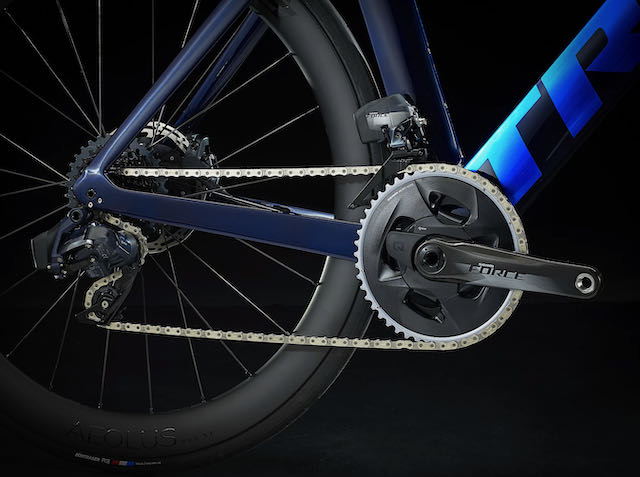
Trek seems to be swapping its long-held BB90 standard to a more widely appreciated BB-T47 bottom bracket. The update has already happened for the Domane, Boone, Crocket , Emonda , even the Madone SLR . Trek seems to be keeping with the Pressfit 92 MTB for its off-road line and have had success with less creaking and overall bearing issues.

Why the change?
The BB90 standard is a bottom bracket standard that the company has used for quite some time and, at its introduction, was quite inventive. The BB90 utilized every millimeter of the bottom bracket width and it sculpted directly into the frame. The idea was for a stiffer and more responsive bike overall.

The problem was the BB90 bearings that went into the frame weren’t a press-fit, more of a “push-in by hand.” The bearings are easy to install, and if they stay silent, it’s a fantastic design. Unfortunately, these bearings would get a tiny bit of wiggle room, and the creaking would set in. The only remedy was/is a bit of Loctite and some patience. The BB90 standard is also somewhat limiting for crank spindles, not allowing for the use of 30mm spindles.
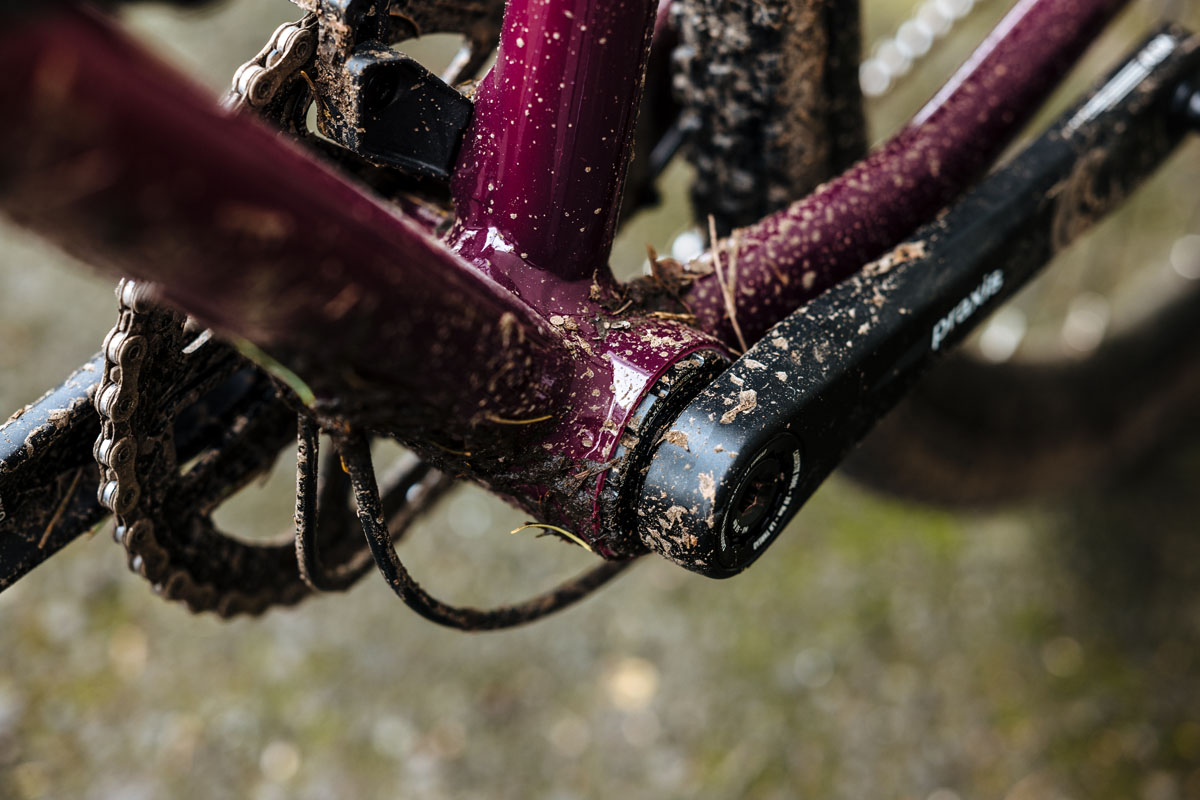
The BB-T47 ( introduced in 2015 by Chris King ) is similar in size but offers better compatibility with larger spindle cranks and utilizes a threaded system for loading. The idea is a super-sized version of the standard BSA threaded bottom bracket that is user-friendly and easily serviceable. Most importantly, the frame and cup interface is far less susceptible to creaking.

What models receive the update?
The Trek Madone SLs that will come with the new BB-T47 bottom brackets are the SL6 – with mechanical Ultegera and the SL7, which arrives with SRAM Force eTap AXS.
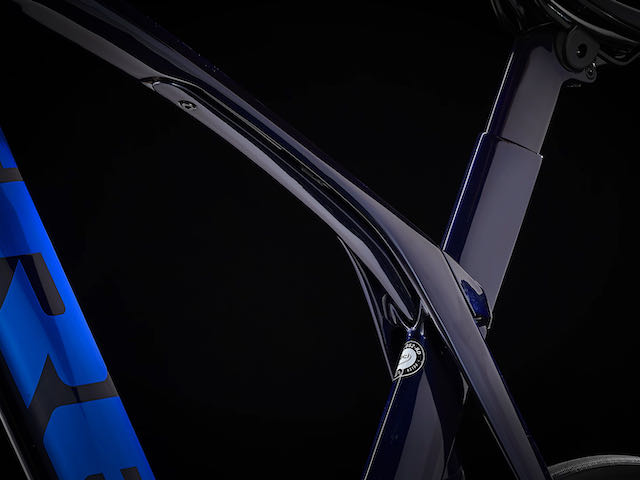
The Trek Madone SL6 and SL7 models come in Treks 500 Series OCLV carbon, same as the 2021 models — saving the OCLV 800 for the Madone SLR.
2022 Trek Madone SL models and pricing
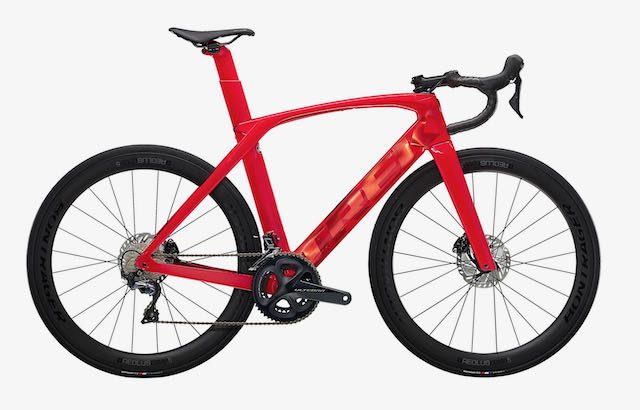
The updated Madone SL6 comes with a full Shimano Ultegra groupset and Bontrager Carbon Aeolus Comp tubeless wheels. It features the same geometry and IsoSpeed controls of the 2021 model, adding the new BB-T47 and Trek’s new Viper Red color scheme.
- Price: $4700
- Sizes: 50, 52, 54, 56, 58, 60, 62
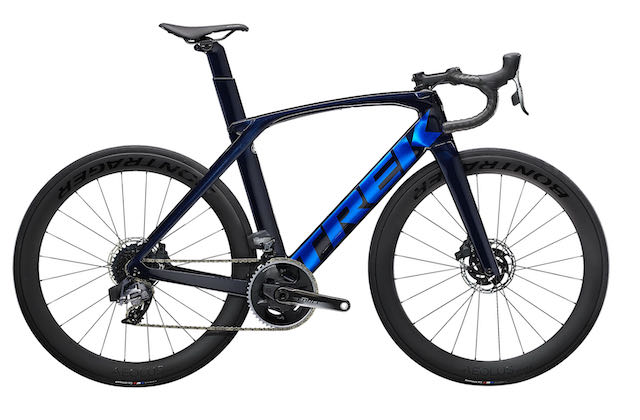
The Madone SL7 comes eTap ready with a full SRAM Force eTap groupset — power meter included. The Deep Dark Blue bike spins on Bontrager’s new Aeolus Pro 51 tubeless wheels and Bontrager R3 tires. Like the SL6, the Madone SL7 comes with the same IsoSpeed trappings and Kammtail Virtual Foil tech as the 2021 models.
- Price: $7000

Availability
The updated Trek Madone models are set to ship ASAP. We suggest checking the Trek Bikes website for real-time availability or contact your local Trek shop for updates.
Jordan Villella is the Racing Tech Editor for BikeRumor.com, specializing in cross-country mountain, gravel, road, and cyclocross. He has written about bicycles and bike culture for over fifteen years with no signs of stopping.
Before BikeRumor, Jordan raced professionally and wrote for MTBR and the now-defunct Dirt Rag Magazine. He’s covered the World Championships, World Cups, and everything in between — where he loves to report what people are riding.
Based in Pittsburgh, PA, Jordan coaches cyclists of all abilities with Cycle-Smart ; you can find him racing bikes around North America and adventuring with his family.
For an inside look at his review rides follow him on Strava .
This site uses Akismet to reduce spam. Learn how your comment data is processed .
BB-T47 nice! TREK got the memo…
What again was the gain? Weight loss for some as many power meters do not play well with the BB region….still cant figure out what was fixed (some will say frame stiffness and then offset that with a lower PSI tire or some nice opioids for their lower lumbar pain).
Threads can take up a certain amount of tolerance. Press fits require much greater precision. The bottom bracket maker can specify the level of interference fit they want between bearing and cup, and when it’s screwed into the frame, that won’t change. Any press fit system with bearings in the frame gives the bearing some compression with the installation into the frame, unless the fit is nearly a slip fit and then requires thread locker. The systems where the bearings are outboard try to cam out and are therefore much more prone to creaks. So-called “thread fit” bottom brackets rarely solve anything and introduce their own issues. T47 is a decent way to do it. Personally, I wish they went with a much larger, much more coarse thread so that the threads could be cut (or molded) straight into the carbon.
But why not just use BSA? Specialized (among many others) have done just that (again)
To me, using threaded bottom brackets is the bike industry being lazy, not fixing the tolerance and quality assurance problem they have in their otherwise rather expensive frames. All other industries do press fit, it’s the standard way to fit bearings. Press fit done right would work great.
For amateur mechanics sure threaded bottom brackets are easier to work with. Bikes have become much more advanced with hydraulics and internal routing etc, if you want a simple bike to work with you shouldn’t have modern high end bike at all, except for wireless derailleurs of course :-).
Just get a Hambini bottom bracket and be done with it. I find it funny people think that carbon can be held to the same tolerances as something you could machine perfectly round, let metal of some sort.
Does Hambini offer anything for bb90? There’s no room for adjustment.
I asked by local about the SL7 model in 58 or 60 — eta is May 2022. I suppose that can be considered ASAP.
lol! This was going to be my comment as well… I.e., ow on earth would the bikes be “ready to ship” when no one can get a bike right now.
Oh, and as for King…if the man had not made such a perfect BB and Headset (granted, HS somewhat a copy of a Mavic)…well, they would not last -forever- and we would not keep them forever 🙂
Now, some of my other BB’s, they just go to pot after a few months and I have to buy new ;-I
I was selling (1″ threaded) Chris King headsets in 1981. Exactly which Mavic headset do you think he copied?
This is a significant improvement over press fit bottom brackets that have to be pressed in and out which is just a pain in the derrière. The new colors are great, but Trek still needs to reduce their font size and come up with an easy recongizabe design language like Ferrari.
Wow, talk about doubling down on the logo size…
Maybe it’s just me, but I kind of like big logos on race bikes, it makes them look more like race bikes. Just like race cars have big logos and text all over.
BSA is design and spec limiting. Can’t use larger BB spindles, loss of bb shell width for chain stay spacing, downtube width.
BSA30 exists. Not sure what’s bigger than 30mm spindles out there.
BSA with 30 mm spindle is a compromise, as you need a special type of bearing which wears out fast due to extra small balls. So if you want 30 mm spindle, T47 is certainly better.
@Seraph Trek is so far in bed with SRAM these days that they can no longer have bottom brackets that are frankly a compromise with almost-30mm DUB.
So that leaves the Checkpoint as Trek’s only mainstream model still running BB90?
Having Trek Madone SL6 with BB90.. would like to replace it with SRam Force Etap -Axs 12 speed crank, which BB is compatable
Follow Us On
Subscribe Now
Sign up to receive BikeRumor content direct to your inbox.
Welcome to Escape Collective. Please select your language.
Please note that this is an automated translation and it will not be perfect. All articles have been written in English and if anything appears to not make sense, please double check in English.

2024 Trek Madone SL 7 review: This is the one to get
The flagship Madone is lighter and very slightly more aero, but also more than twice as expensive.

Second-tier models – ones that look the same, but use less-expensive materials and parts to lower the cost – typically aren’t nearly as exciting as their more premium cousins. But in the case of the Trek Madone SL vs. the Madone SLR, the difference in performance is so small – and the difference in cost so dramatic – that it’s hard not to consider the “lesser” version to be the one to get, even if you have the money for the flagship model.
The short of it: The same cutting-edge aerodynamic performance of Trek’s flagship Madone SLR, distilled into a much more affordable package. Good stuff: Heaps lighter than before, tangibly speedy, surprisingly good ride quality, superb handling, lots of tire clearance, user-friendly two-piece cockpit, sharp lines. Bad stuff: Polarizing IsoFlow aesthetics, poor weathersealing, narrow wheels and tires.
An aero primer
Trek went perhaps a little too far down the “aero and comfy” rabbit hole with the 6th-generation Madone, which was impressive in the wind tunnel and surprisingly comfortable to ride, but also among the heavier options in the category what with its complicated (and hefty) IsoSpeed pivoting seatmast design. With the latest iteration of the Madone launched last June, Trek supposedly improved the bike’s aerodynamic performance while also simplifying the structure, ditching IsoSpeed in favor of an even more radical-looking seat cluster configuration called IsoFlow.
In short, IsoFlow comprises a giant hole where the seat cluster would normally be. The seat tube stops just shy of its normal height, the seatstays bypass that area entirely and connect further forward on the top tube, and the semi-integrated seatmast is now cantilevered off the back of the top tube like the business end of an ice hockey stick.
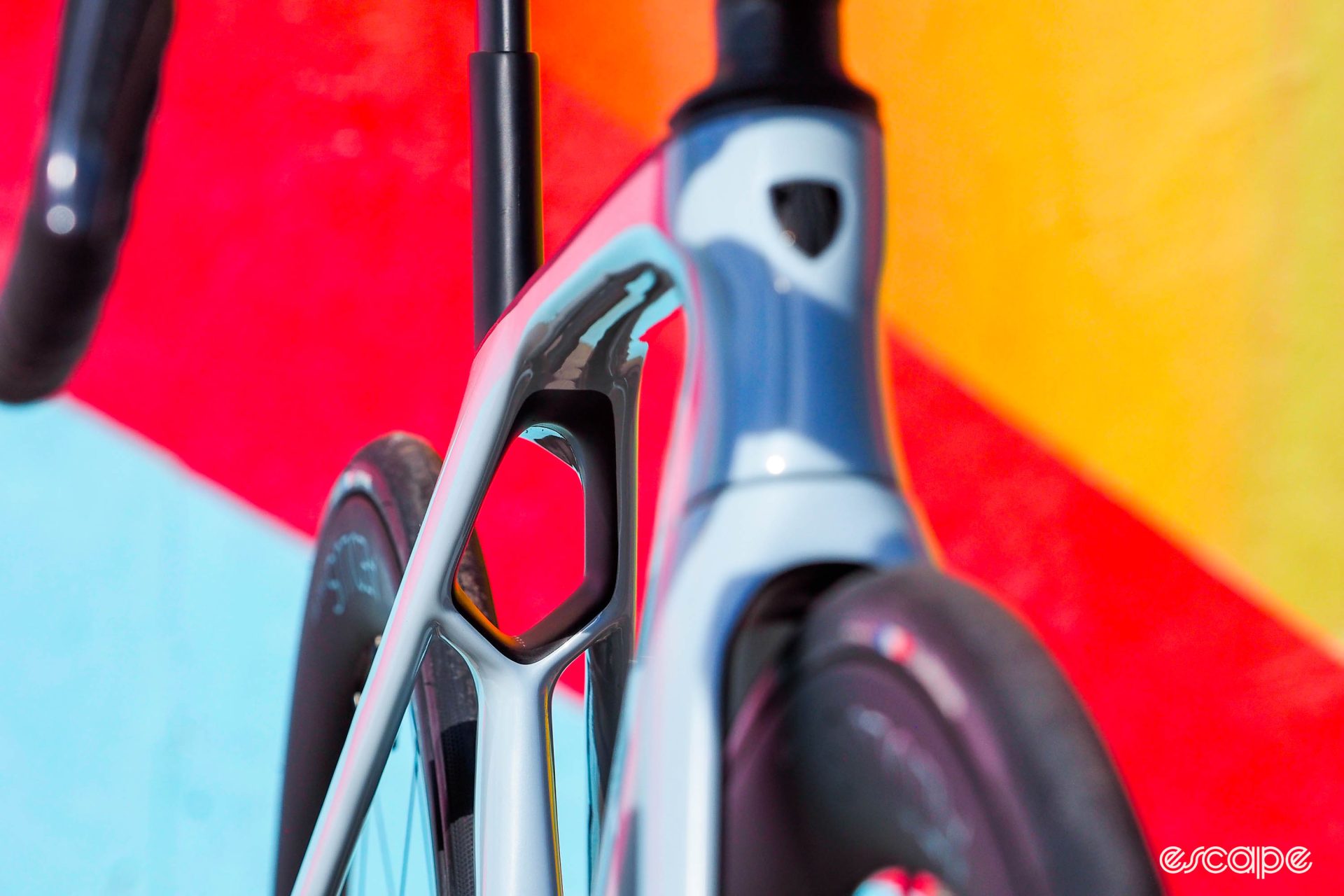
Trek claims IsoFlow yields smoother airflow through that area, saves almost 150 g relative to the outgoing Madone (for the flagship SLR trim, at least), and – thanks to some clever carbon tuning in that area – also supposedly provides a better ride quality than you’d otherwise expect from such chunky frame proportions.
Trek has been one of the biggest proponents of Kamm-tail tube profiles since first using it on the Speed Concept way back in 2009, and those flat-backed shapes are very much alive and well on the latest Madone – if anything, they’re deeper than ever thanks to recent revisions in the UCI technical guidelines. The down tube, seat tube, seatstays, and fork blades are all more aggressively shaped than ever, and the head tube and cockpit areas are particularly sleek so as to keep air flowing cleanly over the carefully sculpted surfaces.
The revised frame shape only accounts for about half of the new Madone’s claimed aerodynamic performance gains, however. The other half comes from the rider – or, more specifically, handlebars that have been radically narrowed by about 3 cm across the board in order to place the rider in a more aerodynamic position.
Taking all of these factors together, Trek is touting some bold performance gains, saying the 7th-generation Madone frameset module (including the frame, fork, cockpit, and seatpost) is not only about 300 g lighter in total than the 6th-generation one, but also about 19 watts more efficient aerodynamically in a wind tunnel (at 45 km/h), which Trek says translates to a 60-second advantage per hour at that speed.
A single letter with small differences
All of those changes sound well and good, but keep in mind that when those announcements were made in June 2022, they only applied to the flagship Madone SLR models, whose retail prices start at US$8,000 / AU$11,800 / £7,600 / €8,200 (for a Shimano 105 Di2 build!) and top out at a whopping US$13,200 / AU$19,000 / £14,500 / €15,700 with a SRAM Red AXS groupset. More power to you if you can swing that kind of cash, but for most performance-minded riders, that’s just not in the cards.
Trek has for years offered a less-expensive version in the Madone SL, but given how the 6th-generation Madone SLR was already overweight, the Madone SL was a veritable boat anchor. For example, a sample I tested a couple of years ago with a mid-range SRAM Force AXS wireless groupset and Bontrager’s reasonably light Aeolus Pro 51 wheels came in at a whopping 8.59 kg (18.94 lb), a tough pill to swallow, aero advantage or not.
Thankfully, the weight loss plan introduced with the Madone SLR now also carries over to the recently updated Madone SL. Despite the lower-grade carbon fiber blend here, claimed weight for a 56 cm Madone SL frame is now 1,200 g, plus 476 g for the matching fork. That’s still 208 g more than a comparable Madone SLR frameset, and hardly a featherweight given the selection of sub-800 g options now on the market, but still pretty good all things considered. If you take Trek’s aero claims at their word, those extra grams aren’t going to matter much at all against the stopwatch on most courses, and realistically speaking, the person considering a Madone these days will probably be more concerned about grams of drag.
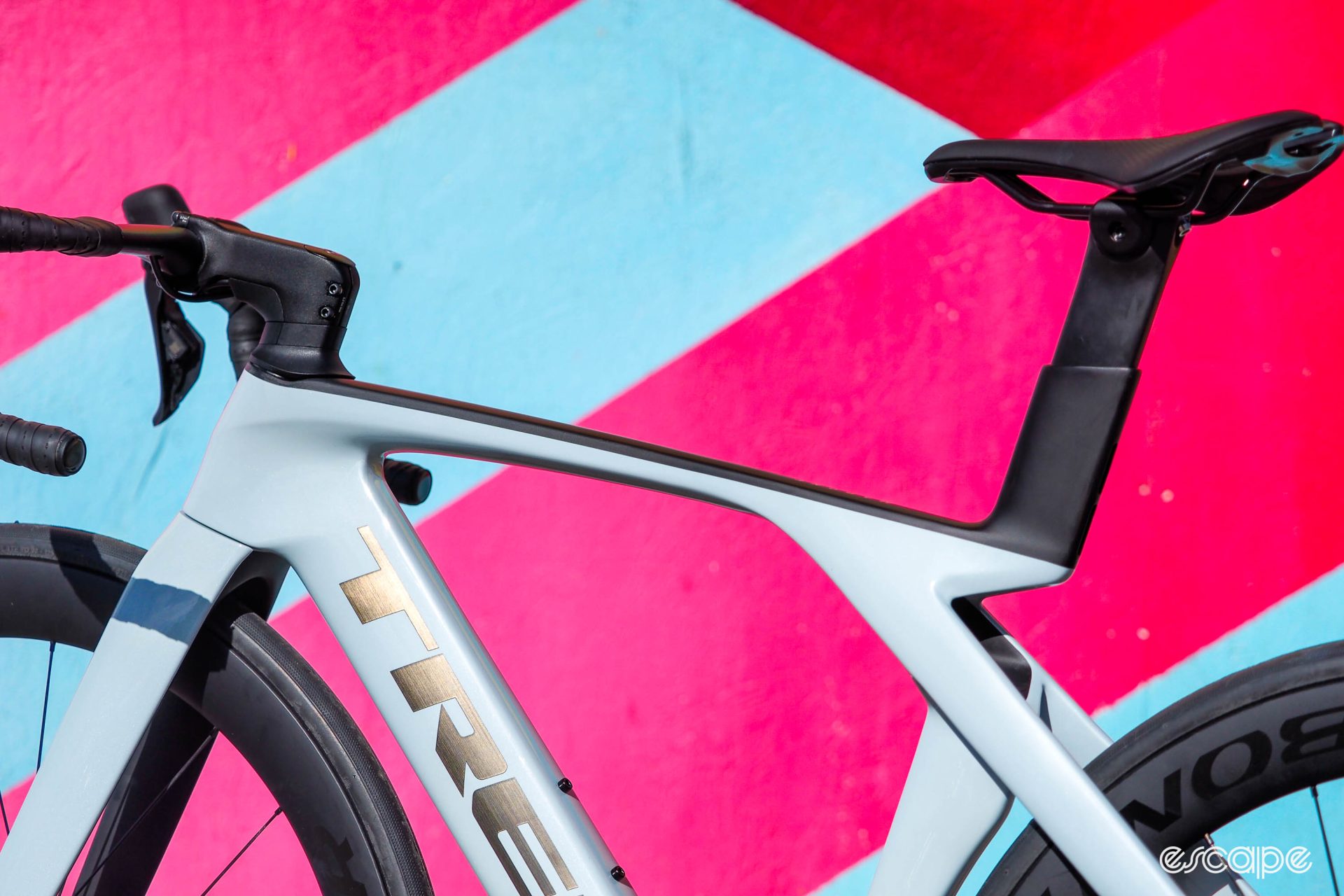
Like with the previous Madone SL, this one again uses the exact same shape as the Madone SLR, so its aerodynamic performance should be identical, with one exception: the cockpit. The Madone SLR uses Trek’s latest one-piece carbon fiber handlebar/stem, but the Madone SL uses a more conventional two-piece setup that includes an aero-focused forged aluminum stem with a separate aero-shaped carbon fiber handlebar. And whereas the hose routing on the Madone SLR is fully internal, it’s hidden – but still largely accessible – on the Madone SL, with the brake hoses peeking out just a bit underneath the bar clamp before ducking away again into a plastic shroud bolted to the underside of the stem.
Trek says this equates to a six-second hit to the Madone SL’s aerodynamic performance relative to the Madone SLR. Don’t worry; I’ll get to that soon enough.

Trek also says there’s a negligible difference in chassis stiffness – less than 5% – and ride quality shouldn’t take much of a hit, either. If anything, the lower grade of carbon fiber in the Madone SL might even make that bike more comfortable than the Madone SLR, not less.
Aside from the different carbon fiber blend and the two-piece cockpit, the rest of the feature list is identical, including Trek’s slightly modified T47 oversized and threaded bottom bracket shell, a built-in chain keeper, and the brand’s now-signature semi-integrated seatmast. Unlike true integrated seatposts, though, this one doesn’t have to be cut and will still squeeze into most standard travel cases, and Trek has gone to great lengths to ensure a proper rider fit. If the included proprietary seatpost doesn’t quite accommodate your position, Trek also offers a longer option – each with 65 mm of total height adjustment – and both are available in 0 mm and 20 mm offsets. Given the rather goofy component dimensions, Trek thankfully has a broad range of dedicated front and rear accessory mounts to accommodate stuff like lights and computers, too.
Both versions are also offered in eight sizes: impressive for a mainstream brand.
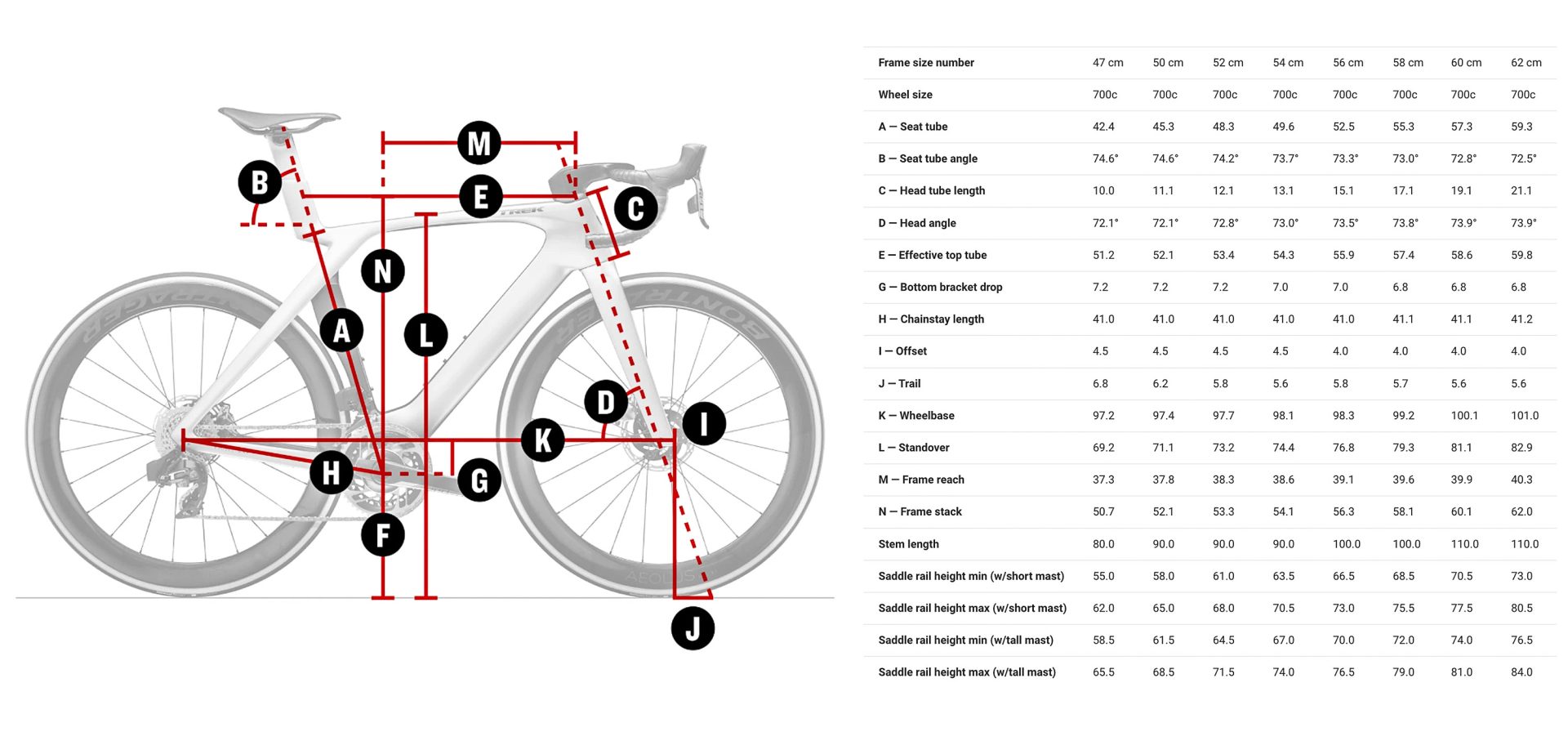
Otherwise, the differences between the Madone SL and Madone SLR simply boil down to more economical build kits.
My Madone SL 7 test sample is the nicer of the two complete Madone SL bikes Trek offers currently, and comes equipped with a complete Shimano Ultegra Di2 2×12 wiredless electronic groupset, Bontrager Aeolus Pro 51 carbon fiber clincher wheels wrapped with 25 mm-wide Bontrager R3 Hard-Case Lite tires, a Trek RCS Pro forged aluminum stem, Bontrager RSL Aero carbon fiber handlebar, and a Bontrager Aeolus Comp snub-nosed saddle.
Actual weight for my 52 cm sample is 8.01 kg (17.66 lb), without pedals or accessories, and retail price is US$6,500 / AU$10,300 / £7,500 / €8,000.
You know what feels fast? Money left over in my pocket
Having fun on a road bike largely revolves around going fast – and holy cow, is the Madone SL fun in that respect.
For however many full-blown aero road bikes I’ve ridden over the years, it’s still shocking every time I get on a particularly good one and can so immediately feel – feel! – how much faster they are. It’s startlingly easy to hit – and hold – high speeds, but it’s also tangibly easier to just casually cruise if that’s what you feel like doing that day. The beauty is that the option to go fast is always there if you want it, and even after however many years I’ve done this, that thrill never goes away.
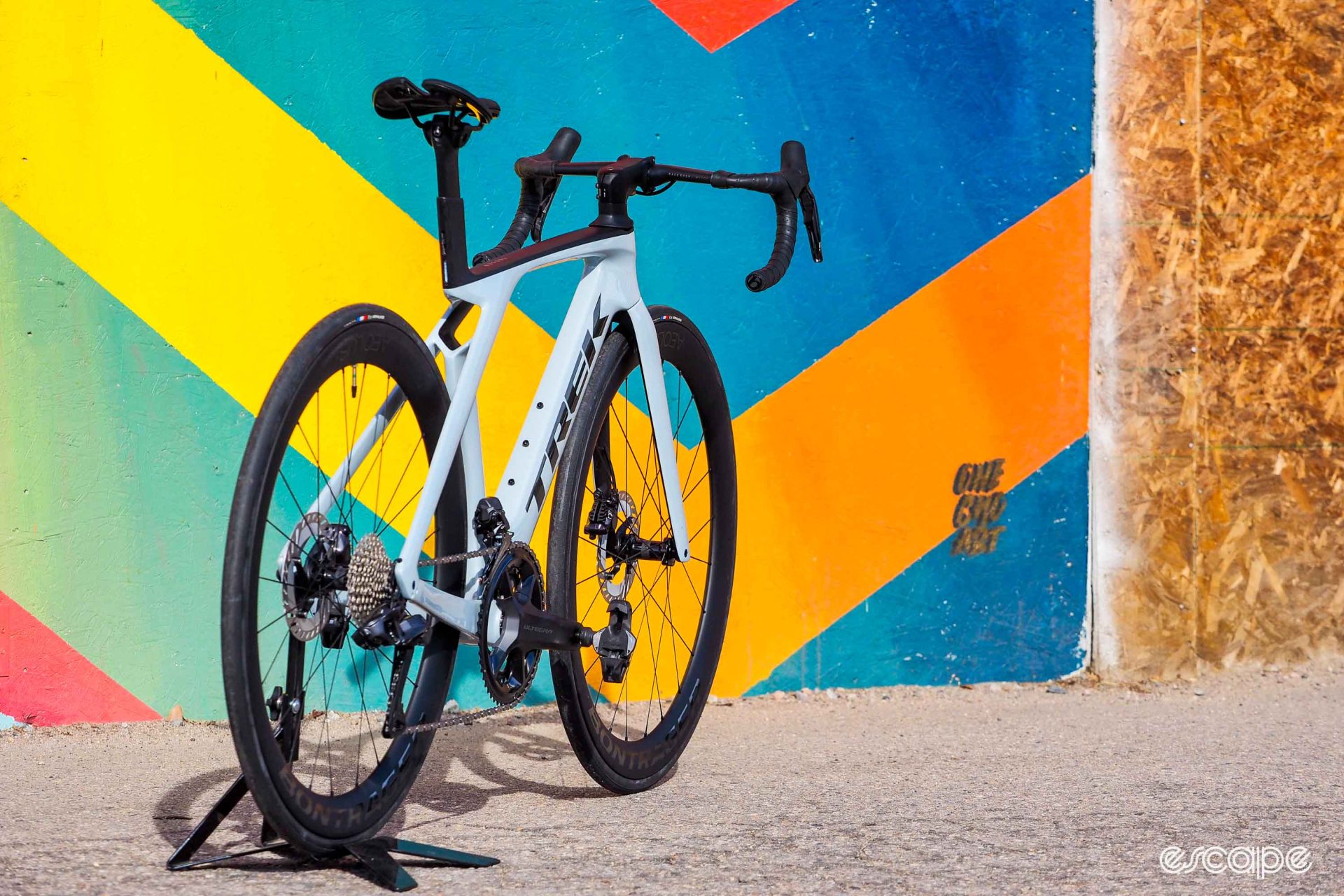
Those huge tube sections and all that material are also put to good use in terms of chassis stiffness. It’s wonderfully responsive when you lay down the watts, and it feels every bit like the race bike it’s supposed to be. High-speed jumps are where the Madone SL excels given that aerodynamic shape, but the combination of that stiffness and the new weight loss make it a surprisingly good partner on steep climbs, too. That rigidity also feels nicely balanced from tip to tail with no section of the frame coming across as more flexible than another. The Madone SL obviously doesn’t feel as light heading uphill as something truly feathery, but sub-8 kg is still pretty darn light, and if speed is truly what you’re after, the aerodynamic benefits should more than make up the difference.
I fully expected my test sample’s 36 cm-wide bars (at the hoods) to feel very weird – and to be fair, they did, but literally only for the first few minutes, after which I almost completely forgot about it. I did miss the additional leverage of my usual 40 cm-wide bars on particularly steep climbs, but that was about it. Consider my eyes opened.

That the Madone SL efficiently cuts through the air and feels fast doing so shouldn’t be a big surprise. The old one was known to be very aerodynamic, and this one is supposedly a big step up from there. But a big aspect of being fast on the road is also being comfortable, and more specifically, that you are able to achieve and maintain an efficient position while also producing a lot of power.
And that’s where the Madone SL’s two-piece cockpit comes in.
One-piece cockpits may look cool, but I don’t always get along with them. Even if the bar width and stem length is correct, sometimes the bend just isn’t my favorite, or the cross-section doesn’t feel right in my hands, or the drop dimension isn’t quite there, or whatever. More often than not, I find myself having to adapt to the bar since there aren’t any other options available instead of the other way around.
The two-piece setup on the Madone SL may be slower than the fancy (and lighter, and far more expensive) one-piece cockpit on the Madone SLR, but being able to easily adjust and tune the front end to my liking is something I find invaluable. In the case of the Madone SL, the stock bar actually worked quite well for me: an appropriately deep drop with a semi-anatomic bend, a nice flat platform behind the hoods to rest your wrists, and tops that are aero-profiled but still refreshingly comfortable to hold.

The stem, on the other hand, was a hair too short given my shorter-legs-longer-torso proportions. On a one-piece setup – particularly one with fully internal routing – even a simple adjustment like that on an internally routed one-piece setup is literally hours of work. And while Trek may offer the fancier one-piece setup in fourteen different size combos, you still have to buy the thing (unless you go through Trek’s Project One custom program and pick the right one from the start). But on the Madone SL, it took me all of ten minutes (and many dealers would likely be willing to swap the stem for you). Oh, you also want to try lowering the stem for a bit before cutting the steerer? Just stack some totally normal round spacers on top for a bit. Brilliant.
Such simple things shouldn’t be so refreshing, but these days, they are.
Speaking of comfort, the Madone SL rides much better than I’d expected. While the ride quality is on the firmer side, it’s very well damped and also effectively takes the edge off of bigger impacts. Tactile feedback is still superb, too, and it’s striking how well the front tire communicates grip levels through the bars without feeling harsh. And as much as I enjoyed the cushiness of the old IsoSpeed system, I have to admit that there seems to be something to Trek’s claims about how the IsoFlow mast flexes over bumps. I’m not sure what it’d feel like under someone appreciably heavier than my modest 72 kg (159 lb), or how well that sort of cantilevered arrangement will hold up over time, but I’ll be damned if it isn’t impressively comfy.
If you are after an even softer ride, don’t forget there’s room for tires with a measured width up to 33 mm – or even more if you’re willing to stomach the risk of running less than 4 mm of clearance at the chainstays.

Handling is another bright spot, as the Madone SL feels much like every other Madone I’ve ridden over the years. The steering geometry is quick and incredibly intuitive without ever feeling twitchy or nervous. It initiates turns with but a flick of the wrists and just a little tilt of your hips, falls naturally toward the apex, and then readily snaps back upright when it comes time to rocket out of the corner, never fighting you at all along any point of the process. High-speed stability is fantastic, too, with not a hint of drama – just relax and keep it pointed where you want to go. That magical combination is something I’ve long enjoyed about the Madone, and I hope Trek never changes it.
One change I’m quite fond of, however, is the new Madone SL’s edgier aesthetic. Gone is the incongruent mix of shapes on the previous model in favor of a more cohesive assortment of mostly straight edges. I’m particularly keen on how the seatstays, down tube, top tube, and chainstays seem to form a perfect parallelogram in profile. There’s beauty in the symmetry.
That all said, it’s hard for me to ignore some of the Madone SL’s quirks, too.
Trek has engineered a surprising amount of saddle height adjustment considering the relative stubbiness of that integrated seatmast – not to mention the fact you never need to take a hacksaw to your brand-new bike. But the gap between the seatpost and seatmast base is big and unsightly, and the exposed slots further down are begging to suck in whatever’s flying off of your rear tire.

Trek says that area is entirely sealed off from the rest of the frame so you theoretically shouldn’t be regularly filling your bottom bracket area with gnarly road spray. “You could drain any water that may get in there by tipping the bike upside down, and the material is carbon so there wouldn’t be any damage if water got in,” I was told. Ok, but wouldn’t it be better if it wasn’t so easy for water to get in there in the first place? And sure, the main parts are carbon fiber, but let’s not forget all of the metal hardware that fixes those pieces in place – hopefully not permanently someday. Trek has long demonstrated the ability to mold rubber bits in places like wire and hose ports, so it’s a mystery to me why the seatpost area is left so comparatively unfinished.
Speaking of sealing, just as I’ve noticed on other recent Trek road bikes, the upper headset bearing is perilously exposed to the elements. In fact, there’s enough of a gap between the headset cover and the head tube that you can very easily see the shiny (for now) silver of the upper bearing’s outer race. Trek may very well be using stainless bearings (I didn’t bother to ask), but even if so, that only applies to the races – not the bearing balls – and given the enormous cost and hassle of servicing headset bearings with fully internal routing, I want to see headset bearings be more protected, not less.
“We’ve had a high volume of bikes in the field with this same RCS-stem compatible headset bearing cover with similar clearance to the frame for some time (Gen 4 Domane SLR and SL, for example) and have not seen an uptick in the amount of headset service reported by Trek shops,” explained Trek bike product marketing coordinator Jake Glahn.

Consider the old shop mechanic in me unconvinced.
Build kit breakdown
Trek has outfitted the Madone SL 7 with solid, no-frills component mix and I have few complaints.
I’ve extolled Shimano’s latest Ultegra Di2 12-speed wiredless groupset several times in the past already, and my opinions haven’t changed. Shift performance is superb front and rear, lever ergonomics are excellent, and the brakes are strong and mostly silent, and with superb lever feel. Riders in particularly hilly environments might want to consider adjusting the 52/36-tooth chainrings and/or the 11-30T cassette, but Shimano’s use of a long pulley cage across the board for this latest generation of Ultegra Di2 at least lessens the financial hit.

The Bontrager Aeolus Pro 51 carbon wheels share the same rim profile as the higher-end Aeolus RSL 51 – just with different carbon materials – and the DT Swiss 350-based hubs aren’t quite as nice as the RSL version’s DT Swiss 240-based one, either. As such, they’re essentially a wash in terms of aerodynamics, and while the nearly 200 g weight penalty can be noticeable when sprinting or climbing, it’s not a huge deal in the grand scheme of things.
Perhaps more questionable are the Bontrager R3 Hard-Case Lite tires. The tires themselves are perfectly reasonable for everyday use: decent rolling resistance, reassuring grip (at least in dry conditions), seemingly good puncture protection, surprisingly comfortable ride quality. But with even top road pros moving to 28s and beyond , the choice of 25 mm-wide casings here seems a little behind-the-times, even though the actual inflated width is just a hair over 28 mm.
Bumping up a size would enhance the ride quality even further while also improving cornering grip, and there’s certainly room in the frame and fork to spare. The reduced weight of this latest Madone SL was clearly a big story for Trek, though, and my guess is the product manager didn’t want to add any more. But another likely explanation is the shape of the Aeolus Pro 51 rim, which is currently aerodynamically optimized around that tire size. My hunch is the next generation of Aeolus wheel grows in width, at which point I’m guessing the tire size will grow as well.
“25 mm tires are what’s fastest on our current lineup of 23 mm internal-width rims,” Glahn said. “Further, 25 mm tires on 23 mm internal-width rims are what was used in the wind tunnel testing for the Gen 7 IsoFlow Madone, and therefore contribute to the basis of our aero claims for this platform.”

As for the Bontrager finishing kit, the Aeolus Comp saddle is one of my favorites: a sort of hybrid between a Specialized Power and a Pro Stealth, mixing the overall profile of the former with the wider nose of the latter. It seems hard at first, but the high-density padding offers excellent support that arguably gets better as the hours tick by.
I know I’ve already mentioned this, but the Bontrager RSL Aero handlebar was a pleasant surprise. The narrow width is initially jarring, but the overall shape is very comfortable, and there’s excellent wrist clearance when you’re in the drops. Kudos to Bontrager for not merely following trends and slapping a shallow drop on this thing, too. It’s an aero bar meant for performance riding, and so the 80 mm reach and 124 mm drop strike me as just about right. I do wish Bontrager had included more room in the middle for a computer mount, though. Unless you’re running something with a particularly narrow clamp, you’re stuck with some sort of stem-based computer mount.
It’s a winner for me
I haven’t always been a fan of the Madone SL in recent years. Although I loved the aerodynamic performance, it was just too darn heavy. Now that Trek has lopped so much weight off of it, though, it’s not only become much more appealing in my view, but also arguably the one to have if only for that more livable two-piece cockpit design.
If you’re on a budget, yes, there’s also the Madone SLR 6 that comes with Shimano’s new 105 Di2 wiredless electronic groupset, which would more closely align with the old “buy the best frame you can afford” mindset. The complete bike is about 250 g lighter overall than the Madone SL 7 despite the groupset being 130 g heavier, comes with the same wheels, shift quality would be virtually identical, and if the mid-compact gearing of the Madone SL 7 seems a little too tall for your liking, the 105 setup includes a friendlier 1:1 ratio for clawing your way uphill.
But the braking performance of 105 isn’t quite as good as Ultegra, you can’t add remote shifters, and the supplemental upper buttons on Ultegra and Dura-Ace that are so handy for things like controlling your computer are missing, too. And then there’s that potential fit and comfort issue of that Madone SLR’s one-piece front end I’ve already mentioned, plus the Madone SLR 6 is still US$1,500 more expensive.
Get the best frameset you can afford, sure. But when the second-tier one is this close, I know which one I’d be buying.
More information can be found at www.trekbikes.com .

What did you think of this story?
😐 Meh 😊️ Solid 🤩 Excellent
Read Comments
escapecollective Trek
- Specialized
- Bridge Bikeworks
- Brooklyn Bicycle Co.
- Bunch Bikes
- CYCLE OF GOOD
- DALLINGRIDGE
- Diamondback
- Eddy Merckx
- Electric Bike Company
- EVO Bicycles
- Fahrradmanufaktur
- Flyer by Radio Flyer
- iGO Electric
- Intense 951
- JupiterBike
- Lectric eBikes
- LeMond Bicycles
- Lightweight
- View all brands
- Pivot Cycles
- Qualisports
- Quintana Roo
- Rad Power Bikes
- Raleigh Electric
- Riese & Müller
- Rocky Mountain
- Schindelhauer
- State Bicycle Co.
- Surface 604
- Urban Arrow
- Van Nicholas
- VELO DE VILLE
- Vintage Electric
- Yeti Cycles
- YT Industries

Trek Madone SL 6
- AUS $ NZD $ USD $ CAD $ GBP £ EUR €
Size / 47, 50, 52, 54, 56, 58, 60, 62
Weight / 56 - 8.74 kg / 19.27 lbs
At a glance
Where to buy.


"A Belgian outsider steals the show in Italy"
"Jasper Stuyven wins Milano-Sanremo and claims the biggest victory of his career."
Specifications
- Frame 500 Series OCLV Carbon, KVF (Kammtail Virtual Foil) tube shape, adjustable top tube IsoSpeed, invisible cable routing, 3S aero chain keeper, T47 BB, flat mount disc, Duo Trap S compatible, 142x12mm thru axle
- Chain Shimano Ultegra HG701, 11-speed
- Crank Size: 47 Shimano Ultegra R8000, 50/34 (compact), 165mm length Size: 50, 52 Shimano Ultegra R8000, 50/34 (compact), 170mm length
- Front Derailleur Shimano Ultegra R8000, braze-on
- Rear Derailleur Shimano Ultegra R8000, short cage, 30T max cog
- Shifters Shimano Ultegra R8020, 11-speed
- Brakeset Shimano MT800, centerlock, 160mm
- Handlebar Size: 47 Size: 50, 52
- Seatpost Size: 47, 50, 52, 54, 56 Size: 58, 60, 62
- Stem Size: 47 Size: 50
Q: Where to buy a 2022 Trek Madone SL 6?
The 2022 Trek Madone SL 6 may be purchased directly from Trek .
Q: How much does a 2022 Trek Madone SL 6 weigh?
A 2022 Trek Madone SL 6 weights 56 - 8.74 kg / 19.27 lbs.
Q: What size 2022 Trek Madone SL 6 should I get?
No comments on this bike yet. Why not be the first?
Leave a Reply Cancel reply
Your email address will not be published. Required fields are marked *
Want more road bikes in your mailbox?
The latest on road bikes delivered straight to your mailbox.

More Bikes in Range View All
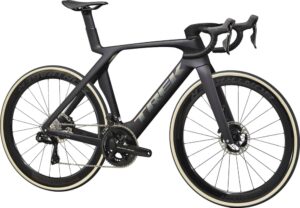
Trek Madone SLR 9 Gen 7
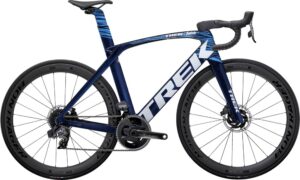
Trek Madone SLR 7 AXS Gen 6

Trek Madone SLR Gen 6 Frameset
More general bikes view all.

Trek Madone SLR 9 eTap

We all know we should ride more and drive less. So what’s stopping you? Norco removes any excuses with the Club. This little workhorse is the bike to have when…

BMC Racemachine RM01 (Ultegra)
BMC’s Racemachine RM01 cuts a dashing figure as you fly through the mountains and emerge from the peloton to take the sprint finish. Its sleek carbon construction is the ideal…
Deals View All
View all deals, recent posts view all.

What is Road Bike Database?
Whether you're a seasoned cyclist or just starting out, choosing the right road bike can…
Send Feedback
Have a suggestion? Looking for a bike that's not on Road Bike Database? Or perhaps you've spotted an error?
We'd love to hear from you. Let us know with the form below.
This website uses cookies to ensure you get the best experience possible. Learn more.
About Road Bike Database
Explore, search and compare thousands of the world’s best road bikes here on Road Bike Database.
Compare prices, components, reviews, images and more on current and past road bikes. You can even share reviews, comments and questions on road bikes. View and compare a huge selection of bikes from brands such as Cervélo , BMC , Trek , Specialized and more .
We strive to provide accurate and up-to-date information for road bikes on Road Bike Database. If you’ve spotted any issues, please let us know . We also include helpful tools, such as our frame size calculator, to assist you in choosing the right road bike. Bear in mind that these tools serve as a guide and simply provide a general indication. Refer to information provided by your bike manufacturer for the most applicable information for your bike.
Bikes By Brand
Bikes by year, bikes by riding style.
- Electric Road
- folding-bike
- general-road
- general-urban
- long-tail-cargo
Bikes By Wheel Size
Popular bikes.
- 2022 Felt IA Advanced Ultegra Di2
- 2023 Gazelle Orange C7+ Low-Step
- 2022 Vitus Substance CRX-1 HT Gravel
- 2022 Orro Venturi STC SRAM Rival Etap Tailor Made
- 2021 Opus ORPHEO 5
- 2021 Cannondale SystemSix Carbon Ultegra Di2
- 2023 Cannondale SuperSix EVO Carbon 105
Latest Bikes
- 2024 Riese & Müller Delite4 GT touring
- 2024 Riese & Müller Delite4 GT rohloff
- 2024 Riese & Müller Delite4 GT rohloff HS
- 2024 Riese & Müller Delite4 GT vario HS
- 2024 Riese & Müller Delite4 GT vario
- 2024 Riese & Müller Delite4 GT touring HS
- 2024 Riese & Müller Roadster4 Mixte vario HS
2-FOR-1 GA TICKETS WITH OUTSIDE+
Don’t miss Thundercat, Fleet Foxes, and more at the Outside Festival.
GET TICKETS
BEST WEEK EVER
Try out unlimited access with 7 days of Outside+ for free.
Start Your Free Trial
Powered by Outside
Bike Check: Mads Pedersen’s Trek Madone SLR at the Tour of Flanders
The danish rider opted for massive chainrings, narrow handlebars, and... tubular tires.
Heading out the door? Read this article on the new Outside+ app available now on iOS devices for members! >","name":"in-content-cta","type":"link"}}'>Download the app .
The Danish star Mads Pedersen has been on a roll this year, outpowering Mathieu van der Poel at the Gent-Wevelgem finish aboard the Trek Madone aero race bike. Trek might have a dedicated classic bike in the Domane, but their aero race provides just enough comfort to make it Pedersen’s go-to ride on most occasions.
Mads Pedersen’s Trek Madone SLR features a SRAM Red eTap AXS drivetrain with a massive 56/43T chainring, Bontrager Aeolus RSL wheels, and Pirelli tubular tires (?!).
See the photo gallery below for Mads Pedersen’s Trek Madone SLR ridden in the Tour of Flanders .
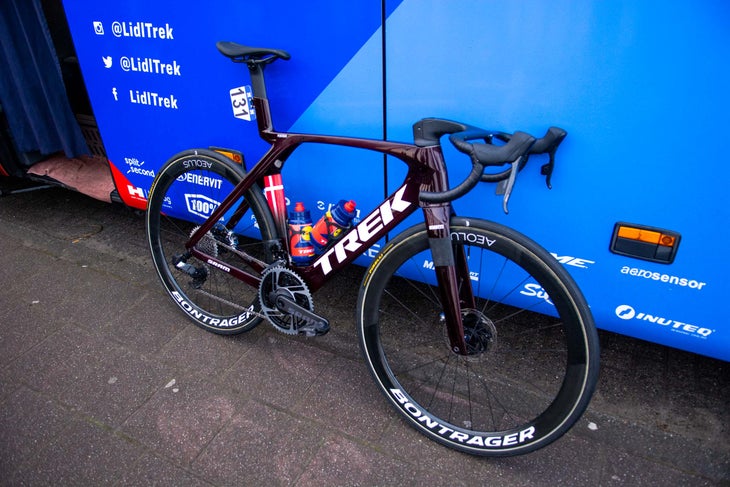
Popular on Velo
What’s it like to be an American cyclist living in France? Watch to get professional road cyclist Joe Dombrowski’s view.
Related content from the Outside Network
One way south, mountain bikers react to their first taste of non-alcoholic craft beer, video review: bmc urs 01 two gravel bike, kiel reijnen vuelta video diary: the painful decision to abandon.

IMAGES
VIDEO
COMMENTS
The new Madone SL Gen 7 offers the same revolutionary road race technology as the the seventh generation Madone SLR at a more accessible price point, thanks to a 500 Series OCLV Carbon frame and a two-piece flared RSL handlebar and stem. It's the ultimate race bike, now available to more riders than ever. Our fastest and lightest Madone SL ever.
Road bikes. Performance road bikes. Madone. Madone delivers a triple threat of unprecedented aerodynamics, exceptional ride quality, and ultra-light weight. And now, thanks to an all-new design and IsoFlow technology, the seventh generation Madone SLR is our fastest road race bike ever. 14 Results.
Madone SL 6 Gen 7. $5,499.99. Model 5298606. Retailer prices may vary. Madone SL 6 offers legendary speed, cutting-edge tech, and unbelievable ride quality in a 500 Series OCLV Carbon package that keeps things light and quick for fast road rides and races. IsoFlow technology smooths out bumps in the pavement while lowering weight and offering ...
These ultra-premium custom bikes are made with cutting-edge components and a seemingly endless palate of exquisite colors, plus paint schemes dreamed up by the most creative designers in the bike industry. Project One bikes are the most premium bikes we offer and our team of master artists and builders are ready to transform your wildest ideas ...
Model 1049618. Retailer prices may vary. Madone SLR 9 Disc is the ultimate aero superbike. An all-new ultralight 800 Series OCLV Carbon frame, adjustable compliance, and a Shimano Dura-Ace Di2 electronic drivetrain make it the final stop in your search for an incredibly fast, top-of-the-line aero road bike. Compare. Color / Navy Carbon Smoke/Blue.
Model 550258. Retailer prices may vary. Madone 9.0 carries forward the same advanced aerodynamic performance and all-around ride quality as other Madone road bike models, but it keeps the price in check with a standard stem and aero bar set up for adjustability. It's the ultimate race bike at our best value, with extraordinary race performance ...
The Trek Madone SL Gen 7, in a way, completes the Madone Gen 7 lineup since, for the last year, if you wanted the latest Madone frame design, you had to shell out over $8000 for an SLR. The differences are subtle, but the most impactful is the new Trek Madone SL Gen 7 uses Trek's 500 series OCLV carbon. Really, that means it is a slightly ...
The updates made to the new 2023 Trek Madone SLR 9 eTap Gen 7 have made it significantly more versatile. It doesn't just look damn fast; it is damn fast, too. And the handling remains responsive at high speeds without lacking in stability. The clever new IsoFlow system reduces the bike's complexity while offering a similar level of compliance.
Lighter than ever. It may not beat the mountain-eating Émonda, but the new Madone has always been plenty snappy on steep gradients, and it's even more so now. The new Madone is around 300 grams lighter than the previous version, again thanks to IsoFlow, as well as our best and lightest OCLV Carbon. Take on your hometown's killer climb (you ...
The entry-level build for the 2023 Madone SLR 6 (with Shimano 105 Di2) comes in at $8,000. That is a $1,100 increase over the 2021 Madone SLR 6 equipped with mechanical-shifting Shimano Ultegra ...
It's a full $1,000 / £1,000 more than the equivalent outgoing Gen 6 Madone SLR 7, and you'd have to look hard to find a more expensive Ultegra Di2-equipped bike from the other mainstream ...
Madone 5.9. Model 14680002111. Retailer prices may vary. Compare. Color / White/Placid Blue. Select a color. Select size. This product is no longer available online, but it could be in stock at your local Trek shop! Check in-store availability below.
The Trek Madone SLR 9 eTap is a cutting-edge aero race bike that features the innovative IsoFlow system, which replaces the IsoSpeed decoupler with a large vent in the seat tube. Find out how this ...
Frame: 2016 Trek Madone 9 Series, H1 geometry, 700-Series OCLV carbon fiber Fork: 2016 Trek Madone KVF Headset: Integrated Cockpit: Trek Madone integrated Bar tape: Bontrager gel cork
The new Trek Madone SL Gen 7 comes in two 12-speed Shimano builds: SL7 with Ultegra and SL 6 with 105. Though the groups and price structure change accordingly, a few specs remain the same throughout. SL 7 and 6 come with the cockpit, the new Bontrager RSL Aero-OCLV Carbon bar, and the RCS Pro - 7° stem. For tires, both roll on Bontrager R3 ...
It was a wonderful bike to ride then, just as it is now. There's very little to distinguish the 2014 Madone 7-Series from the 2013 model from a visual standpoint. The changes to the new Madone are: Lighter Weight: 725gms for 7 Series (56cm frame) with U5 Vapor coat paint (which only adds 5g to the frame - standard paint adds 50-100g to the ...
The new Madone SL Gen 7 offers the same revolutionary road race technology as the seventh-generation Madone SLR at a more accessible price point, thanks to a 500 Series OCLV Carbon frame and a two-piece flared RSL handlebar and stem. It's the ultimate race bike, now available to more riders than ever. Our fastest and lightest Madone SL ever.
A magic carpet ride — if you can fit within the parameters
From a legacy of greatness comes a new standard of speed. Seven generations in the making, Madone is our fastest and lightest Madone disc ever, pushing the b...
The new Madone ditches the pivot and flexing components of IsoSpeed and instead gets a big hole in the seat tube, a host of aero tweaks, new tube profiles, and an entirely new cockpit. All told Trek claims the new seventh-gen Madone is 300 grams lighter and 19 watts (or 60 seconds per hour) faster than the outgoing Madone, all while retaining ...
The main differences between Madone Gen 6 and Gen 7 are that Gen 6 has IsoSpeed decoupler, while Gen 7 has IsoFlow. Gen 7 frames are lighter and 19W faster at 45km/h ( source ). They also look different due to the significant design change. Trek introduced SL 6 and SL 7 Gen 7 with an adjustable cockpit in August 2023.
The updated Madone SL6 comes with a full Shimano Ultegra groupset and Bontrager Carbon Aeolus Comp tubeless wheels. It features the same geometry and IsoSpeed controls of the 2021 model, adding the new BB-T47 and Trek's new Viper Red color scheme. Price: $4700. Sizes: 50, 52, 54, 56, 58, 60, 62.
Otherwise, the differences between the Madone SL and Madone SLR simply boil down to more economical build kits. My Madone SL 7 test sample is the nicer of the two complete Madone SL bikes Trek offers currently, and comes equipped with a complete Shimano Ultegra Di2 2×12 wiredless electronic groupset, Bontrager Aeolus Pro 51 carbon fiber clincher wheels wrapped with 25 mm-wide Bontrager R3 ...
The 2022 Trek Madone SLR 9 comes in sizes 47, 50, 52, 54, 56, 58, 60, 62. After measuring your height, use the size chart below to find the typical Trek Madone SLR 9 size for your height. Remember that these sizes are a general guide and bike sizes can vary between riders and bikes. The best way to find your size is to go for a test ride.
The 2023 Trek Madone SL 7 comes in sizes 50cm, 52cm, 54cm, 56cm, 58cm, 60cm, 62cm. After measuring your height, use the size chart below to find the typical Trek Madone SL 7 size for your height. Remember that these sizes are a general guide and bike sizes can vary between riders and bikes. The best way to find your size is to go for a test ride.
The 2022 Trek Madone SL 6 comes in sizes 47, 50, 52, 54, 56, 58, 60, 62. After measuring your height, use the size chart below to find the typical Trek Madone SL 6 size for your height. Remember that these sizes are a general guide and bike sizes can vary between riders and bikes. The best way to find your size is to go for a test ride.
Mads is aboard the latest Trek Madeon SLR, featuring a SRAM Red eTap AXS drivetrain with the same shifter design that was first released all the way back in 2015. (Photo: Will Tracy/Velo) Pedersen's bike features the Madone one-piece handlebar with TT tape. The 130 mm length stem is perfect for a cue card. (Photo: Will Tracy/Velo)